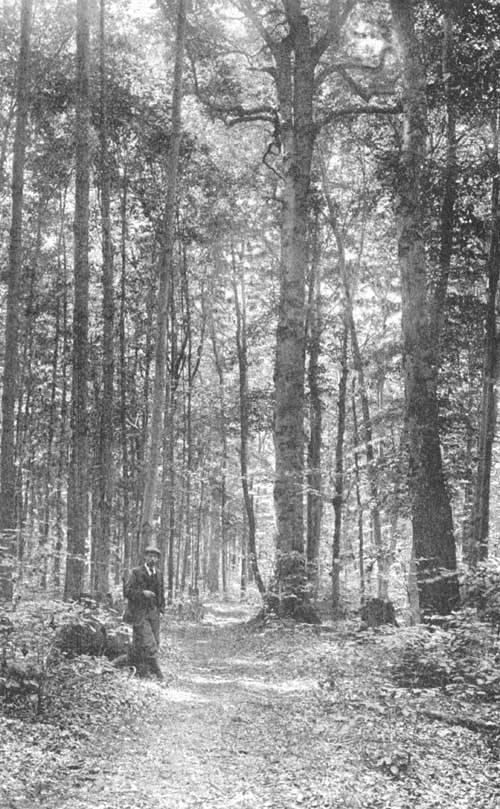
A SOUTHERN MICHIGAN WOODLOT
| NEW SERIES, | SEPTEMBER, 1915 | VOL. XVII, NO. 10 |
| PAGE | |
| A Southern Michigan Woodlot—Frontispiece. | |
| Map of Michigan (Showing Details Mentioned in the Bulletin) | iv |
| Introduction | v |
| Acknowledgments | vii |
| How to Study the Trees | ix |
| Artificial Keys, How Made and Used | xviii |
| Summer Key to the Genera | xxi |
| Winter Key to the Genera | xxvii |
| Manual of Trees (Description of Species, with Summer and Winter Keys to the Species) | 1 |
| GINKGOACEAE | 2 |
| PINACEAE | 4 |
| SALICACEAE | 34 |
| JUGLANDACEAE | 60 |
| BETULACEAE | 80 |
| FAGACEAE | 92 |
| URTICACEAE | 122 |
| MAGNOLIACEAE | 136 |
| LAURACEAE | 138 |
| PLATANACEAE | 140 |
| ROSACEAE | 142 |
| LEGUMINOSAE | 162 |
| SIMARUBACEAE | 170 |
| ACERACEAE | 172 |
| SAPINDACEAE | 194 |
| TILIACEAE | 200 |
| CORNACEAE | 202 |
| OLEACEAE | 210 |
| BIGNONIACEAE | 222 |
| CAPRIFOLIACEAE | 228 |
| Glossary | 231 |
| Index to the Artificial Keys | 241 |
| Index to the Trees | 242 |
The idea of a bulletin on Michigan trees was first suggested by Prof. Volney M. Spalding. It was thought that a bulletin devoted entirely to the study of certain phases of tree life in Michigan would stimulate interest in the study of our trees, and influence many more people to associate themselves with the growing number of tree lovers and with the supporters of the movement for better forest conditions in the state.
The bulletin has been under consideration for a number of years and much of the material given herein has been used in the classes in forest botany at the University of Michigan. It remained, however, for the present Curator of the Botanical Garden and Arboretum to get the material into shape for publication, and the present bulletin is the result of his industry and perseverance. The preparation of the drawings and manuscript has been made by him in connection with his work in the Garden.
The distinctive feature of the bulletin lies in its keys. The keys commonly published are based upon characters which are present but a short time during the year, or which can be used only by an advanced student of botany. This bulletin presents two keys. One is based upon characters which are present all summer; the other uses the winter characters as a basis for identification. By the use of the keys any person should be able to name and learn the characteristics of the trees of Michigan at any time of the year. These keys should prove of special value to our students in the public schools, to members of nature study clubs, and to the students in the forestry schools of the state.
The order of arrangement and the nomenclature are essentially those of “Gray’s New Manual of Botany.” Following a tendency which is steadily gaining favor, all species names are printed with a small letter, regardless of their origin. For the convenience of the general reader, other scientific names which are found in botanical manuals in common use are printed in [Pg vi] parenthesis. In the case of exotics which are not included in the Manual, other authorities have been followed. Sudworth’s “Check List of the Forest Trees of the United States” (U. S. Dept. Agr., Div. Forestry, Bul. 17) is in most cases authority for the common names. They are names appearing in common use today in some part of the state. The first name given is that recommended by Sudworth for general use.
The drawings have been made from living or herbarium material and are original. They are accurately drawn to a scale, which is given in each case. In their preparation the author has endeavored to call attention to the salient characters. In the drawings of buds and twigs certain points, bundle-scars, etc., have been emphasized more than is natural. In the descriptions the attempt has been made to bring out those points of similarity and contrast which are most useful for identification.
As the bulletin is not written especially for technical students of botany, the author thought best to use as few technical terms as possible in the descriptions. In some cases it was impossible to avoid such terms, but with the help of the glossary the meaning can be easily understood. Any person desiring to get a more complete knowledge of trees should consult one of the larger manuals. The arrangement used for the illustration and discussion of each single tree makes it possible for the student to compare the drawings with the description without turning a page.
It is believed that with the aid of the drawings and descriptions given in this bulletin any person will be able to name the trees which grow in his yard, park, or woodlot. If, however, any difficulty is found in naming the trees, the Curator will be glad to name any specimens which may be mailed to him. He would be glad to get in touch with persons interested in Michigan trees and to receive any additional information relating to the subject. Data concerning the distribution of the trees in the state, and the addition of other Michigan trees to the present list would be of especial value.
George Plumer Burns.
Grateful acknowledgment is hereby made to Miss Sarah Phelps, who has done most of the inking in and given life to the author’s pencil-drawings; to Mr. J. H. Ehlers for his valuable assistance in the preparation of many of the drawings and in the collection of working material; to Prof. Henri Hus, who has read all of the proof and who has at various times rendered valuable assistance; to Prof. F. C. Newcombe and to Prof. Ernst Bessey for the loan of sheets, from the herbariums of the University of Michigan and Michigan Agricultural College; and especially to Prof. Geo. P. Burns in whose inspiration this bulletin had its inception and under whose direction the work has progressed to completion.
Chas. H. Otis.
People are everywhere associated with trees. Trees give cooling shade in our parks and dooryards and along our highways; they lend their beauty to the landscape and relieve it of monotony; they yield many kinds of fruits, some of which furnish man and the animals of the forest with food; and they furnish vast quantities of lumber for a multitude of uses. How important it is, then, that every person, whether school-child or grown-up, should become acquainted with our trees. Most people know a few of our commonest trees, but are ignorant of the great wealth of tree forms about them. Some who may have wished to go further have been hindered for lack of a teacher or dismayed by the very multitude of manuals to which they have had access.
In beginning a study of the trees the student should start on a solid foundation, eliminating the uncertainties and the errors which no doubt have appeared and retaining only the established facts. Once started he should go slowly, assimilating each new discovery before seeking another. He should begin with the trees nearest home, and, as he gradually grows to know these in all their aspects, should extend his trips afield. Not only should he be able to name the trees when they are fully clothed in their summer dress, but he should as readily know these same trees when the leaves have fallen and only the bare branches stand silhouetted against the sky. Then, and only then, will he derive the utmost satisfaction from his efforts.
The characters which are used in studying the trees are habit, leaves, flowers, fruit, buds, bark, distribution and habitat. These will be discussed briefly in the next few pages, the same order that is used in the detailed descriptions of species being [Pg x] maintained in the present discussion. A few drawings will also be added to make clear certain points and to show comparative forms.
NAME.—Every tree has one or several common names and a scientific or Latin name. Some of these common names are merely local, others have a more extended use. Some few names apply to totally different species. Thus, Cottonwood in Michigan is Populus deltoides, in Idaho and Colorado Populus angustifolia, in California Populus fremontii and in Kentucky Tilia heterophylla. While it should not be forgotten that in common speech it is proper as well as convenient to call trees by their common names, yet, in view of the many uncertainties pertaining to their use, a scientific name is at times absolutely essential to the clear understanding of what is meant. Latin is the language in universal use by all scientists. No longer used by any civilized nation, it has become a dead language and consequently never changes. Its vocabulary and its constructions will a thousand years hence be the same as they are today. Being in universal use among scientists of all nationalities no confusion arises from the use of a Latin word. The Oak in Germany is known as Eiche, in France as chêne and in Spain as roble, but the Latin word Quercus is the same for all these countries.
A scientific name as applied to trees consists of at least two parts, as Quercus alba; the first named is the genus and is always written with a capital letter, the second is the species and is written with a small letter, the two names constituting the briefest possible description of the particular tree. It is customary to add to these the name or an abbreviation of the name of the person who first gave the name to the tree, as Quercus alba L., the abbreviation standing for Linnaeus. Sometimes a third name is used, as Acer saccharum nigrum, referring in this case to a variety of the ordinary Sugar Maple.
Genera which bear a relationship to each other are placed in the same family, the family name always having the characteristic ending—aceae. Related families are again grouped into orders, with the characteristic ending—ales. Orders are in like manner arranged into larger groups, called classes, and the latter into still larger groups, divisions, etc., each with its characteristic ending. Thus, Acer saccharum nigrum (Michx. f.) Britt. is classified as follows:
Division—Spermatophyta
Subdivision—Angiospermae
Class—Dicotyledoneae
Order—Sapindales
Family—Aceraceae
Genus—Acer
Species—saccharum
Variety—nigrum.
HABIT.—Habit, or the general appearance of a plant, is an important character of identification, especially as we become more and more familiar with the trees. Two main types are recognized, based on the manner of branching of the trunk, the upright and the spreading. In the one the trunk extends straight upwards without dividing, as is typical in most of the conifers, and in the other the trunk divides to form several large branches and the broad, spreading crown of most of our broad-leaf trees. The crown in either case may be regular in outline or very irregular, straggling or straight-limbed. Moreover, the tree growing in the open, where there is no crowding and there is plenty of light, may differ very greatly from the tree in the forest, where the struggle for existence becomes very keen. A short, thick trunk and low, spreading, many-branched crown characterizes the tree in the open, whereas the forest tree has a long, slender, clean trunk and a narrow crown of few branches. In the descriptions of trees in this bulletin, unless otherwise stated, the habit in the open is the one given. Again, the tree may have been injured by storm or insect at some period of its growth and its natural symmetry destroyed. Moreover, the age of a tree has a great influence on its outline, young trees being generally narrow and more or less conical, broadening out as they become older. We may say, then, that each tree has an individuality of its own, little eccentricities similar to those that make people different from one another. And just as we have little difficulty in recognizing our friends at a distance by some peculiarity of walk or action, so are we able to recognize a great many trees at a distance by some peculiarity of form or habit.
I. LEAF OUTLINES
 |
 |
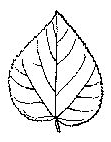 |
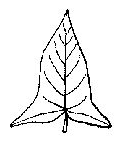 |
 |
|
| Lanceolate. | Ovate. | Heart-shaped. | Halberd-shaped. | Linear. | Elliptical. |
 |
 |
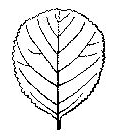 |
 |
 |
 |
| Oblong. | Oval. | Orbicular. | Oblanceolate. | Spatulate. | Obovate. |
II. LEAF TIPS
 |
 |
 |
 |
 |
| Acuminate. | Acute. | Obtuse. | Emarginate. | Mucronate. |
LEAVES.—With the advent of spring the buds of our broad-leaf trees swell and burst and the leaves come forth and clothe the trees with mantles of green, hiding the branches which have been bare through the cold winter months. The evergreens, too, [Pg xii] take on new color and begin a new period of growth. It is the leaves which the beginner finds most interesting and in which he finds a ready means of identification. It must be remembered, however, that leaves vary greatly in size and shape and general appearance. How large are the leaves on a flourishing sprout and how small on a stunted tree of the same species growing near by, but under adverse circumstances. How different are the leaves of the big white oak standing in the yard; they are hardly lobed on the lowermost branches, while higher up they are deeply cut. Yet, in spite of the many modifications that leaves undergo, the leaves of any one species have certain rather constant characters which are found in all forms, and the student will have little difficulty in selecting and recognizing typical leaves.
III. LEAF MARGINS
Leaves are either persistent, as in most of our conifers, which stay green all winter, or they turn various colors with the frost and fall early in autumn; often they hang dead and lifeless far into the winter. The points about leaves which we are accustomed to consider are the position or arrangement of the leaves on the branch, whether simple or compound, size, shape, texture, color, amount and character of pubescence, character of the margin, venation, etc. The following diagrams will serve to illustrate some of the ordinary forms and shapes of leaves, their margins, etc.
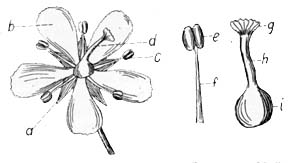
Perfect Flower. Stamen. Pistil.
| a. Sepal (Calyx). | f. Filament. |
| b. Petal (Corolla). | g. Stigma. |
| c. Stamen. | h. Style. |
| d. Pistil. | i. Ovary. |
| e. Anther. |
FLOWERS.—Every tree when old enough bears flowers in its proper season. Some of these, as the Catalpas, Locusts and Horse-chestnuts are very showy, others, like the Oaks and Hickories, are comparatively inconspicuous; some are brilliantly colored, others are of the same color as the leaves. Nevertheless, the flowers are very accurate means of classification, and their only drawback is that they last for such a short period of time each year.
Just as we have male and female in the animal world, so we have male and female in the plant world. A few of our trees, as the Locust, Basswood and Cherries have perfect flowers, bearing both stamens and pistil. The great majority, however, have unisexual flowers, bearing stamens or pistils, but not both. When both male and female flowers are found on the same tree, the flowers are said to be monoecious, and when male flowers occur on one tree and the female on a different tree, the flowers are said to be dioecious. The Cottonwood is dioecious, and the little seeds are surrounded by a tuft of long, white hairs which enables the wind to carry them to considerable distances from the parent tree, to the disgust of people living within range. Many cities forbid the planting of Cottonwood on account of the “cotton.” Since in some cases it is desirable to plant this rapid-growing tree, as in cities burning large amounts of soft coal, it is a distinct advantage to know that male trees are lacking in the objectionable “cotton” and may be planted safely.
V. TYPES OF INFLORESCENSES
 |
 |
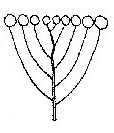 |
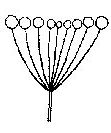 |
 |
|
| Spike. | Raceme. | Panicle. | Corymb. | Umbel. | Cyme. |
Before trees can produce fruit their flowers must be fertilized, i.e., pollen from the anther of a stamen must come in contact with the stigma of a pistil. Some flowers are self-fertilized, others are cross-fertilized. For a long time it was not known how fertilization was accomplished, but now we know that many insects, like the nectar-loving bees and butterflies, and in other cases the wind transport the pollen from one flower to another, often miles being traversed before the right kind of flower or a flower in the right stage of development is found. And many are the modifications of flowers to insure this transference of pollen.
FRUIT.—So numerous and so varied are the forms of tree fruits that it would only be confusing to enumerate their various characters. Some fruits, as the achenes of the Poplars and Willows, [Pg xv] are so small and light that they are carried long distances by the wind; others, like the hickory nuts and walnuts, are too heavy to be wind-blown. Many fruits are of considerable economic and commercial importance and are gathered and marketed on a large scale; such are the hickory nuts, walnuts, chestnuts, etc. Some, not esteemed by man, form an important article of diet for the birds and small animals of the forest. Unfortunately, there are a number of limitations to the usefulness of fruit for identification purposes. Some trees require years to mature their fruit. Many trees, while producing an abundance of fruit at certain intervals, bear none at all or only very small and uncertain quantities between the years of abundance. Again, in the case of dioecious trees, only the female or pistillate bear fruit. Notwithstanding these limitations tree fruits are a very valuable aid to the student, and he should always search closely for evidences of their presence and character.
WINTER-BUDS.—Buds, with their accompanying leaf-and stipule-scars form the basis of tree identification in winter. The size, color, position with reference to the twig, number and arrangement and character of bud-scales, etc., are all characters of the greatest value in winter determinations. Buds are either terminal or lateral, depending on their position on the twig. A lateral bud is one situated on the side of a twig in the axil of a leaf-scar. A terminal bud is one situated at the end of a twig, where it is ready to continue the growth of the twig the following spring. In the keys an important consideration is the presence or absence of the terminal bud. Inasmuch as the determination of this point gives the beginner some trouble at first, it is hoped that the accompanying diagrams and explanatory remarks will make the distinction clear.
In the Elms, Willows, Basswood and many other species the terminal bud and a small portion of the tip of the twig dies and drops off in late autumn, leaving a small scar at the end of the twig (a, fig. VI). The presence of this tip-scar indicates that the terminal bud is absent. Often a lateral bud will be found very close to the tip-scar (b, fig. VI), which, bending into line with the twig, makes it appear terminal. However, the presence of a leaf-scar immediately below it shows it to be a lateral bud (c, fig. VI). In some large twigs the eye unaided will serve to find the tip-scar, but with the smaller twigs a hand-lens is necessary.
The arrangement, size and shape of the leaf-scars (c, fig. VII) are important factors in identification by winter characters. Within the leaf-scars are one or more dots (d, fig. VII), sometimes quite inconspicuous, often very prominent. These are the scars left by the fibro-vascular bundles which run through the petiole into the blade of the leaf, and are designated as bundle-scars. There may be only one as in Sassafras and Hackberry, two as in Ginkgo, three as in the Poplars and Cherries, or many; and they may be arranged in a U- or V-shaped line, or they may be without definite order. Often stipule-scars (d, fig. VI) occur on either side of the leaf-scar; these are scars left by the fall of a pair of small leaflets called stipules and located at the base of the leaves, and their form varies according to the form of the stipules which made them.
BARK.—The woodsman uses the bark of a tree more than any other character in distinguishing the trees about him, and he is often able to use this character alone with much accuracy at great distances. However, the appearance of bark differs so greatly with the age of the tree and with its environment that [Pg xvii] it is difficult to describe it accurately. Some characters are distinctive, however, and serve as a ready means of identification; such characters are the peeling of the Sycamore and Paper Birch, the “shagging” of the Shagbark Hickory, the spicy taste of Sassafras bark and the mucilaginous inner bark of the Slippery Elm.
WOOD.—It is not expected that the information given under this heading will be of any particular value in identifying living trees. Often, however, the student finds himself in the midst of felling operations, when the information concerning the wood is of considerable value.
DISTRIBUTION AND HABITAT.—To a lesser extent do distribution and habitat of a species aid in the identification of a tree. It is a distinct aid to know that the Chestnut is native in south-eastern Michigan only and that the Mountain Ash does not extend south of Ludington. So too, knowing the water-loving habit of the Swamp White Oak, we would not expect to find this same tree flourishing on the top of a hard, dry hill.
The characters, then, which are used to identify the trees about us are many. Not all will be available at any one time, not all have been mentioned in the foregoing pages nor in the manual. It is our opinion, however, that the student will not be greatly handicapped by this lack of detail, but rather that he will take great interest and genuine pleasure in discovering these things for himself.
An artificial key is a scheme for easily and quickly identifying any unknown object under consideration. This bulletin being devoted to the trees of Michigan, the keys to be found herein are intended to make it possible for any person, even if his botanical training be meager, to determine what trees grow about any home or farm, city park or woodlot in the state. With certain modifications and limitations they may prove useful in other localities as well. Since many people are unfamiliar with the construction and use of keys for identification, it will be the purpose of the following paragraphs to briefly outline the principles of construction and the manner of using the keys to be found here.
The keys are based on the most striking similarities and differences which the various parts of trees—twigs, buds, leaves, etc.—show, i. e., those characters which stand out in bold relief, which catch the eye at first sight. Two alternatives are presented, either a character is or is not present; these are the only choices possible. Indeed, further divisions are unnecessary and only lead to confusion and possible oversight. The two diametrically opposed characters are said to be coördinate in rank. In the keys they are preceded by the same letter or letters (a and aa or b and bb, etc.) and are set at the same distance from the left margin of the page. Often a and aa, or b and bb are further divisible into other groups; in every case the characters are opposed (a positive and a negative) and are given coördinate rank. It is desirable for mechanical reasons to divide the main divisions of the key more or less evenly, but this is not always feasible, nor should it be religiously adhered to.
Suppose as a concrete example that it is desired to construct a key to distinguish five houses in a city block. Three of these are of wood construction, two are of brick, and of the two wooden houses one is painted white and one brown. We may classify them as follows:
| a. | Houses wood. | |||
| b. | Body paint brown. | Smith’s house | ||
| bb. | Body paint white. | |||
| c. | Trimmings green color. | Jones’ house | ||
| cc. | Trimmings slate color. | Brown’s house | ||
| aa. | Houses brick. | |||
| b. | Roof gray slate. | Johnson’s house | ||
| bb. | Roof red tile. | Public Library | ||
It is desirable in many cases to add other characters to lessen the liability of confusion, where the characters chosen are not distinct, and to show the user that he is on the right track. Thus, in the example just given, green color and slate color under certain defects of the eye, a coating of dust or deficiencies of the light might be confused, under which circumstances we would be justified in adding to the above statements without the criticism of description being made. Thus:
| bb. | ||||
| c. | Trimmings green color; gable roof. | Jones’ house | ||
| cc. | Trimmings slate color; mansard roof. | Brown’s house | ||
The keys in this bulletin are constructed on the above principles. They are not in all cases as simple as the illustration just used, but if the reader has mastered the house illustration he will have little or no trouble with the larger keys. Suppose that (during a summer stroll) you come across a large tree with rough, hard bark and thin, lobed leaves which you do not know. Turning to the Summer Key to the Genera you find first a. Leaves simple, and contrasted with this aa. Leaves compound. Obviously the leaf is simple and the genus sought lies in that portion of the key preceding aa, i.e., under a. b and bb under a give you a choice between Leaves needle-shaped, awl-shaped, strap-shaped or scale-like and Leaves broad and flat. The leaf being broad and flat you pass to c and cc under bb. Here you have a choice between Leaves alternate or clustered and Leaves opposite or whorled. Inspection shows the arrangement to be opposite, and you know that the genus sought lies in that portion of the key between cc and aa. Passing to d and dd under cc gives the choice between Margin of leaves entire or only slightly undulate and Margin of leaves serrate to lobed. The [Pg xx] leaf is deeply lobed. It is then either a Viburnum or an Acer, and the fact that the leaf-margin is lobed and not finely serrate brings the chase down to Acer. Before going further go back over the key and make careful note of the particular characters which were used to separate this genus from the other genera and try to fix these in mind. This done, turn to the page indicated, where you will find a Summer Key to the Species of Acer. You run through this key in the same manner that you did the genus key. If you have been careful in your search you will finally stop at Acer saccharum. Once more pause and go back over this key and try to fix in mind the characters which were used to separate the various species, especially the difference between your tree and Acer platanoides, which it so closely resembles. This done, turn to the page indicated and compare the characters of your tree with the drawings and descriptions. If you are satisfied with your diagnosis, well and good. If you find that you are wrong, go over the keys again and find wherein you were led astray.
Before you leave the tree take a sample of leaf properly labeled which you can press between the pages of an old magazine and save for future reference. Do this with other trees which you may find and when you get home lay them out side by side so that the labels will not show and compare them. A few trials of this kind will serve to form a mental picture of each leaf which you will remember.
A very helpful practice for the beginner is that of making keys based upon various characters. Practice keys of this kind will bring out the differences and likenesses of trees as will no other means, and characters which have hitherto escaped the eye will be prominently brought forward. Nor should the student take his characters from books, but rather should he go to the woods and get his knowledge first hand.
It is hardly necessary to state that the key is a valuable crutch while learning to walk, but once the leg is strong enough to bear the weight it should be discarded, lest it become a burden. A key has for its main object the guidance of the student through the preliminary steps leading to a more intimate knowledge of the trees. When once he knows a tree, instinctively, because of long acquaintance with it, just as he knows people, then the need for a key will have ceased.
| a. | Leaves simple. | |||||||||||||||
| b. | Leaves needle-shaped, awl-shaped, strap-shaped or scale-like. | |||||||||||||||
| c. | Leaves in clusters of 2-many. | |||||||||||||||
| d. | Leaves in clusters of 2-5, sheathed, persistent for several years. | PINUS, p. 4. | ||||||||||||||
| dd. | Leaves in fascicles of 8-many, on short, lateral branchlets, deciduous in autumn. | LARIX, p. 17. | ||||||||||||||
| cc. | Leaves solitary, not clustered. | |||||||||||||||
| d. | Leaves opposite. | |||||||||||||||
| e. | Twigs flattened; leaves all of one kind, scale-like, decurrent on the stem; fruit a small, pale brown cone. | THUJA, p. 31. | ||||||||||||||
| ee. | Twigs essentially terete; leaves of two kinds, either scale-like, or else awl-shaped, often both kinds on the same branch, not decurrent on the stem; fruit berry-like, bluish. | JUNIPERUS, p. 33. | ||||||||||||||
| dd. | Leaves alternate or spirally-whorled. | |||||||||||||||
| e. | Leaves flattened, soft to the touch. | |||||||||||||||
| f. | Leaves 1/2-1-1/4 inches long, sessile, aromatic; cones 2-4 inches long; bark of trunk with raised blisters containing resin. | ABIES, p. 27. | ||||||||||||||
| ff. | Leaves seldom over 1/2 inch long, short-petioled, not aromatic; cones about 3/4 inch long; bark of trunk without raised blisters. | TSUGA, p. 29. | ||||||||||||||
| ee. | Leaves 4-sided, harsh to the touch. | PICEA, p. 18. | ||||||||||||||
| bb. | Leaves broad and flat. | |||||||||||||||
| c. | Leaves alternate or clustered, never opposite nor whorled. | |||||||||||||||
| d. | Margin of leaves entire or only slightly undulate. | |||||||||||||||
| e.[Pg xxii] | Leaves heart-shaped or rounded; fruit a legume. | CERCIS, p. 167. | ||||||||||||||
| ee. | Leaves oval, ovate or obovate; fruit not a legume. | |||||||||||||||
| f. | Branches armed with stout, straight spines; fruit large, orange-like. | MACLURA, p. 133. | ||||||||||||||
| ff. | Branches without spines; fruit small, not orange-like. | |||||||||||||||
| g. | Fruit an acorn. | QUERCUS, p. 96. | ||||||||||||||
| gg. | Fruit a drupe or berry. | |||||||||||||||
| h. | Twigs spicy-aromatic when bruised; leaves of many shapes on the same branch. | SASSAFRAS, p. 139. | ||||||||||||||
| hh. | Twigs not spicy-aromatic; leaves not of many shapes on the same branch. | |||||||||||||||
| i. | Leaves thick, abruptly pointed, very lustrous above, not clustered at the ends of the branches. | NYSSA, p. 209. | ||||||||||||||
| ii. | Leaves thin, long-pointed, not lustrous above, clustered at the ends of the branches. | CORNUS, p. 202. | ||||||||||||||
| dd. | Margin of leaves serrate, toothed or lobed. | |||||||||||||||
| e. | Margin of leaves serrate to toothed. | |||||||||||||||
| f. | Branches armed with stiff, sharp thorns. | CRATAEGUS, p. 151. | ||||||||||||||
| ff. | Branches not armed. | |||||||||||||||
| g. | Base of leaves decidedly oblique. | |||||||||||||||
| h. | Leaf-blades about as long as they are broad, heart-shaped. | TILIA, p. 201. | ||||||||||||||
| hh. | Leaf-blades 1-1/2 - 2 times as long as they are broad, oval to ovate. | |||||||||||||||
| i. | Leaves thin, coarsely but singly serrate; fruit a globular drupe, ripe in autumn. | CELTIS, p. 131. | ||||||||||||||
| ii; | Leaves thick, coarsely and doubly serrate; fruit a samara, ripe in spring. | ULMUS, p. 122. | ||||||||||||||
| gg. | Base of leaves essentially symmetrical. | |||||||||||||||
| h. | Teeth coarse, 2-5 per inch of margin. | |||||||||||||||
| i. | Leaves very glabrous both sides; fruit a prickly bur. | |||||||||||||||
| j.[Pg xxiii] | Leaves 3-5 inches long, very lustrous beneath; bark close, smooth, steel-gray. | FAGUS, p. 93. | ||||||||||||||
| jj. | Leaves 6-8 inches long, not lustrous beneath; bark fissured, brownish. | CASTANEA, p. 95. | ||||||||||||||
| ii. | Leaves pubescent or white-tomentose, at least beneath; fruit not a prickly bur. | |||||||||||||||
| j. | Leaves 2-4 inches long, broadly ovate to suborbicular; fruit a very small capsule, falling in spring. | POPULUS, p. 44. | ||||||||||||||
| jj. | Leaves 4-7 inches long, oblong-lanceolate to obovate; fruit an acorn, falling in autumn. | QUERCUS, p. 96. | ||||||||||||||
| hh. | Teeth fine, 6-many per inch of margin. | |||||||||||||||
| i. | Leaf-petioles laterally compressed; leaves tremulous. | POPULUS, p. 44. | ||||||||||||||
| ii. | Leaf-petioles terete; leaves not tremulous. | |||||||||||||||
| j. | Leaf-blades at least 3 times as long as they are broad. | |||||||||||||||
| k. | Twigs brittle; fruit a very small capsule, falling in spring. | SALIX, p. 34. | ||||||||||||||
| kk. | Twigs tough; fruit a fleshy drupe, falling in late summer or autumn. | PRUNUS, p. 152. | ||||||||||||||
| jj. | Leaf-blades not more than twice as long as they are broad. | |||||||||||||||
| k. | Leaf-blades about twice as long as they are broad. | |||||||||||||||
| l. | Margin of leaves singly serrate; fruit fleshy. | |||||||||||||||
| m. | Lenticels conspicuous; pith whitish or brownish; bark easily peeled off in papery layers; buds ovoid. | PRUNUS, p. 152. | ||||||||||||||
| mm. | Lenticels inconspicuous; pith greenish; bark not separable into papery layers; buds narrow-conical. | AMELANCHIER, p. 149. | ||||||||||||||
| ll. | Margin of leaves doubly serrate; fruit not fleshy. | |||||||||||||||
| m.[Pg xxiv] | Trunk fluted; fruit inclosed within a halberd-shaped involucre. | CARPINUS, p. 83. | ||||||||||||||
| mm. | Trunk not fluted; fruit not inclosed within a halberd-shaped involucre. | |||||||||||||||
| n. | Bark of trunk gray-brown, broken into narrow, flattish pieces loose at the ends; fruit in hop-like strobiles. | OSTRYA, p. 81. | ||||||||||||||
| nn. | Bark of trunk white, yellow or dark brown, platy or cleaving off in papery layers; fruit not in hop-like strobiles. | BETULA, p. 84. | ||||||||||||||
| kk. | Leaf-blades almost as broad as they are long. | |||||||||||||||
| l. | Lower side of leaves more or less downy; sap milky; leaves not crowded on short, spur-like branchlets; fruit berry-like, black. | MORUS, p. 135. | ||||||||||||||
| ll. | Lower side of leaves glabrous; sap not milky; leaves crowded on short, spur-like branchlets; fruit a large, green pome. | PYRUS, p. 142. | ||||||||||||||
| ee. | Margin of leaves distinctly lobed. | |||||||||||||||
| f. | Fruit an acorn. | QUERCUS, p.96. | ||||||||||||||
| ff. | Fruit not an acorn. | |||||||||||||||
| g. | Leaves fan-shaped, with many fine veins radiating from the base of the blade. | GINKGO, p. 3. | ||||||||||||||
| gg. | Leaves not fan-shaped, without many fine veins radiating from the base of the blade. | |||||||||||||||
| h. | Leaf-lobes entire. | |||||||||||||||
| i. | Leaf-petioles 5-6 inches long; leaves lustrous above; twigs not aromatic when bruised. | LIRIODENDRON, p. 137. | ||||||||||||||
| ii. | Leaf-petioles about 1 inch long; leaves dull above; twigs spicy-aromatic when bruised. | SASSAFRAS, p. 139. | ||||||||||||||
| hh. | Leaf-lobes sinuate-toothed to serrate. | |||||||||||||||
| i.[Pg xxv] | Leaf-lobes coarsely sinuate-toothed. | PLATANUS, p. 141. | ||||||||||||||
| ii. | Leaf-lobes serrate. | |||||||||||||||
| j. | Branches armed with stiff, sharp thorns; sap not milky. | CRATAEGUS, p. 151. | ||||||||||||||
| jj. | Branches unarmed; sap milky. | MORUS, p. 135. | ||||||||||||||
| cc. | Leaves opposite or whorled. | |||||||||||||||
| d. | Margin of leaves entire or only slightly undulate. | |||||||||||||||
| e. | Leaves 3-5 inches long; spray fine; fruit an ovoid, scarlet drupe. | CORNUS, p. 202. | ||||||||||||||
| ee. | Leaves 5-12 inches long; spray coarse; fruit a long, slender-cylindrical capsule. | CATALPA, p. 222. | ||||||||||||||
| dd. | Margin of leaves serrate to lobed. | |||||||||||||||
| e. | Margin of leaves finely serrate. | VIBURNUM, p. 229. | ||||||||||||||
| ee. | Margin of leaves distinctly lobed. | ACER, p. 172. | ||||||||||||||
| aa. | Leaves compound. | |||||||||||||||
| b. | Leaves alternate. | |||||||||||||||
| c. | Leaves simple-pinnate. | |||||||||||||||
| d. | Branchlets armed with short, sharp prickles. | ROBINIA, p. 169. | ||||||||||||||
| dd. | Branchlets unarmed. | |||||||||||||||
| e. | Leaflets entire with the exception of 2 or more coarse, glandular teeth at the base. | AILANTHUS, p. 171. | ||||||||||||||
| ee. | Leaflets serrate the entire length. | |||||||||||||||
| f. | Upper leaflets less than 1 inch broad. | |||||||||||||||
| g. | Trunk and large branches armed with stout spines; leaflets 3/4-1-1/2 inches long. | GLEDITSIA, p. 165. | ||||||||||||||
| gg. | Trunk and large branches unarmed; leaflets 2-3 inches long. | PYRUS, p. 142. | ||||||||||||||
| ff. | Upper leaflets 1-5 inches broad. | |||||||||||||||
| g. | Leaflets 5-11; pith homogeneous. | CARYA, p. 66. | ||||||||||||||
| gg. | Leaflets 11-23; pith chambered. | JUGLANS, p. 60. | ||||||||||||||
| cc. | Leaves bi-pinnate. | |||||||||||||||
| d.[Pg xxvi] | Trunk and large branches armed with stout spines; leaflets 3/4 - 1-1/2 inches long. | GLEDITSIA, p. 165. | ||||||||||||||
| dd. | Trunk and large branches unarmed; leaflets 2 - 2-1/2 inches long. | GYMNOCLADUS, p. 163. | ||||||||||||||
| bb. | Leaves opposite. | |||||||||||||||
| c. | Leaves pinnately compound; fruit a samara. | |||||||||||||||
| d. | Leaflets 3-5; samaras paired. | ACER, p. 172. | ||||||||||||||
| dd. | Leaflets 7-11, exceptionally 5; samaras not paired. | FRAXINUS, p. 210. | ||||||||||||||
| cc. | Leaves digitately compound; fruit a prickly bur. | AESCULUS, p. 194. | ||||||||||||||
| a. | Leaves persistent and green throughout the winter, needle-shaped, awl-shaped or scale-like. | ||||||||||||||
| b. | Leaves in clusters of 2-5, sheathed. | PINUS, p. 5. | |||||||||||||
| bb. | Leaves solitary, not clustered. | ||||||||||||||
| c. | Leaves opposite. | ||||||||||||||
| d. | Twigs flattened; leaves all of one kind, scale-like, decurrent on the stem; fruit a small, pale brown cone. | THUJA, p. 31. | |||||||||||||
| dd. | Twigs essentially terete; leaves of two kinds, either scale-like, or else awl-shaped, often both kinds on the same branch, not decurrent on the stem; fruit berry-like, bluish. | JUNIPERUS, p. 33. | |||||||||||||
| cc. | Leaves alternate or spirally-whorled. | ||||||||||||||
| d. | Leaves flattened, soft to the touch. | ||||||||||||||
| e. | Leaves 1/2 - 1-1/4 inches long, sessile, aromatic; cones 2-4 inches long; bark of trunk with raised blisters containing resin. | ABIES, p. 27. | |||||||||||||
| ee. | Leaves seldom over 1/2 inch long, short-petioled, not aromatic; cones about 3/4 inch long; bark of trunk without raised blisters. | TSUGA, p. 29. | |||||||||||||
| dd. | Leaves 4-sided, harsh to the touch. | PICEA, p. 19. | |||||||||||||
| aa. | Leaves not persistent and green throughout the winter, but deciduous in early autumn. | ||||||||||||||
| b. | Twigs, branches or trunks armed with stiff, sharp prickles, spines or thorns. | ||||||||||||||
| c. | Thorns or spines not exceeding 1/2 inch in length on the branches. | ||||||||||||||
| d. | Spines in pairs at each node; buds rusty-hairy, 3-4 superposed; fruit a flat pod. | ROBINIA, p. 169. | |||||||||||||
| dd. | Spines one at each node; buds glabrous, not superposed; fruit orange-like. | MACLURA, p. 133. | |||||||||||||
| cc.[Pg xxviii] | Thorns or spines much exceeding 1/2 inch in length on the branches. | ||||||||||||||
| d. | Thorns usually branched, situated above the nodes; lateral buds superposed, the lower covered by bark; fruit a flat pod. | GLEDITSIA, p. 165. | |||||||||||||
| dd. | Thorns unbranched on twigs, situated at the nodes; lateral buds not superposed, not covered by bark; fruit a small pome. | CRATAEGUS, p. 151. | |||||||||||||
| bb. | Twigs, branches or trunks unarmed. | ||||||||||||||
| c. | Leaf-scars mainly crowded on short, stout, lateral shoots. | ||||||||||||||
| d. | Bundle-scar 1; fruit a cone, usually present. | LARIX, p. 17. | |||||||||||||
| dd. | Bundle-scars 2; fruit a globose drupe falling in autumn. | GINKGO, p. 3. | |||||||||||||
| cc. | Leaf-scars distributed along the lateral branches. | ||||||||||||||
| d. | Leaf-scars (or some of them) 3 at a node, i. e., whorled. | CATALPA, p. 223. | |||||||||||||
| dd. | Leaf-scars 1-2 at a node, i.e., not whorled. | ||||||||||||||
| e. | Leaf-scars 2 at a node, i.e., opposite. | ||||||||||||||
| f. | Terminal buds 1/2 - 1-1/2 inches long, resin-coated; twigs very stout. | AESCULUS, p. 195. | |||||||||||||
| ff. | Terminal buds rarely exceeding 1/2 inch in length, not resin-coated; twigs not conspicuously stout. | ||||||||||||||
| g. | Leaf buds with 1 pair of scales visible. | ||||||||||||||
| h. | Buds scurfy-pubescent. | VIBURNUM, p. 229. | |||||||||||||
| hh. | Buds glabrous. | CORNUS, p. 203. | |||||||||||||
| gg. | Leaf buds with 2 or more pairs of scales visible. | ||||||||||||||
| h. | Bundle-scars usually 3, distinct, separated. | ACER, p. 174. | |||||||||||||
| hh. | Bundle-scars many, minute, more or less confluent in a U-shaped line. | FRAXINUS, p. 211. | |||||||||||||
| ee. | Leaf-scars 1 at a node, i.e., alternate. | ||||||||||||||
| f. | Bundle-scars 1-3. | ||||||||||||||
| g. | Bundle-scar only 1, or appearing as 1. | ||||||||||||||
| h. | Twigs bright green, spicy-aromatic; bundle-scar appearing as a horizontal line; terminal bud present; pith homogeneous. | SASSAFRAS, p. 139. | |||||||||||||
| hh.[Pg xxix] | Twigs brownish, not spicy-aromatic; bundle-scar appearing as a large dot; terminal bud absent; pith chambered. | CELTIS, p. 131. | |||||||||||||
| gg. | Bundle-scars 3 or in 3 compound, but distinct groups. | ||||||||||||||
| h. | Terminal bud present. | ||||||||||||||
| i. | Stipule-scars present. | ||||||||||||||
| j. | First scale of lateral bud directly in front, i.e., exactly above the center of the leaf-scar; twigs brittle; pith somewhat star-shaped in cross-section. | POPULUS, p. 45. | |||||||||||||
| jj. | First scale of lateral bud not directly in front, i. e., to one side of the center of the leaf-scar; twigs not brittle; pith circular in cross-section. | PRUNUS, p. 153. | |||||||||||||
| ii. | Stipule-scars absent. | ||||||||||||||
| j. | Buds bright to dark red, the terminal 1/8 - 1/4 inch long. | ||||||||||||||
| k. | Branches contorted, bearing many short, spur-like branchlets; fruit an apple an inch or more in diameter, light green. | PYRUS, p. 143. | |||||||||||||
| kk. | Branches not contorted, not bearing short, spur-like branchlets; fruit berry-like, 1/2 inch long, blue-black. | NYSSA, p. 209. | |||||||||||||
| jj. | Buds brownish to gray, the terminal exceeding 1/4 inch in length. | ||||||||||||||
| k. | Buds narrow-conical, sharp-pointed; leaf-scars small, narrowly crescent-shaped; twigs about 1/16 inch thick; pith homogeneous; fruit berry-like, not present. | AMELANCHIER, p. 149. | |||||||||||||
| kk. | Buds broadly conical to ovoid, blunt-pointed; leaf-scars conspicuous, broadly heart-shaped; twigs about 1/4 inch thick; pith chambered; fruit a nut, often present. | JUGLANS, p. 61. | |||||||||||||
| hh. | Terminal bud absent (sometimes present on short shoots of Betula). | ||||||||||||||
| i.[Pg xxx] | Stipule-scars present. | ||||||||||||||
| j. | Bud-scale only 1 visible; twigs brittle. | SALIX, p. 34. | |||||||||||||
| jj. | Bud-scales 2 or more; twigs not brittle. | ||||||||||||||
| k. | Bark smooth, close, warty or peeling into papery layers, but not flaky nor rough-ridged. | ||||||||||||||
| l. | Tip of bud appressed; fruit berry-like. | CELTIS, p. 131. | |||||||||||||
| ll. | Tip of bud not appressed; fruit not berry-like. | ||||||||||||||
| m. | Trunk fluted; catkins not present in winter; lenticels not elongated horizontally; low tree or bushy shrub. | CARPINUS, p. 83. | |||||||||||||
| mm. | Trunk not fluted; catkins usually present in winter; lenticels elongated horizontally; large trees. | BETULA, p. 85. | |||||||||||||
| kk. | Bark flaky or rough-ridged, not warty nor peeling off in papery layers. | ||||||||||||||
| l. | Bundle-scars depressed, conspicuous; bark thick, more or less deeply furrowed. | ULMUS, p. 123. | |||||||||||||
| ll. | Bundle-scars not depressed, inconspicuous; bark thin, broken into narrow, flattish strips, loose at the ends. | OSTRYA, p. 81. | |||||||||||||
| ii. | Stipule-scars absent. | ||||||||||||||
| j. | Buds silky-pubescent, depressed; twigs stout, clumsy, blunt, with conspicuous leaf-scars. | GYMNOCLADUS, p. 163. | |||||||||||||
| jj. | Buds glabrous, not depressed; twigs slender, with inconspicuous leaf-scars. | ||||||||||||||
| k. | Buds 1/8 inch long, obtuse, somewhat flattened and appressed; pith with reddish longitudinal streaks. | CERCIS, p. 167. | |||||||||||||
| kk. | Buds 1/8-1/4 inch long, acute, not flattened nor appressed; pith without reddish streaks. | PRUNUS, p. 153. | |||||||||||||
| [Pg xxxi]ff. | Bundle-scars 4-many. | ||||||||||||||
| g. | Bundle-scars in a single U-shaped line. | ||||||||||||||
| h. | Terminal bud present; fruit berry-like; a shrub or small tree. | PYRUS, p. 143. | |||||||||||||
| hh. | Terminal bud absent; fruit not berry-like; large trees. | ||||||||||||||
| i. | Stipule-scars present; twigs slender. | ||||||||||||||
| j. | Stipule-scars encircling the twig; leaf-scars nearly surrounding the bud; bark peeling off in thin plates, exposing the lighter colored inner bark. | PLATANUS, p. 141. | |||||||||||||
| jj. | Stipule-scars not encircling the twig; leaf-scars not nearly surrounding the bud; bark thick, rough-ridged, not exposing the inner bark. | ULMUS, p. 123. | |||||||||||||
| ii. | Stipule-scars absent; twigs very stout. | ||||||||||||||
| j. | Bundle-scars usually not more than 5. | GYMNOCLADUS, p. 163. | |||||||||||||
| jj. | Bundle-scars usually 6-12. | AILANTHUS, p. 171. | |||||||||||||
| gg. | Bundle-scars variously grouped or scattered, but not in a single line. | ||||||||||||||
| h. | Terminal bud present. | ||||||||||||||
| i. | Stipule-scars present. | ||||||||||||||
| j. | Stipule-scars encircling the twig; visible bud-scales 2, united. | LIRIODENDRON, p. 137. | |||||||||||||
| jj. | Stipule-scars not encircling the twig; visible bud-scales more than 2, not united. | ||||||||||||||
| k. | Buds 4 times as long as broad, not clustered at the tips of vigorous shoots; fruit a prickly bur. | FAGUS, p. 93. | |||||||||||||
| kk. | Buds not 4 times as long as broad, usually clustered at the tips of vigorous shoots; fruit an acorn. | QUERCUS, p. 98. | |||||||||||||
| ii. | Stipule-scars absent. | CARYA, p. 67. | |||||||||||||
| h. | Terminal bud absent (occasionally present in Castanea). | ||||||||||||||
| [Pg xxxii]i. | Bud at end of twig very obliquely unsymmetrical, mucilaginous when chewed. | TILIA, p. 201. | |||||||||||||
| ii. | Bud at end of twig symmetrical, not mucilaginous when chewed. | ||||||||||||||
| j. | Bud-scales 2-3 visible; pith star-shaped in cross-section; sap not milky; fruit a prickly bur, present; large tree. | CASTANEA, p. 95. | |||||||||||||
| jj. | Bud-scales 4-8 visible; pith not star-shaped in cross-section; sap milky; fruit berry-like, not present; small tree. | MORUS, p. 135. | |||||||||||||
Ginkgo. Maidenhair Tree
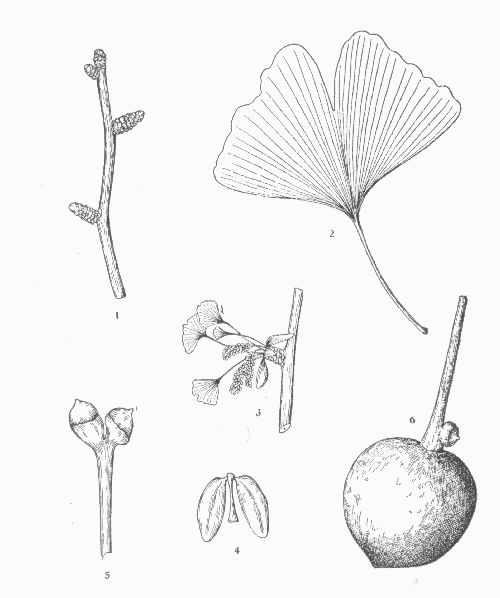
HABIT.—A slender tree in youth, with slender, upright branches, becoming broader with age and forming a symmetrical, pyramidal crown; probably 60-80 feet high, with a trunk diameter of 2-4 feet.
LEAVES.—Clustered at the ends of short, spur-like shoots, or scattered alternately on the long terminal branches; simple; 2-5 inches broad; more or less fan-shaped; usually bilobed and irregularly crenate at the upper extremity; thin and leathery; glabrous, pale yellow-green on both sides; petioles long, slender; turning a clear, golden yellow before falling in autumn.
FLOWERS.—May, with the leaves; dioecious; the staminate in short-stalked, pendulous catkins, 1 to 1-1/2 inches long, yellow; the pistillate more or less erect on the shoot, long-stalked, consisting of 2 naked ovules, one of which usually aborts.
FRUIT.—Autumn; a more or less globose drupe, orange-yellow to green, about 1 inch in diameter, consisting of an acrid, foul-smelling pulp inclosing a smooth, whitish, somewhat flattened, almond-flavored nut.
WINTER-BUDS.—Terminal bud about 1/8 inch long, conical, smooth, light chestnut-brown; lateral buds divergent, usually only on rapid-growing shoots.
BARK.—Twigs gray-brown and smooth; thick, ash-gray and somewhat roughened on the trunk, becoming more or less fissured in old age.
WOOD.—Light, soft, weak, close-grained, yellow-white to light red-brown, with thin, lighter colored sapwood.
NOTES.—Origin in dispute, but probably a native of northern China. Extensively cultivated in China and Japan, where its fruit is esteemed. Easily propagated from seed. Thrives in deep, well-drained, rich soil. Practically free from insect and fungous attacks, and little harmed by the smoke of cities. Probably hardy throughout the southern half of the Lower Peninsula.
| a. | Leaves 5 in a cluster; cones 4-10 inches long. | P. strobus, p. 7. | ||
| aa. | Leaves 2 in a cluster; cones less than 4 inches long. | |||
| b. | Leaves 1-3 inches long. | |||
| c. | Leaves about 1 inch long, divergent; cones sessile, pointing forward towards the tip of the branch, persistent 10-15 years, opening very unevenly. | P. banksiana, p. 9. | ||
| cc. | Leaves 1-1/2-3 inches long, slightly divergent; cones stout-stalked, pointing away from the tip of the branch, maturing in second season, opening evenly. | P. sylvestris, p. 13. | ||
| bb. | Leaves 3-6 inches long. | |||
| c. | Bark of trunk red-brown; cones maturing in second season, about 2 inches long; cone-scales thickened at the apex, but unarmed. | P. resinosa, p. 15. | ||
| cc. | Bark of trunk gray to nearly black; cones maturing in first season, 2-3 inches long; cone-scales thickened at the apex and topped with a short spine. | P. laricio austriaca, p. 11. | ||
| a. | Leaves 5 in a cluster; cones 4-10 inches long. | P. strobus, p. 7. | ||
| aa. | Leaves 2 in a cluster; cones less than 4 inches long. | |||
| b. | Leaves 1-3 inches long. | |||
| c. | Leaves about 1 inch long, divergent; cones sessile, pointing forward towards the tip of the branch, persistent 10-15 years, opening very unevenly. | P. banksiana, p. 9. | ||
| cc. | Leaves 1-1/2-3 inches long, slightly divergent; cones stout-stalked, pointing away from the tip of the branch, maturing in second season, opening evenly. | P. sylvestris, p. 13. | ||
| bb. | Leaves 3-6 inches long. | |||
| c. | Bark of trunk red-brown; cones maturing in second season, about 2 inches long; cone-scales thickened at the apex, but unarmed. | P. resinosa, p. 15. | ||
| cc. | Bark of trunk gray to nearly black; cones maturing in first season, 2-3 inches long; cone-scales thickened at the apex and topped with a short spine. | P. laricio austriaca, p. 11. | ||
White Pine
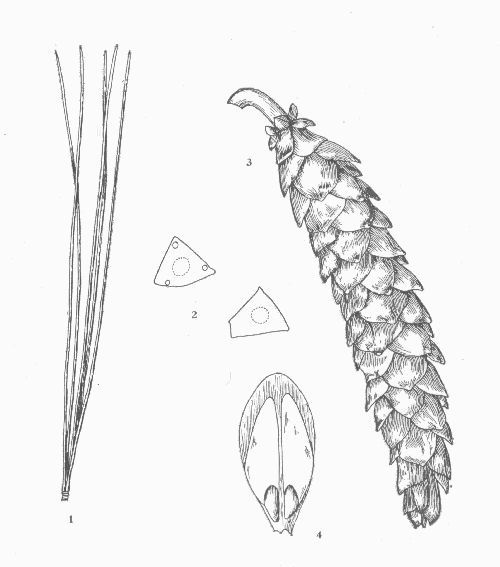
HABIT.—A large tree 60-80 feet high, with a trunk diameter of 2-4 feet; forming a wide, pyramidal crown. Formerly trees 100-150 feet in height and 5-7 feet in trunk diameter were not exceptional.
LEAVES.—In clusters of five; 3-5 inches long; slender, straight, needle-shaped, 3-sided, mucronate; pale blue-green. Persistent about 2 years.
FLOWERS.—June; monoecious; the staminate oval, light brown, about 1/3 inch long, surrounded by 6-8 involucral bracts; the pistillate cylindrical, about 1/4 inch long, pinkish purple, long-stalked.
FRUIT.—Autumn of second season, falling during the winter and succeeding spring; pendent, short-stalked, narrow-cylindrical, often curved, greenish cones, 4-10 inches long; scales rather loose, slightly thickened at the apex; seeds red-brown, 1/4 inch long, with wings 1 inch long.
WINTER-BUDS.—Oblong-ovoid, sharp-pointed, yellow-brown, 1/4-1/2 inch long.
BARK.—Twigs at first rusty-tomentose, later smooth and light brown, finally thin, smooth, greenish; thick, dark gray on the trunk, shallowly fissured into broad, scaly ridges.
WOOD.—Light, soft, weak, compact, straight-grained, easily worked, light brown, with thin, whitish sapwood.
DISTRIBUTION.—Upper Peninsula and Lower Peninsula north of Allegan, Eaton and St. Clair Counties. Often planted as an ornamental tree farther south.
HABITAT.—Prefers a light, fertile loam; sandy soils of granite origin.
NOTES.—Rapid of growth. Small seedlings easily transplanted. Formerly very abundant, but rapidly nearing extinction through destructive lumbering.
Jack Pine. Scrub Pine
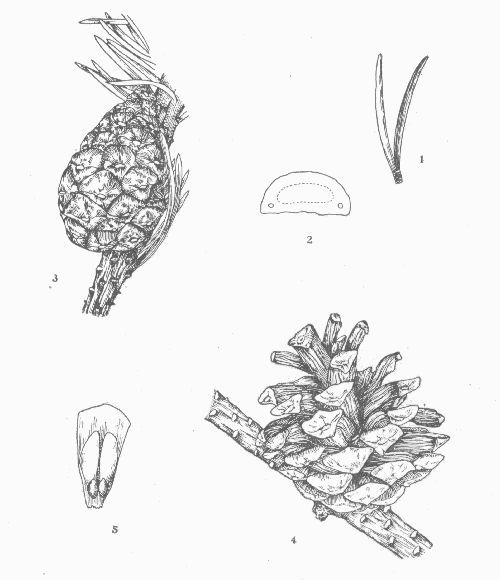
HABIT.—Usually a small tree 20-30 feet high, with a trunk diameter of 8-12 inches; forming a crown varying from open and symmetrical to scrubby, stunted, and variously distorted.
LEAVES.—In clusters of two; about 1 inch long; narrow-linear, with sharp-pointed apex; stout, curved or twisted, divergent from a short sheath; dark gray-green. Persistent 2-3 years.
FLOWERS.—May-June; monoecious; the staminate in oblong clusters 1/2 inch long, composed of many sessile, yellow anthers imbricated upon a central axis; the pistillate in subglobose clusters, composed of many carpel-like, purple scales (subtended by small bracts) spirally arranged upon a central axis.
FRUIT.—Autumn of second or third season, but remaining closed for several years and persistent on the tree for 10-15 years; erect, usually incurved, oblong-conical, sessile cones, 1-1/2-2 inches long; scales thickened at the apex; seeds triangular, nearly black, 3/8 inch long, with wings 1/3 inch long.
WINTER-BUDS.—Terminal bud 1/4 inch long, ovoid, rounded, pale brown; lateral buds smaller.
BARK.—Twigs yellow-green, becoming purple, finally dark red-brown and rough with the persistent bases of fallen leaves; thin, dark red-brown on the trunk, with shallow, rounded ridges, rough-scaly on the surface.
WOOD.—Light, soft, weak, close-grained, light brown, with thick, whitish sapwood.
DISTRIBUTION.—Common from Clare County northward; occurs sparingly along the lake shore as far south as Grand Haven on the west and Port Austin on the east.
HABITAT—Sandy, sterile soil.
NOTES.—Cones open unevenly. Slow of growth. Difficult to transplant.
Austrian Pine. Black Pine
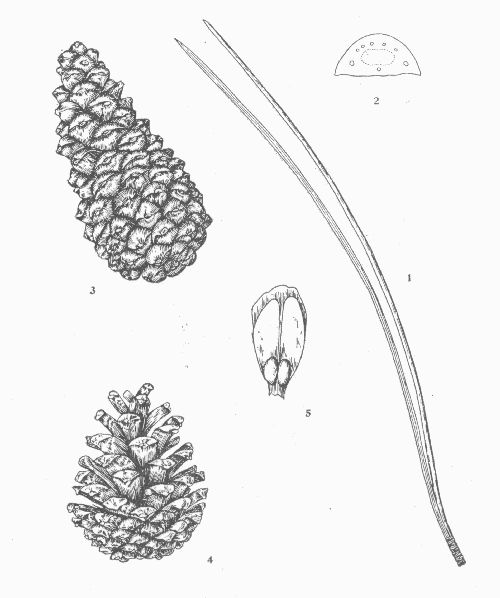
HABIT.—A large tree 60-80 feet high, with a trunk diameter of 2-4 feet; forming a massive, spreading crown of stiff, strong branches.
LEAVES.—In clusters of two; 3-6 inches long; slender, rigid, sharp-pointed, curved towards the twig; deep green on both faces. Persistent 3-6 years.
FLOWERS.—May-June; monoecious; the staminate cylindrical, subsessile, bright yellow, about 3/4 inch long; the pistillate cylindrical, small, bright red, subsessile.
FRUIT.—Autumn of first season, opening two years after full size is attained and remaining on the tree several years; erect, sessile, long-ovoid cones 2-3 inches long; scales smooth, lustrous, thickened at the apex and topped with a short spine in the center; seeds red-brown, 1/4 inch long, with wings 3/4 inch long.
WINTER-BUDS.—Oblong-conical, sharp-pointed, red-brown, resinous, about 1/2 inch long.
BARK.—Twigs brownish to olive-brown and smooth, becoming darker with age; thick, gray to nearly black on old trunks and coarsely and deeply fissured.
WOOD.—Light, strong, very resinous, red-brown, with thick, yellowish to reddish white sapwood.
NOTES.—Perfectly hardy. Adapts itself to a variety of soils. Well adapted for screens and wind-breaks. Easily transplanted when small. Grows rapidly.
Scotch Pine. Scotch Fir
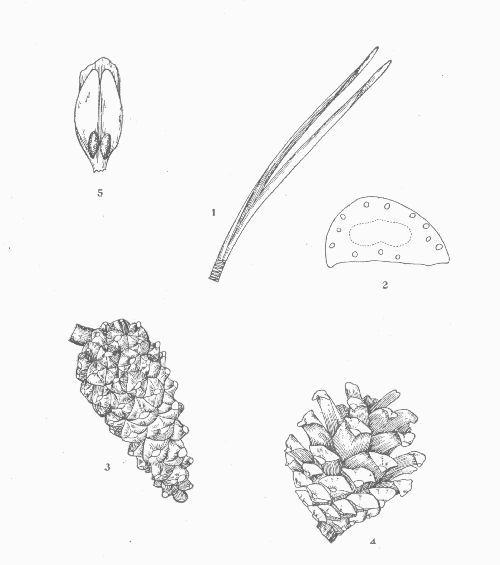
HABIT.—A large tree 60-80 feet high, with a trunk diameter of 1-2 feet; the side branches persist, forming a massive, wide-spreading crown.
LEAVES.—In clusters of two; 1-1/2-3 inches long; stiff, more or less twisted, spreading slightly from a short sheath; bluish- or often glaucous-green. Persistent 3-4 years.
FLOWERS.—May-June; monoecious; the staminate ovoid, short-stalked, yellowish, about 1/4 inch long; the pistillate oblong, reddish, short-stalked, about 1/4 inch long.
FRUIT.—Autumn of second season, falling as soon as ripe; pendent, stout-stalked, ovoid-conical cones 1-1/2-2-1/2 inches long; scales dull gray-brown, thickened at the apex into 4-sided, recurved points; seeds red-brown, nearly 1/4 inch long, with wings about 3/4 inch long.
WINTER-BUDS.—Oblong-ovoid, sharp-pointed, red-brown, resinous, about 1/4 inch long.
BARK.—Twigs reddish to orange-brown, becoming grayish; thick, dark orange-brown on old trunks and coarsely and deeply fissured.
WOOD.—Light, stiff, straight-grained, strong, heavy, hard, resinous, red-brown, with thick, yellow to reddish white sapwood.
NOTES.—Very rapid of growth. Reaches perfection only in cold or elevated regions. Adapts itself to a variety of soils. A valuable ornamental tree. Very useful for screens or shelter belts.
Red Pine, Norway Pine
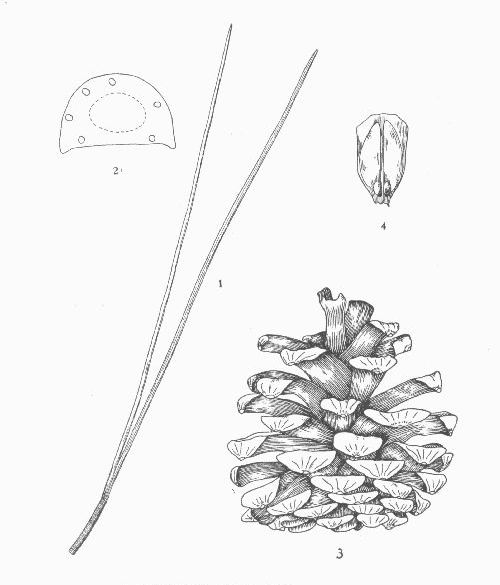
HABIT.—A large tree 70-80 feet high, with a trunk diameter of 2-3 feet; stout, horizontal branches, form a broad, rounded, rather open crown.
LEAVES.—In clusters of two; 4-6 inches long; slender, straight, needle-shaped, sharp-pointed, flexible, from elongated, persistent sheaths; lustrous dark green. Persistent 4-5 years.
FLOWERS.—April-May; monoecious; the staminate in oblong, dense clusters, 1/2-3/4 inch long, composed of many sessile, purple anthers imbricated upon a central axis; the pistillate single or few-clustered at the end of the branchlets, subglobose; scales ovate, scarlet, borne on stout peduncles covered with pale brown bracts.
FRUIT.—Autumn of second season, falling the next summer; ovoid-conical, nearly sessile cones, about 2 inches long; scales thickened at the apex; seeds oval, compressed, light mottled-brown, with wings 1/2-3/4 inch long.
WINTER-BUDS.—About 3/4 inch long, ovoid or conical, acute, red-brown, with rather loose scales.
BARK.—Twigs orange-brown, becoming rough with the persistent bases of leaf-buds; thick and red-brown on the trunk, shallowly fissured into broad, flat ridges.
WOOD.—Light, hard, very close-grained, pale red, with thin, yellow to white sapwood.
DISTRIBUTION.—Very abundant in Clare County and northward; frequent on the east side of the state as far south as Port Huron.
HABITAT.—Sandy plains and dry woods.
NOTES.—Rapid of growth on the better soils. Difficult to transplant.
Tamarack
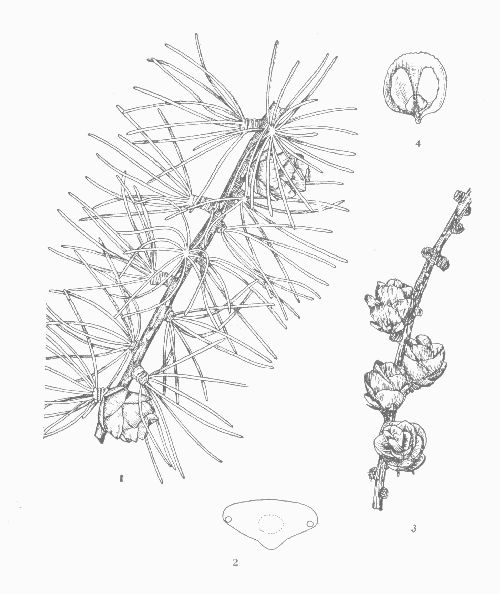
HABIT.—A tree sometimes 80-100 feet high, with a trunk diameter of 1-2 feet; forming a broad, open, irregular crown of horizontal branches.
LEAVES.—Scattered singly along the leading shoots or clustered on the short lateral branchlets; linear, with blunt apex; rounded above, keeled beneath; about 1 inch long; bright green; sessile. Deciduous in early autumn.
FLOWERS.—April-May, with the leaves, monoecious; the staminate sessile, subglobose, yellow, composed of many short-stalked anthers spirally arranged about a central axis; the pistillate oblong, short-stalked, composed of orbicular, green scales (subtended by red bracts) spirally arranged about a central axis.
FRUIT.—Autumn of first season, but persistent on the tree for a year longer; ovoid, obtuse, light brown, short-stalked cones, 1/2-3/4 inch long; seeds 1/8 inch long, with pale brown wings widest near the middle.
WINTER-BUDS.—Small, globose, lustrous, dark red.
BARK.—Twigs at first grayish, glaucous, later light orange-brown, and finally dark brown; red-brown and scaly on the trunk.
WOOD.—Heavy, hard, very strong, coarse-grained, very durable, light brown, with thin, nearly white sapwood.
DISTRIBUTION.—Common throughout the state.
HABITAT.—Prefers cold, deep swamps, or in the north coming out on the drier uplands.
NOTES.—Becomes a picturesque tree in old age. Should be transplanted while dormant.
| a. | Leaves 3/4-1 inch long, sharp-pointed; twigs glabrous. | ||
| b. | Cones 1-2 inches long, maturing in first season; leaves ill-scented when bruised. | P. canadensis, p. 21. | |
| bb. | Cones 3-6 inches long, maturing in second season; leaves not ill-scented when bruised. | P. abies, p. 25. | |
| aa. | Leaves 1/8-3/8 inch long, blunt-pointed; twigs rusty-pubescent. | P. mariana, p. 23. | |
| a. | Leaves 3/4-1 inch long, sharp-pointed; twigs glabrous. | ||
| b. | Cones 1-2 inches long, maturing in first season; leaves ill-scented when bruised. | P. canadensis, p. 21. | |
| bb. | Cones 3-6 inches long, maturing in second season; leaves not ill-scented when bruised. | P. abies, p. 25. | |
| aa. | Leaves 1/8-3/8 inch long, blunt-pointed; twigs rusty-pubescent. | P. mariana, p. 23. | |
White Spruce
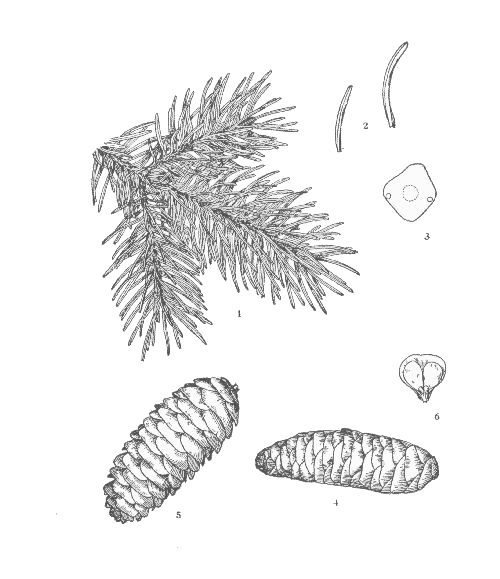
HABIT.—A tree 50-60 feet high, with a trunk diameter of 1-2 feet; forming a rather broad, open, pyramidal crown.
LEAVES.—Spirally arranged, but crowded on the upper side of the branches by the twisting of those on the under side; awl-shaped, 4-sided, incurved; dark blue-green; about 3/4 inch long; ill-scented when bruised. Persistent for several years.
FLOWERS.—April-May; monoecious; the staminate oblong-cylindrical, long-stalked, 1/2-3/4 inch long, composed of many spirally arranged, red anthers; the pistillate oblong-cylindrical, composed of broad, reddish scales (subtended by orbicular bracts) spirally arranged upon a central axis.
FRUIT.—Autumn or early winter of first season, falling soon after discharging the seeds; pendent, slender, oblong-cylindrical, nearly sessile cones, 1-2 inches long; seeds about 1/8 inch long, with large wings oblique at the apex.
WINTER-BUDS.—Broadly ovoid, obtuse, light brown, 1/8-1/4 inch long.
BARK.—Twigs smooth, gray-green, becoming orange-brown, finally dark gray-brown; thin, light gray-brown on the trunk, separating into thin, plate-like scales.
WOOD.—Light, soft, weak, straight-grained, light yellow, with sapwood of the same color.
DISTRIBUTION.—Common in the northern half of the Lower Peninsula and throughout the Upper Peninsula.
HABITAT.—Low, damp woods; banks of streams; borders of lakes; high rocky or sandy slopes; loves the cold winters.
NOTES.—A vigorous and beautiful tree in regions sufficiently cold.
Black Spruce
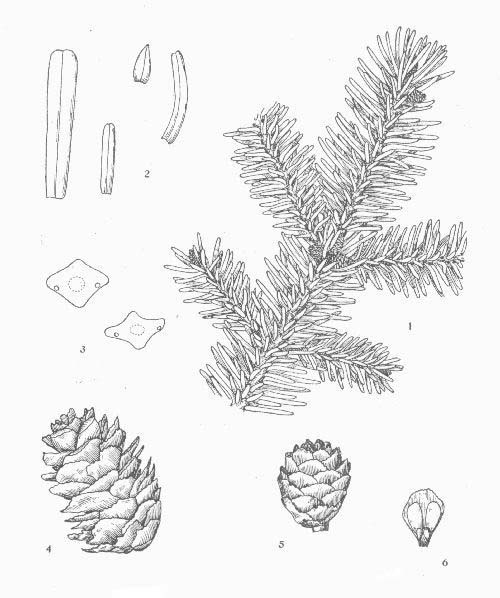
HABIT.—A small tree 20-30 feet high, with a trunk diameter of 6-10 inches; forming a narrow-based, conical, more or less irregular crown of short, slender, horizontal branches; often small and stunted.
LEAVES.—Spirally arranged, spreading in all directions; awl-shaped, 4-sided, blunt at the apex, more or less incurved; stiff; dark blue-green and glaucous; 1/8-3/8 inch long. Persistent for several years.
FLOWERS.—April-May; monoecious; the staminate subglobose, about 1/2 inch long, composed of many spirally arranged, dark red anthers; the pistillate oblong-cylindrical, composed of broad, purple scales (subtended by rounded, toothed, purple bracts) spirally arranged upon a central axis, about 1/2 inch long.
FRUIT.—Autumn of first season, but persistent on the branch for many years; pendent, ovoid, short-stalked cones, about 1 inch long; seeds about 1/8 inch long, with pale brown wings 1/2 inch long.
WINTER-BUDS.—Ovoid, acute, light red-brown, puberulous, 1/8 inch long.
BARK.—Twigs at first green and rusty-pubescent, becoming dull red-brown and rusty-pubescent; thin, gray-brown on the trunk, separating into thin, appressed scales.
WOOD.—Light, soft, weak, pale yellow-white, with thin, pure white sapwood.
DISTRIBUTION.—Occurs sparingly in southern Michigan; more abundant in the northern portions.
HABITAT.—Cold, sphagnous bogs and swamps; shores of lakes.
NOTES.—Short-lived. Undesirable for ornamental planting. Growing to its largest size in the far north.
Norway Spruce
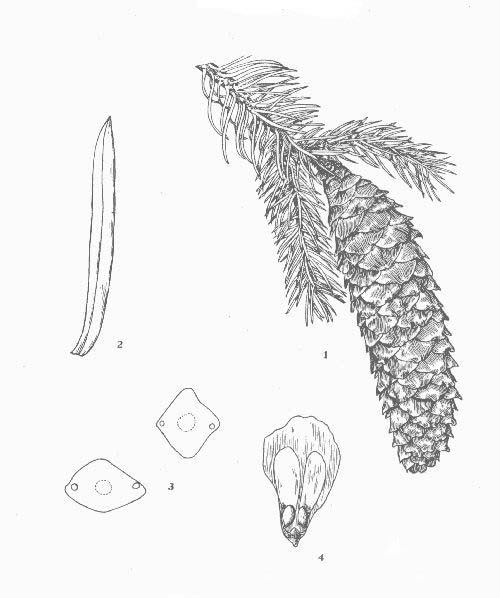
HABIT.—A tree 50-70 feet high, with a trunk diameter of 1-3 feet; forming a dense, conical, spire-topped crown of numerous, drooping branches which persist nearly to the ground.
LEAVES.—Spirally arranged along the twig; crowded; 3/4-1 inch long; rigid, curved, acute; lustrous, dark green. Persistent 5-7 years.
FLOWERS.—May; monoecious; the staminate ovoid to subglobose, long-stalked, reddish to yellowish, 3/4-1 inch long; the pistillate cylindrical, sessile, erect, 1-1/2-2 inches long.
FRUIT.—Autumn of first season; sessile, cylindrical cones 3-6 inches long, pendent from the tips of the uppermost branches; sterile scales very short, toothed; seeds red-brown, rough, 1/8 inch long, with long wings.
WINTER-BUDS.—Ovoid, acute, red-brown, not resinous, about 3/8 inch long.
BARK.—Twigs red- or orange-brown, smooth or corrugated; becoming thin and gray-brown on old trunks, slightly fissured, scaly.
WOOD.—Light, strong, tough, elastic, soft, fine-grained, white, with thick, indistinguishable sapwood.
NOTES.—Grows to a height of 120-150 feet in northern Europe and Asia. Perfectly hardy in Michigan. Easily transplanted. Adapts itself to a variety of soils and climates. Grows rapidly, but is short-lived in our country. Desirable for ornamental planting. Useful for shelter belts.
Balsam Fir
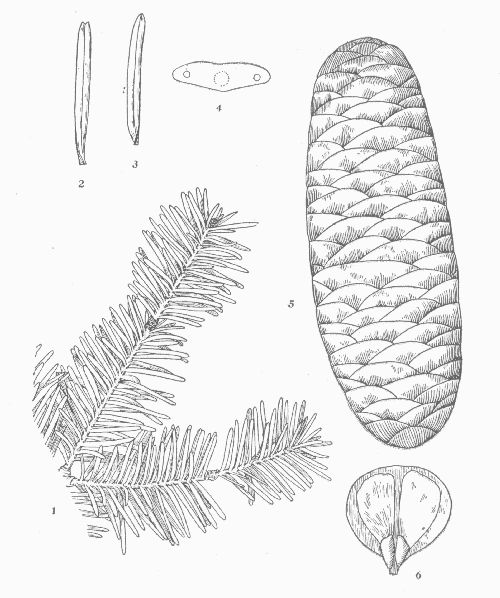
HABIT.—A slender tree 40-60 feet high, with a trunk diameter of 12-18 inches; branches in whorls of 4-6, forming a symmetrical, open crown widest at the base and tapering regularly upward.
LEAVES.—Scattered, spirally arranged in rows, on young trees extending from all sides of the branch, on old trees covering the upper side of the branch; narrowly linear, with apex acute or rounded; 1/2-1-1/4 inches long; lustrous, dark green above, pale beneath; sessile; aromatic. Persistent 8-10 years.
FLOWERS.—May; monoecious; the staminate oblong-cylindrical, yellow, 1/4 inch long, composed of yellow anthers (subtended by scales) spirally arranged upon a central axis; the pistillate oblong-cylindrical, 1 inch long, composed of orbicular, purple scales (subtended by yellow-green bracts) spirally arranged upon a central axis.
FRUIT.—Autumn of first season; oblong-cylindrical, erect, puberulous, dark purple cones, 2-4 inches long, about 1 inch thick; seeds 1/4 inch long, shorter than their light brown wings.
WINTER-BUDS.—Globose, orange-green, resinous, 1/8-1/4 inch in diameter.
BARK.—Twigs at first grayish and pubescent, becoming gray-brown and smooth; thin and smooth on young trunks, pale gray-brown and marked by swollen resin chambers; red-brown on old trunks and somewhat roughened by small, scaly plates.
WOOD.—Very light, soft, weak, coarse-grained, perishable, pale brown, with thick, lighter colored sapwood.
DISTRIBUTION.—Occasional in the southern half of the Lower Peninsula, frequent in the northern half; abundant in the Upper Peninsula.
HABITAT.—Prefers cool, moist, rich soil; low, swampy ground; well-drained hillsides.
NOTES.—Grows rapidly. Short-lived. Easily transplanted.
Hemlock
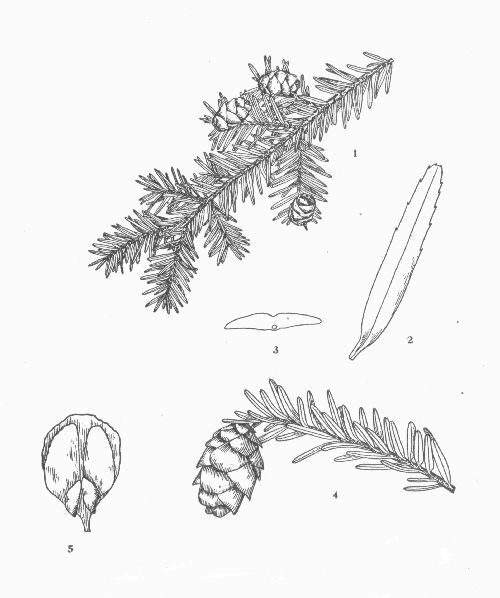
HABIT.—A large tree 60-80 feet high, with a trunk 2-4 feet in diameter; forming a rather broad, open, somewhat irregular-pyramidal crown of slender, horizontal branches.
LEAVES.—Spirally arranged around the branch, but appearing 2-ranked by the twisting of their petioles; linear, flat, rounded at the apex; about 1/2 inch long; dark yellow-green and shining above, hoary beneath; short-petioled. Persistent about 3 years.
FLOWERS.—April-May; monoecious; the staminate axillary, short-stalked, light yellow, about 3/8 inch long, composed of subglobose clusters of stamens; the pistillate terminal, oblong, pale green, 1/8 inch long, the scales short, pinkish.
FRUIT.—Autumn of first season, gradually losing their seeds during the winter and falling the next spring; oblong-ovoid, acute, short-stalked, red-brown cones, about 3/4 inch long; seeds 1/8 inch long, with wings about twice as long.
WINTER-BUDS.—Ovoid, obtuse, red-brown, slightly puberulous, 1/16 inch long.
BARK.—Twigs at first pale brown and pubescent, becoming glabrous, gray-brown; thick, red-brown or gray on the trunk, deeply divided into narrow, rounded, scaly ridges.
WOOD.—Light, soft, weak, brittle, coarse- and crooked-grained, not durable, ill-smelling, light red-brown, with thin, darker colored sapwood.
DISTRIBUTION.—Throughout the state, with the exception of the south-eastern portion; scarce on the east side of the state, more common on the west, becoming very abundant in Emmet County.
HABITAT.—Prefers well-drained uplands and slopes of ravines.
NOTES.—A favorite hedge plant. Useful for ornamental planting in shady situations.
Arborvitae. White Cedar
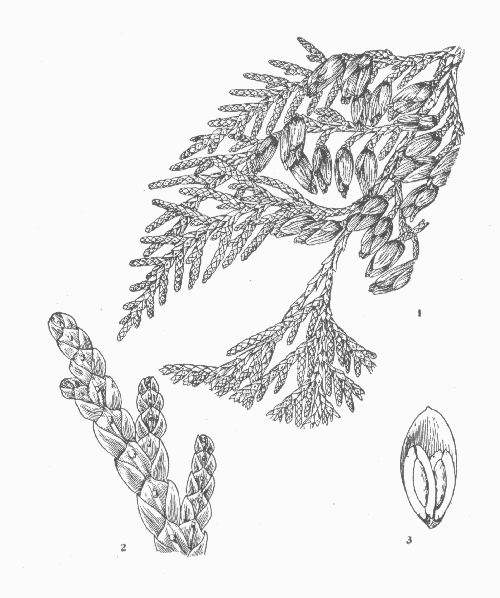
HABIT.—A tree 40-50 feet high, with a short, often buttressed trunk 1-2 feet in diameter, often divided into 2-3 secondary stems; forming a rather dense, wide-based, pyramidal crown.
LEAVES.—Opposite, 4-ranked, scale-like, appressed; ovate, obtuse or pointed, keeled in the side pairs, flat in the others; 1/8-1/4 inch long; yellow-green, often becoming brown in winter; strongly aromatic when crushed. Persistent 1-2 years.
FLOWERS.—April-May; usually monoecious; the staminate minute, globose, yellow, composed of 4-6 stamens arranged oppositely on a short axis; the pistillate small, oblong, reddish, composed of 8-12 scales arranged oppositely on a short axis.
FRUIT.—Early autumn of first season, but persistent on the branch through the winter; erect, short-stalked, oblong-ovoid, pale brown cones, about 1/2 inch long, composed of 8-12 loose scales; seeds 1/8 inch long, ovate, acute, winged.
WINTER-BUDS.—Naked, minute.
BARK.—Twigs yellow-green, becoming light red, finally smooth, lustrous, dark orange-brown; thin, light red-brown on the trunk, slightly furrowed or deciduous in ragged strips.
WOOD.—Light, soft, brittle, rather coarse-grained, durable, fragrant, pale yellow-brown, with thin, whitish sapwood.
DISTRIBUTION.—Throughout the Upper Peninsula, Lower Peninsula as far south as Montcalm County.
HABITAT.—Prefers moist soil in low swamps and along river-banks.
NOTES.—Slow of growth. Tolerant of all soils and exposures. Especially useful for hedges or narrow evergreen screens.
Red Juniper. Red Cedar
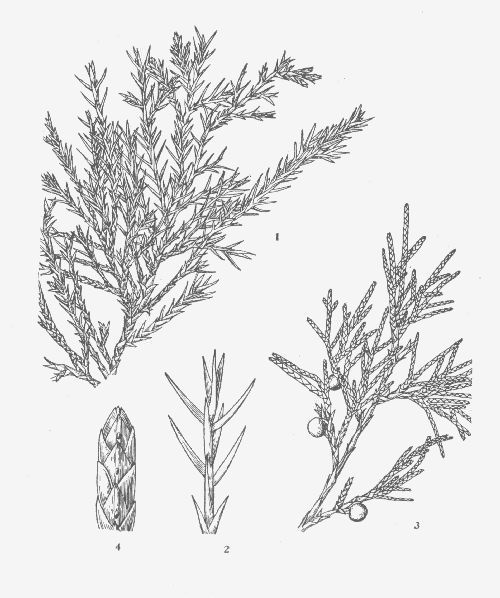
HABIT.—A medium-sized tree 30-40 feet high, with a trunk diameter of 1-2 feet; forming an irregular, pyramidal or rounded crown.
LEAVES.—Opposite, of two kinds: (1) sessile, scale-like, closely appressed, overlapping, 4-ranked, ovate, acute, 1/16 inch long, (2) sessile, awl-shaped, loosely arranged, 1/4-1/2 inch long. Persistent 5-6 years.
FLOWERS.—May; usually dioecious; minute; the staminate oblong-ovoid, composed of 4-6 shield-like scales, each bearing 4-5 yellow, globose pollen sacs; the pistillate ovoid, composed of about 3 pairs of flesh, bluish scales, united at the base and bearing 2 ovules.
FRUIT.—Autumn of first or second season; subglobose, berry-like strobile, about 1/4 inch in diameter, dark blue and glaucous; flesh sweet and resinous; seeds 2-3.
WINTER-BUDS.—Naked, minute.
BARK.—Twigs greenish to red-brown and smooth; thin, light red-brown on the trunk, exfoliating lengthwise into long, narrow, persistent strips, exposing the smooth, brown inner bark.
WOOD.—Light, soft, close-grained, brittle, weak, durable, very fragrant, dull red, with thin, whitish sapwood.
DISTRIBUTION.—Occurs sparingly throughout the state; most abundant in the southern portion.
HABITAT.—Prefers loamy soil on sunny slopes; dry, rocky hills; also borders of lakes and streams, peaty swamps.
NOTES.—Slow of growth. Long-lived. Should be transplanted with ball of earth. Tolerant of varied soils and situations.
| a. | Leaf-petioles without glands. | ||
| b. | Leaves 1/4-3/4 inch broad; petioles broad and flat. | S. nigra, p. 37. | |
| bb. | Leaves 3/4-1/4 inches broad; petioles slender and terete. | S. amygdaloides, p. 39. | |
| aa. | Leaf-petioles glandular above. | ||
| b. | Leaves 1/4-1/2 inch broad, sharp-serrate; tree with weeping habit. | S. babylonica, p. 43. | |
| bb. | Leaves 1/2-1-1/2 inches broad, blunt-serrate; tree with upright habit. | S. fragilis, p. 41. | |
The classification of the Willows is a task for the specialist, even when leaves and both staminate and pistillate flowers are obtainable. It is impractible for the novice to attempt the determination of species of Salix with winter characters alone. Consequently the usual winter key is omitted.
The genus Salix is represented in Michigan by thirty or more distinct species, and there are many more hybrids. The majority of these are shrubs, only a few becoming truly arborescent. Because of the similarity of their botanical characters, the frequency with which they hybridize, and the facility with which they respond to their environment only an expert is competent to identify the species so abundant along our water courses and on the banks of our lakes and swamps. The scope of this work being necessarily limited, it has been deemed best to describe but two of our native willows and two of our foreign neighbors which are frequently planted.
Black Willow
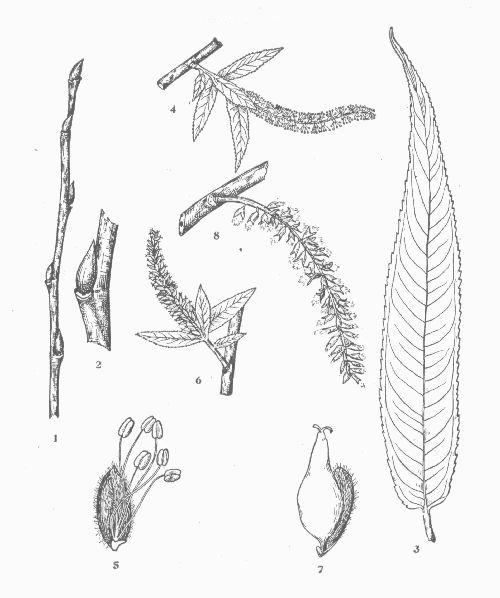
HABIT.—A tree 30-50 feet high, with a short trunk, 1-2 feet in diameter; stout, spreading branches form a broad, rather irregular, open crown. Often a shrub.
LEAVES.—Alternate, simple, 3-6 inches long, 1/4-3/4 inch broad; lanceolate, very long-pointed, often curved at the tip; finely serrate; thin; bright green and rather lustrous above, paler and often hairy beneath; petioles very short, more or less pubescent.
FLOWERS.—April-May, with the leaves; dioecious; borne in crowded, slender, hairy catkins, 1-3 inches long; calyx 0; corolla 0; scales yellow, villous, stamens 3-6; ovary ovoid-conical, short-stalked, with stigmas nearly sessile.
FRUIT.—June; ovoid-conical capsule, 1/8 inch long, containing many minute seeds which are furnished with long, silky, white hairs.
WINTER-BUDS.—Terminal bud absent; lateral buds narrow-conical, acute, lustrous, red-brown, 1/8 inch long.
BARK.—Twigs glabrous or pubescent, bright red-brown, becoming darker with age; thick, dark brown or nearly black on old trunks, deeply divided into broad, flat ridges, often becoming shaggy.
WOOD.—Light, soft, weak, close-grained, light red-brown, with thin, whitish sapwood.
DISTRIBUTION.—Common throughout the state.
HABITAT.—Banks of streams and lake-shores.
NOTES.—Branchlets very brittle at the base, and these, broken off by the wind, are carried down stream, often catching in the muddy banks and there taking root.
Almondleaf Willow
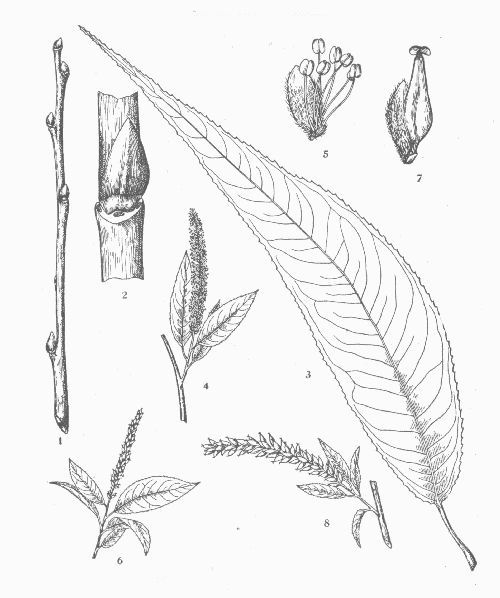
HABIT.—A tree 30-40 feet high, with a straight, columnar trunk 1-2 feet in diameter; straight, ascending branches form a rather narrow, rounded crown.
LEAVES.—Alternate, simple, 2-6 inches long, 3/4-1-1/4 inches broad; lanceolate to ovate-lanceolate, long-pointed; finely serrate; thin and firm; light green and shining above, pale and glaucous beneath; petioles slender, 1/2-3/4 inch long.
FLOWERS.—April, with the leaves; dioecious; borne in crowded, slender, pubescent catkins 2-3 inches long; calyx 0; corolla 0; scales yellow, villous both sides; stamens 5-9; ovary oblong-conical, with stigmas nearly sessile.
FRUIT.—May; 1-celled, globose-conical capsule, 1/4 inch long, containing many minute seeds which are furnished with long, silky, white hairs.
WINTER-BUDS.—Terminal bud absent; lateral buds broadly ovoid, gibbous, lustrous, dark brown, 1/8 inch long.
BARK.—Twigs glabrous, lustrous, dark orange or red-brown becoming darker orange-brown; thick and brown on old trunks, irregularly fissured into flat, connected ridges.
WOOD.—Light, soft, weak, close-grained, light brown, with thick, whitish sapwood.
DISTRIBUTION.—Common throughout the state.
HABITAT.—Banks of streams.
NOTES.—Hybridizes freely with other willows, making its identification difficult.
Crack Willow. Brittle Willow
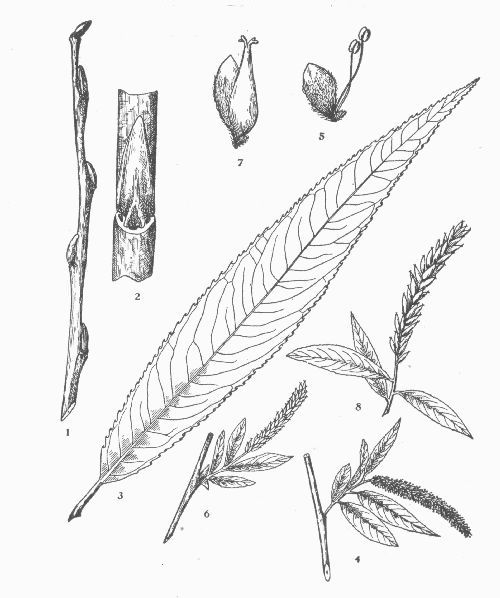
HABIT.—A tree 50-60 feet high, with a short, stout trunk 3-4 feet in diameter; stout, spreading branches form a broad, open crown.
LEAVES.—Alternate, simple, 3-6 inches long, 1/2-1-1/2 inches broad; lanceolate, long-pointed; finely glandular-serrate; thin and firm; lustrous, dark green above, paler beneath, glabrous both sides; petioles short, stout, with 2 glands at the junction of blade and petiole.
FLOWERS.—April-May, with the leaves; dioecious; borne in slender, pubescent catkins 1-3 inches long; calyx 0; corolla 0; scales blunt, somewhat pubescent; stamens usually 2; ovary abortive, with stigmas nearly sessile. Staminate trees rare.
FRUIT.—April-May; 1-celled, long-conical, short-stalked capsule, about 1/4 inch long, containing many minute seeds which are furnished with long, silky, white hairs.
WINTER-BUDS.—Terminal bud absent; lateral buds long-conical, pointed, glabrous, bright red-brown, about 1/4 inch long.
BARK.—Twigs pubescent, yellow-green, often reddish, becoming glabrous, lustrous, brown; thick, gray on the trunk, smooth in young trees, very rough, irregularly scaly-ridged in old trees.
WOOD.—Light, soft, tough, close-grained, red-brown, with thick, whitish sapwood.
NOTES.—A native of Europe and Asia, where it is a valuable timber tree. Hardy throughout the state and of very rapid growth. Thrives in rich, damp soil. Easily grown from cuttings. The twigs are very brittle at the base and are easily broken by the wind, hence the name Brittle Willow.
Weeping Willow. Napoleon’s Willow
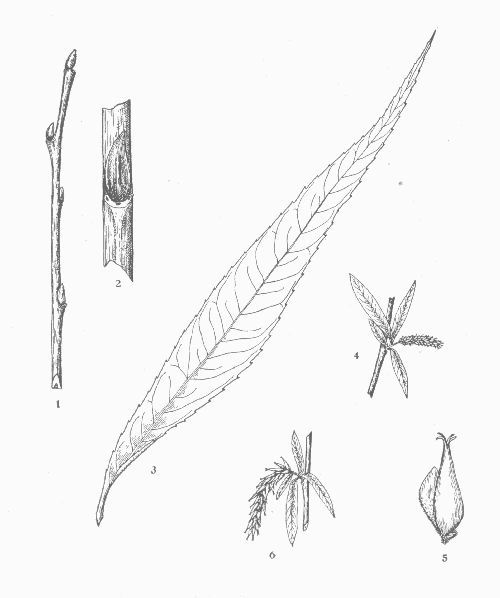
HABIT.—A tree 40-50 feet high, with a short, stout trunk 3-4 feet in diameter; the long, slender branchlets, often many feet in length, droop in graceful festoons, giving to the tree a weeping habit.
LEAVES.—Alternate, simple, 3-7 inches long, 1/4-1/2 inch broad; linear to linear-lanceolate, long-pointed; finely sharp-serrate; thin and firm; glabrous, dark green above, paler beneath; petioles 1/2 inch or less in length, glandular above, often hairy.
FLOWERS.—April-May, with the leaves; dioecious; borne in slender, nearly glabrous catkins 1-2 inches long; calyx 0; corolla 0; scales ovate-lanceolate, slightly hairy; ovary ovoid-conical, very short-stalked, with stigmas longer than the style. Staminate trees apparently do not occur in the United States.
FRUIT.—May-June; 1-celled, narrow-ovoid, sessile capsule, about 3/16 inch long, containing many minute seeds which are furnished with long, silky, white hairs.
WINTER-BUDS.—Terminal bud absent; lateral buds narrow-conical, sharp-pointed, somewhat flattened, brownish, 1/8-1/4 inch long.
BARK.—Twigs glabrous, olive-green; thick and gray on old trunks, rather smooth, or irregularly fissured into shallow, firm ridges.
WOOD.—Light, soft, weak, close-grained, light brown, with thick, whitish sapwood.
NOTES.—A native of Europe and Asia. Often grown in cemeteries. Easily propagated by cuttings. Rapid of growth in rich, damp soil. Sometimes winter-killed because the wood is not ripened.
| a. | Leaf-petioles essentially terete. | ||||
| b. | Petioles and lower sides of leaves pubescent; leaves heart-shaped. | P. candicans, p. 55. | |||
| bb. | Petioles and lower sides of leaves glabrous; leaves ovate-lanceolate. | P. balsamifera, p. 53. | |||
| aa. | Leaf-petioles strongly flattened. | ||||
| b. | Petioles and lower sides of leaves tomentose; twigs pubescent. | P. alba, p. 47. | |||
| bb. | Petioles and lower sides of leaves glabrous; twigs glabrous. | ||||
| c. | Leaves distinctly deltoid in shape. | ||||
| d. | Leaves broader than they are long, abruptly acuminate at the apex; marginal teeth not conspicuously incurved; branches erect and more or less appressed to the main stem, forming a narrow, spire-like crown. | P. nigra italica, p. 59. | |||
| dd. | Leaves longer than they are broad, more or less taper-pointed at the apex; marginal teeth rather conspicuously incurved; branches spreading, forming a broad crown. | P. deltoides, p. 57. | |||
| cc. | Leaves ovate to nearly orbicular in shape. | ||||
| d. | Margin of leaves coarsely sinuate-toothed; leaves 3-5 inches long. | P. grandidentata, p. 51. | |||
| dd. | Margin of leaves finely serrate; leaves less than 3 inches long. | P. tremuloides, p. 49. | |||
| a. | Branches erect, more or less appressed to the main stem, forming a narrow, spire-like crown. | P. nigra italica, p. 59. | |||
| aa. | Branches spreading, forming a broad crown. | ||||
| b. | Terminal buds 1/8-1/4 inch long, not resinous. | ||||
| c. | Buds and twigs more or less conspicuously white-downy; twigs green. | P. alba, p. 47. | |||
| cc. | Buds and twigs not conspicuously white-downy; twigs usually red-brown. | ||||
| d. | Terminal buds about 1/8 inch long, puberulous, dusty-looking; lateral buds widely divergent; twigs rather coarse. | P. grandidentata, p. 51. | |||
| dd. | Terminal buds about 1/4 inch long, glabrous, lustrous; lateral buds more or less appressed; twigs rather slender. | P. tremuloides, p. 49. | |||
| bb. | Terminal buds 1/2-1 inch long, sticky-resinous. | ||||
| c. | Terminal buds about 1/2 inch long; buds not fragrant; twigs usually yellow, more or less strongly angled. | P. deltoides, p. 57. | |||
| cc. | Terminal buds nearly 1 inch long; buds fragrant; twigs usually red-brown and seldom strongly angled. | P. balsamiferaE p. 55. P. candicansE p. 55. |
|||
White Poplar
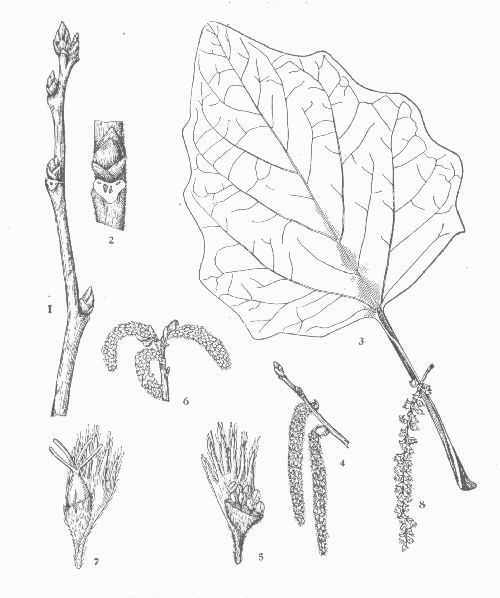
HABIT.—A large tree 60-80 feet high, with a trunk diameter of 2-4 feet, forming a large, spreading, rounded or irregular crown of large, crooked branches and sparse, stout branchlets.
LEAVES.—Alternate, simple, 2-4 inches long and almost as broad; broadly ovate to suborbicular; irregularly toothed, sinuate, or sometimes 3-5-lobed; glabrous, dark green above, white-tomentose to glabrous beneath; petioles long, slender, flattened, tomentose.
FLOWERS.—April-May, before the leaves; dioecious; the staminate catkins thick, cylindrical, 2-4 inches long; the pistillate catkins slender, 1-2 inches long; calyx 0; corolla 0; stamens 6-16, with purple anthers; stigmas 2, branched, yellow.
FRUIT.—May-June; ovoid, 2-valved capsules, 1/8-1/4 inch long, borne in drooping catkins 2-4 inches long; seeds light brown, surrounded by long, white hairs.
WINTER-BUDS.—Ovoid, pointed, not viscid, downy, about 1/4 inch long.
BARK.—Twigs greenish, covered with a white down, becoming greenish gray and marked with darker blotches; dark gray and fissured at the base of old trunks.
WOOD.—Light, soft, weak, difficult to split, reddish yellow, with thick, whitish sapwood.
NOTES.—A native of Europe and Asia. Hardy in Michigan. Grows rapidly in good soils; thrives in poor soils and exposed situations. Roots deep, producing numerous suckers for a considerable distance from the tree.
Aspen
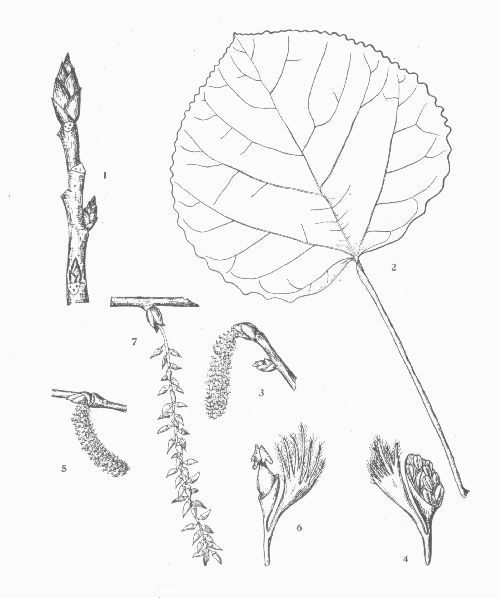
HABIT.—A small, slender tree generally 35-45 feet high, with a trunk diameter of 8-15 inches; forming a loose, rounded crown of slender branches.
LEAVES.—Alternate, simple, 1-1/2-2-1/2 inches long and broad; broadly ovate to suborbicular; finely serrate; thin and firm; lustrous, dark green above, dull and pale beneath; petioles slender, laterally compressed. Tremulous with the slightest breeze.
FLOWERS.—April, before the leaves; dioecious; the staminate catkins 1-1/2-3 inches long, the pistillate at first about the same length, gradually elongating; calyx 0; corolla 0; stamens 6-12; stigmas 2, 2-lobed, red.
FRUIT.—May-June; 2-valved, oblong-cylindrical, short-pedicelled capsules 1/4 inch long; seeds light brown, white-hairy.
WINTER-BUDS.—Terminal bud about 1/4 inch long, narrow-conical, acute, red-brown, lustrous; lateral buds often appressed.
BARK.—Twigs very lustrous, red-brown, becoming grayish and roughened by the elevated leaf-scars; thin, yellowish or greenish and smooth on the trunk, often roughened with darker, horizontal bands or wart-like excrescences, becoming thick and fissured, almost black at the base of old trunks.
WOOD.—Light, soft, weak, close-grained, not durable, light brown, with thin, whitish sapwood.
DISTRIBUTION.—Common throughout the state, but most abundant in the Upper Peninsula.
HABITAT.—Prefers moist, sandy soil and gravelly hillsides.
NOTES.—One of the first trees to cover burned-over lands. Grows rapidly. Usually short-lived. Propagated from seed or cuttings.
Largetooth Aspen
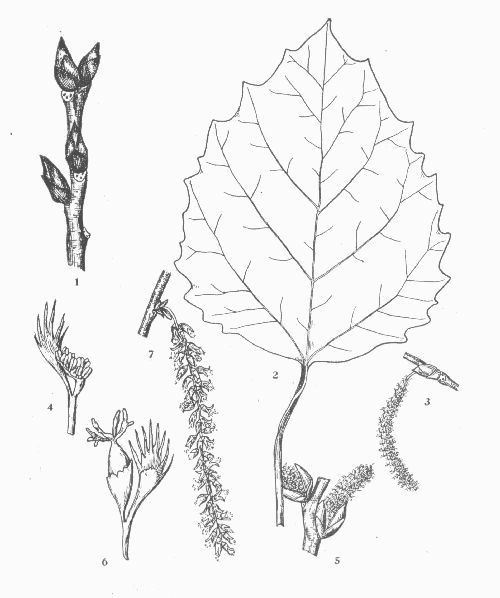
HABIT.—A medium-sized tree 30-50 feet high, with a slender trunk 12-20 inches in diameter; forming a loose, oval or rounded crown of slender, spreading branches and coarse spray.
LEAVES.—Alternate, simple, 3-5 inches long, two-thirds as broad; orbicular-ovate; coarsely and irregularly sinuate-toothed; thin and firm; dark green above, paler beneath, glabrous both sides; petioles long, slender, laterally compressed.
FLOWERS.—April, before the leaves; dioecious; the staminate in short-stalked catkins 1-3 inches long; the pistillate in loose-flowered, long-stalked catkins at first about the same length, but gradually elongating; calyx 0; corolla 0; stamens 6-12, with red anthers; stigmas 2, 2-lobed, red.
FRUIT.—May; 2-valved, conical, acute, hairy capsules 1/8 inch long, borne in drooping catkins 4-6 inches long; seeds minute, dark brown, hairy.
WINTER-BUDS.—Terminal bud 1/8 inch long, ovoid to conical, acute, light chestnut, puberulous, dusty-looking.
BARK.—Twigs greenish gray and at first hoary-tomentose, becoming lustrous, orange or red-brown and finally greenish gray; thick, dark red-brown or blackish at the base of old trunks, irregularly fissured, with broad, flat ridges.
WOOD.—Light, soft, weak, close-grained, light brown, with thin, whitish sapwood.
DISTRIBUTION.—A common tree in the northern portions of the Lower Peninsula, but rare in the Upper Peninsula.
HABITAT.—Prefers rich, moist, sandy soil; borders of swamps; river-banks; hillsides.
NOTES.—Grows rapidly in many soils. Easily transplanted. Short-lived. Useful for temporary effect. Propagated from seed or cuttings.
Balm of Gilead. Balsam
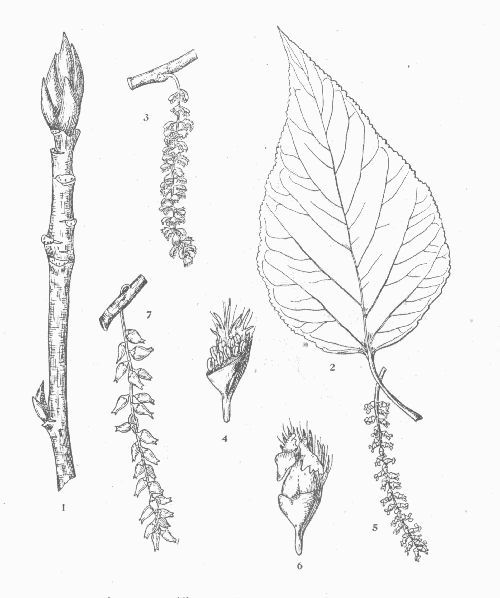
HABIT.—A tree 60-75 feet high, with a trunk diameter of 1-3 feet; forming a rather narrow, open, pyramidal crown of few, slender, horizontal branches.
LEAVES.—Alternate, simple, 3-6 inches long, about one-half as broad; ovate to ovate-lanceolate; finely crenate-serrate; thin and firm; lustrous, dark green above, paler beneath; petioles 1-1/2 inches long, slender, terete, smooth.
FLOWERS.—April, before the leaves; dioecious; the staminate in long-stalked catkins 3-4 inches long; the pistillate in loose-flowered, long-stalked catkins 4-5 inches long; calyx 0; corolla 0; stamens 20-30, with bright red anthers; ovary short-stalked; stigmas 2, wavy-margined.
FRUIT.—May-June; 2-valved, ovoid, short-pedicelled capsules 1/4 inch long, borne in drooping catkins 4-6 inches long; seeds light brown, hairy.
WINTER-BUDS.—Terminal bud about 1 inch long, ovoid, long-pointed, brownish, resin-coated, sticky, fragrant.
BARK.—Twigs red-brown, becoming dark orange, finally green-gray; thick, grayish on old trunks, and shallowly fissured into broad, rounded ridges, often roughened by dark excrescences.
WOOD.—Light, soft, weak, close-grained, light red-brown, with thick, nearly white sapwood.
DISTRIBUTION.—Occurs throughout the entire state, but is more abundant and of greater size in the northern portions.
HABITAT.—Prefers river bottom-lands and borders of swamps.
NOTES.—Rapid in growth. Spreads from the roots. Most useful for shelter belts. Easily transplanted. Propagated from cuttings.
Hairy Balm of Gilead. Balsam
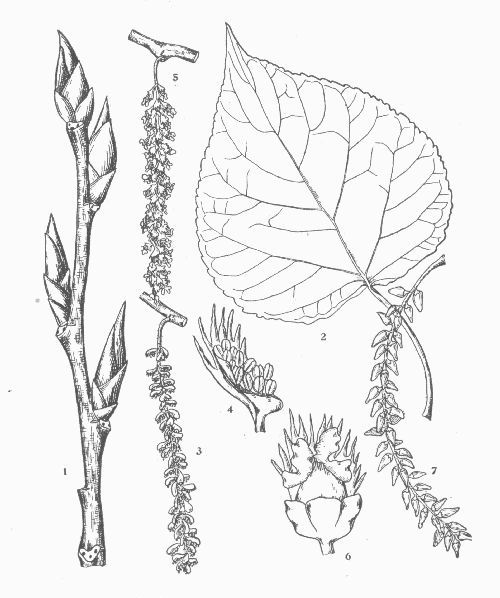
HABIT.—A tree 50-70 feet high, with a trunk diameter of 1-3 feet; more spreading branches than in P. balsamifera, forming a broader and more open crown.
LEAVES.—Resemble those of P. balsamifera, but more broadly heart-shaped and more coarsely serrate; more or less pubescent when young; petioles pubescent.
FLOWERS.—Similar to those of P. balsamifera.
FRUIT.—Similar to that of P. balsamifera.
WINTER-BUDS.—Terminal bud about 1 inch long, ovoid, long-pointed, dark red-brown, resinous throughout, viscid, very aromatic.
BARK.—Twigs reddish or olive-green, with occasional longitudinal gray lines, covered with a fragrant, gummy secretion, becoming gray-green; dark gray, rough, irregularly striate and firm on old trunks.
WOOD.—Resembles that of P. balsamifera, but is somewhat heavier.
DISTRIBUTION.—Indigenous to the northern portions of the state, but often cultivated and occasionally escaping in the southern portion.
HABITAT.—In a great variety of soils and situations.
NOTES.—Grows rapidly in all soils and situations. Suckers readily from the roots. Propagated from cuttings.
Cottonwood
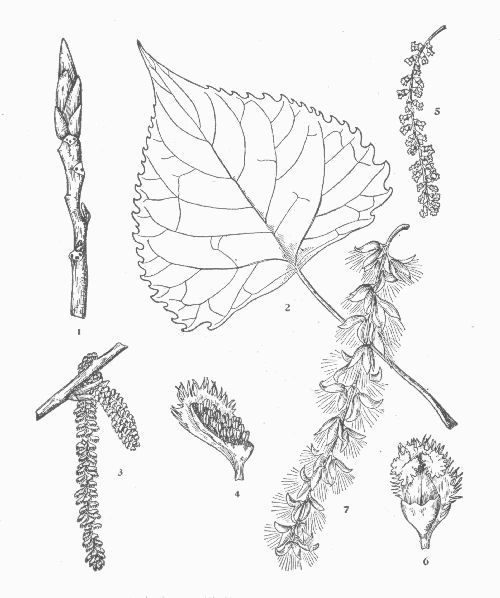
HABIT.—A stately tree attaining a height of 70-90 feet and a trunk diameter of 3-5 feet; forming a spreading, open, symmetrical crown of massive, horizontal branches and stout, more or less angled branchlets.
LEAVES.—Alternate, simple, 3-6 inches long, nearly as broad; broadly deltoid-ovate; coarsely crenate-serrate above the entire base; thick and firm; lustrous, dark green above, paler beneath; petioles 2-3 inches long, slender, compressed laterally.
FLOWERS.—April-May, before the leaves; dioecious; the staminate in short-stalked, densely-flowered catkins 3-4 inches long; the pistillate in short-stalked, few-flowered catkins elongating to 6-8 inches; calyx 0; corolla 0; stamens very numerous, with red anthers; stigmas 3-4, spreading.
FRUIT.—May; 2-4-valved, short-stalked capsules, borne in drooping catkins 5-10 inches long; seeds light brown, densely cottony.
WINTER-BUDS.—Terminal bud 1/2 inch long, conical, acute, very resinous, shining, brownish.
BARK.—Twigs and young stems smooth, yellow-green; old trunks ashy gray, deeply divided into straight furrows with broad, rounded ridges.
WOOD.—Light, soft, weak, close-grained, dark brown, with thick, whitish sapwood; warps badly and is difficult to season.
DISTRIBUTION.—Entire Michigan; rare in the northern portions.
HABITAT.—Prefers rich, moist soil; river-banks; river-bottoms; lake-shores; grows well in drier situations.
NOTES.—Rapid of growth, consequently an excellent tree for immediate effect. Propagated from cuttings.
Lombardy Poplar
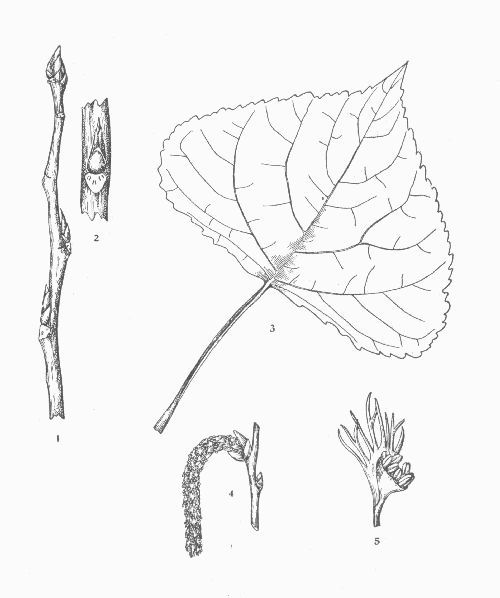
HABIT.—A tree 75-100 feet high, with a short, ridged and buttressed trunk 4-6 feet in diameter and a narrow, spire-like crown of erect branches.
LEAVES.—Alternate, simple, 2-4 inches long, and usually somewhat broader than long; broad-deltoid, abruptly acuminate; finely but bluntly crenate-serrate; thick and firm; dark green and shining above, lighter and more or less lustrous beneath; petioles slender, laterally compressed, 1-2 inches long.
FLOWERS.—April-May, before the leaves; dioecious; the staminate in sessile, dark red, cylindrical catkins about 3 inches long; the pistillate not present in the United States; calyx 0; corolla 0; stamens about 8, with white filaments and purple anthers.
FRUIT.—Not formed in the United States in the absence of pistillate flowers.
WINTER-BUDS.—Terminal bud conical, slightly angled, taper-pointed, glutinous, about 3/8 inch long; lateral buds smaller, appressed.
BARK.—Twigs glabrous, shining yellow, becoming gray; thick and gray-brown on old trunks, deeply and irregularly furrowed.
WOOD.—Light, soft, easily worked, not liable to splinter, weak, not durable, light red-brown, with thick, nearly white sapwood.
NOTES.—Thought to be a native of Afghanistan. Very rapid in growth. Short-lived. Spreads by means of suckers and fallen branches. Useful for ornamental purposes. Because of crowding the limbs die early, which remain and cause the tree to look unsightly.
| a. | Leaflets 11-17, the terminal usually present; pith of twigs chocolate-brown; bark of trunk rather smooth, or fissured, with broad, flat, whitish ridges; fruit elongated, sticky-downy. | J. cinerea, p. 63. |
| aa. | Leaflets 13-23, the terminal often lacking; pith of twigs cream colored; bark of trunk rough, brownish or blackish, deeply furrowed by broad, rounded ridges; fruit globose, not sticky-downy. | J. nigra, p. 65. |
| a. | Pith chocolate-brown; leaf-scar with downy pad above; fruit elongated, sticky-downy; terminal bud 1/2-3/4 inch long; bark rather smooth, or fissured, with broad, flat, whitish ridges. | J. cinerea, p. 63. |
| aa. | Pith cream colored; leaf-scar without downy pad above; fruit globose, not sticky-downy; terminal bud 1/3 inch long; bark rough, brownish or blackish, deeply furrowed by broad, rounded ridges. | J. nigra, p. 65. |
Butternut
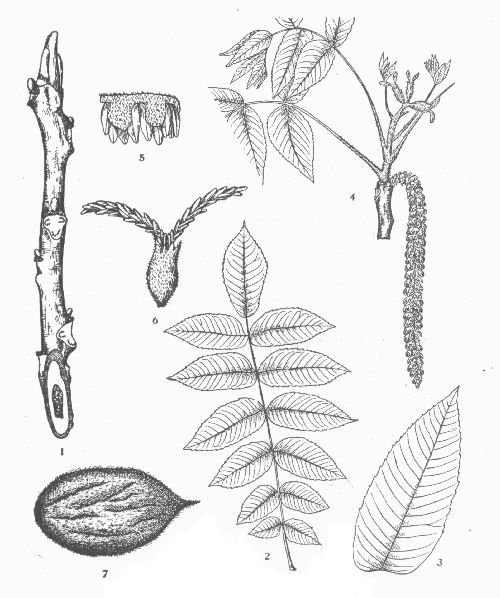
HABIT.—A medium-sized tree 40-60 feet high, with a short trunk 2-3 feet in diameter; forming a wide-spreading crown of large, horizontal branches and stout, stiff branchlets.
LEAVES.—Alternate, compound, 15-30 inches long. Leaflets 11-17, 2-4 inches long and one-half as broad; sessile, except the terminal; oblong-lanceolate; finely serrate; thin; yellow-green and rugose above, pale and soft-pubescent beneath. Petioles stout, hairy.
FLOWERS.—May, with the leaves; monoecious; the staminate in cylindrical, greenish, drooping catkins 3-5 inches long; calyx 6-lobed, borne on a hairy bract; corolla 0; stamens 8-12, with brown anthers; the pistillate solitary or several on a common peduncle, about 1/3 inch long, their bracts and bractlets sticky-hairy; calyx 4-lobed, hairy; corolla 0; styles 2; stigmas 2, fringed, spreading, bright red.
FRUIT.—October; about 2-1/2 inches long, cylindrical, pointed, greenish, sticky-downy, solitary or borne in drooping clusters of 3-5; nuts with rough shells, inclosing a sweet, but oily kernel; edible.
WINTER-BUDS.—Terminal bud 1/2-3/4 inch long, oblong-conical, obliquely blunt, somewhat flattened, brownish, pubescent.
BARK.—Twigs orange-brown or bright green, rusty-pubescent, becoming smooth and light gray; gray and smoothish on young trunks, becoming brown on old trunks, narrow-ridged, with wide furrows.
WOOD.—Light, soft, weak, coarse-grained, light brown, with thin, lighter colored sapwood.
DISTRIBUTION.—Of common occurrence in the southern half of the Lower Peninsula.
HABITAT.—Prefers low, rich woods; river-banks; low hillsides.
NOTES.—Leaves appear late and fall early. Pith chambered, chocolate-brown. Large trees usually unsound. Not easily transplanted.
Black Walnut
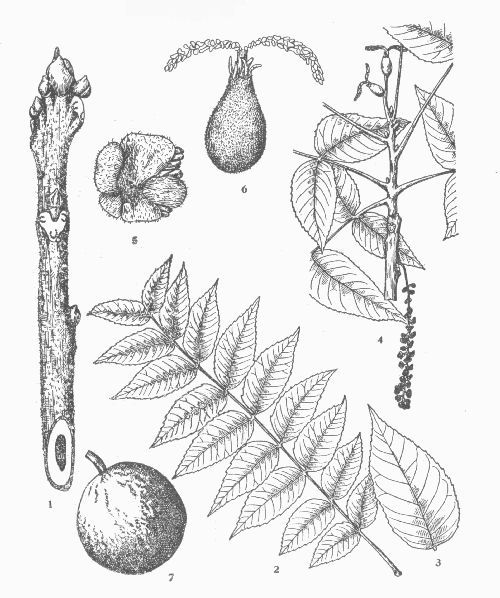
HABIT.—A large tree 60-80 feet high, with a massive trunk 2-5 feet in diameter; forming an open, capacious crown of heavy branches and coarse branchlets.
LEAVES.—Alternate, compound, 1-2 feet long. Leaflets 13-23, the terminal often lacking, 2-4 inches long and one-half as broad; sessile; ovate-lanceolate, taper-pointed; sharp-serrate; thin; yellow-green and glabrous above, lighter and soft-pubescent beneath. Petioles stout, pubescent. Foliage aromatic when bruised.
FLOWERS.—May, with the leaves; monoecious; the staminate in cylindrical, greenish, drooping catkins 3-5 inches long; calyx 6-lobed, borne on a hairy bract; corolla 0; stamens numerous, with purple anthers; the pistillate solitary or several on a common peduncle, about 1/4 inch long, their bracts and bractlets hairy; calyx 4-lobed, pubescent; corolla 0; styles and stigmas 2.
FRUIT.—October; globose, 1-1/2-2 inches in diameter, smooth, not viscid; solitary or borne in clusters of 2-3; nuts with irregularly furrowed shell, inclosing a sweet, edible kernel.
WINTER-BUDS.—Terminal bud 1/3 inch long, ovoid, obliquely blunt, slightly flattened, silky-tomentose.
BARK.—Twigs brownish and hairy, becoming darker and smooth; thick, brownish or blackish on the trunk and deeply furrowed by broad, rounded ridges.
WOOD.—Heavy, hard, strong, close-grained, very durable in contact with the soil, rich dark brown, with thin, lighter colored sapwood.
DISTRIBUTION.—Lower Peninsula as far north as Bay City, but more abundant in the southern portion of its range.
HABITAT.—Prefers rich bottom-lands and fertile hillsides.
NOTES.—Leaves appear late and fall early. Fruit very aromatic. Pith chambered, cream colored. The juices from the husk stain the hands brown. Not easily transplanted. Often infested with caterpillars.
| a. | Bark of trunk essentially smooth, not deeply furrowed nor shaggy; husk of fruit less than 1/8 inch thick. | |||
| b. | Leaflets usually 5-7, glabrous beneath; buds dome-shaped, greenish; kernel of nut sweet. | |||
| c. | Twigs long-hairy; fruit less than 1 inch long. | C. microcarpa, p. 75. | ||
| cc. | Twigs glabrous or nearly so; fruit 1-1/2-2 inches long. | C. glabra, p. 77. | ||
| bb. | Leaflets usually 7-11, more or less downy beneath; buds elongated, bright yellow; kernel of nut bitter. | C. cordiformis, p. 79. | ||
| aa. | Bark of trunk deeply furrowed or shaggy; husk of fruit more than 1/8 inch thick. | |||
| b. | Twigs more or less pubescent; leaflets 5-7, more or less pubescent beneath. | |||
| c. | Twigs brownish; buds densely hairy; fruit 1-1/2-2 inches long. | C. alba, p. 73. | ||
| cc. | Twigs orange; buds merely puberulous; fruit 1-3/4-2-1/2 inches long; (leaflets usually 7). | C. laciniosa, p. 71. | ||
| bb. | Twigs tending to be glabrous; leaflets usually 5, glabrous beneath. | C. ovata, p. 69. | ||
| a. | Bark of trunk essentially smooth, not deeply furrowed nor shaggy; husk of fruit less than 1/8 inch thick. | |||
| b. | Terminal bud narrow, long-pointed, flattish, bright yellow; kernel of nut bitter. | C. cordiformis, p. 79. | ||
| bb. | Terminal bud broad, dome-shaped, not bright yellow; kernel of nut sweet. | |||
| c. | Buds greenish; twigs glabrous; fruit 1-1/2-2 inches long. | C. glabra, p. 77. | ||
| cc. | Buds red-brown; twigs long-hairy; fruit less than 1 inch long. | C. microcarpa, p. 75. | ||
| aa. | Bark of trunk deeply furrowed or shaggy; husk of fruit more than 1/8 inch thick. | |||
| b. | Twigs more or less pubescent; buds more or less pubescent. | |||
| c. | Buds 1/2-3/4 inch long, densely hairy; outer bud-scales deciduous in autumn; twigs brownish; fruit 1-1/2-2 inches long. | C. alba, p. 73. | ||
| cc. | Buds about 1 inch long, merely puberulous; outer bud-scales persistent until spring; twigs orange colored; fruit 1-3/4-2-1/2 inches long. | C. laciniosa, p. 71. | ||
| bb. | Twigs tending to be glabrous; buds glabrous or nearly so. | C. ovata, p. 69. | ||
Shagbark Hickory. Shellbark Hickory
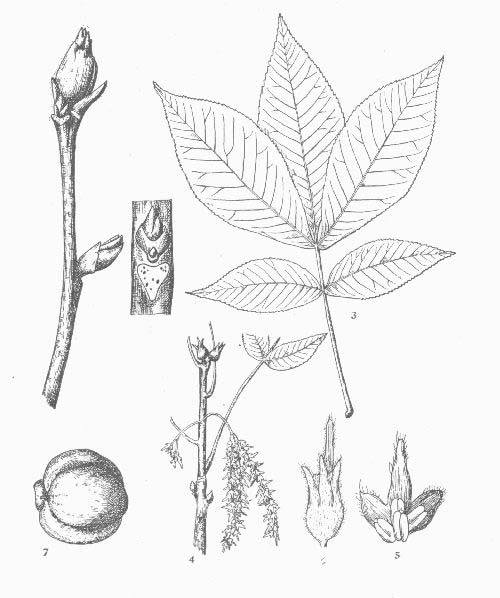
HABIT.—A tree 60-80 feet high, with a slender, columnar trunk 1-2 feet in diameter; forming a narrow, somewhat open crown of stout, slightly spreading limbs and stout branchlets.
LEAVES.—Alternate, compound, 8-14 inches long. Leaflets usually 5, the upper 5-7 inches long and 2-3 inches broad; sessile, except the terminal; obovate to oblong-lanceolate; finely serrate; thick and firm; glabrous, dark green above, paler beneath and glabrous or puberulous. Petioles stout, smooth or hairy. Foliage fragrant when crushed.
FLOWERS.—May, after the leaves; monoecious; the staminate hairy, greenish, in pendulous, ternate catkins 4-5 inches long, on a common peduncle about 1 inch long; scales 3-parted, bristle-tipped; stamens 4, with bearded, yellow anthers; the pistillate in 2-5-flowered spikes, 1/3 inch long, brown-tomentose; calyx 4-lobed, hairy; corolla 0; stigmas 2, large, fringed.
FRUIT.—October; globular, 1-2 inches long, with thick husk separating completely; nut usually 4-ridged, with thick shell and large, sweet, edible kernel.
WINTER-BUDS.—Terminal bud 1/2-3/4 inch long, broadly ovoid, obtuse, dark brown, pale-tomentose or nearly glabrous.
BARK.—Twigs brownish, more or less downy, becoming smooth and grayish; thick and grayish on old trunks, separating into thick strips 1-3 feet long, free at one or both ends, giving a characteristic shaggy appearance.
WOOD.—Heavy, very hard and strong, tough, close-grained, elastic, light brown, with thin, whitish sapwood.
DISTRIBUTION.—Common in the Lower Peninsula as far north as Roscommon County.
HABITAT.—Prefers light, well-drained, loamy soil; low hillsides; river-banks.
NOTES.—Hardy throughout its range. Moderately rapid in growth. Difficult to transplant.
Shellbark Hickory. King Nut
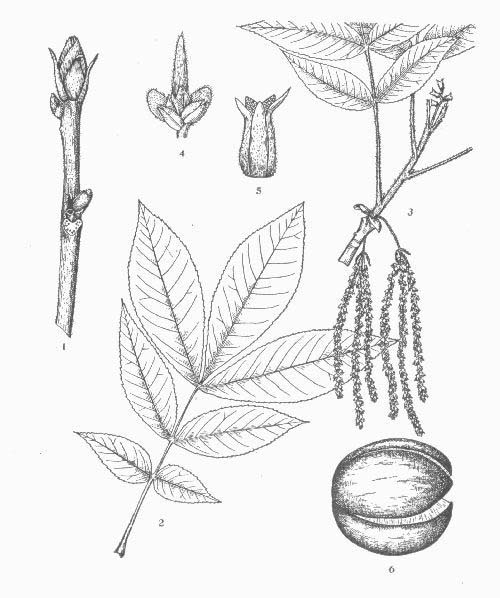
HABIT.—A tree 60-80 feet high, with a tall, slender trunk 2-3 feet in diameter; forming a narrow, oblong crown of small, spreading branches.
LEAVES.—Alternate, compound, 1-2 feet long. Leaflets usually 7, the upper 5-9 inches long, 3-5 inches broad, larger than the lowest pair; sessile or short-stalked; oblong-lanceolate to obovate, taper-pointed; finely serrate; thick and firm; lustrous, dark green above, paler and soft-pubescent beneath. Petioles stout, glabrous or pubescent, often persistent on the branches during the winter. Foliage fragrant when crushed.
FLOWERS.—May, after the leaves; monoecious; the staminate in pendulous, ternate catkins 5-8 inches long, slender, yellow-green, on common peduncles 1 inch long; scales 3-lobed, tomentose; stamens 4, with yellow, hairy anthers; the pistillate in crowded, 2-5-flowered spikes, tomentose; calyx 3-toothed, hairy; corolla 0; stigmas 2, light green.
FRUIT.—October; oblong to subglobose, 1-3/4-2-1/2 inches long, with very thick, woody husk, splitting to the base; nut 4-6-ridged, with thick, hard shell and large, sweet kernel.
WINTER-BUDS.—Terminal bud about 1 inch long, ovoid, obtuse, dark brown, puberulous.
BARK.—Twigs orange and more or less pubescent, becoming darker in the first winter, and finally grayish; on the trunk 1-2 inches thick, light gray, separating into broad, thick plates 3-4 feet long, persistent on the trunk for many years.
WOOD.—Heavy, very hard, strong, tough, close-grained, very elastic, dark brown, with thin, whitish sapwood.
DISTRIBUTION.—Occurs in the southern portion of the Lower Peninsula, but is rather a rare tree.
HABITAT.—Prefers deep, rich bottom-lands.
NOTES.—Rapid in growth. May be distinguished from other hickories by orange colored branchlets.
Mocker Nut Hickory
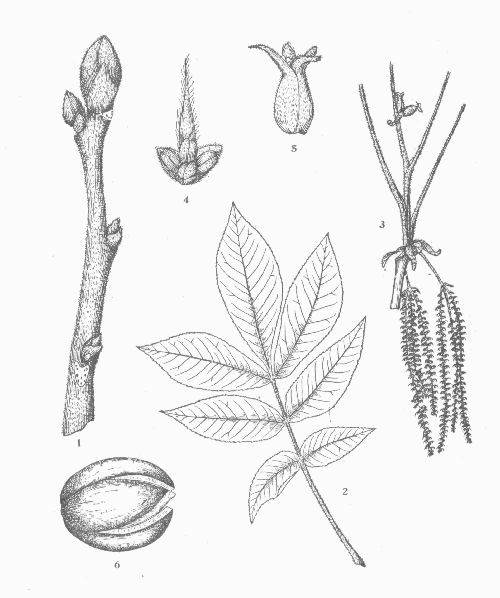
HABIT.—A tree 50-70 feet high, with a trunk diameter of 1-2-1/2 feet; forming a wide crown of strong, upright branches and stout branchlets.
LEAVES.—Alternate, compound, 8-12 inches long. Leaflets usually 5-7, sometimes 9, the upper 5-8 inches long, 3-4 inches broad; sessile, except the terminal; oblong- to obovate-lanceolate; minutely or sometimes coarsely serrate; thick and firm; lustrous, dark yellow-green above, paler and more or less pubescent beneath. Petioles pubescent. Foliage fragrant when crushed.
FLOWERS.—May, after the leaves; monoecious; the staminate in pendulous, ternate catkins 4-5 inches long, slender, green, hairy; scales 3-lobed, hairy; stamens 4-5, with red anthers; the pistillate in crowded, 2-5-flowered, tomentose spikes; calyx toothed, hairy; corolla 0; stigmas 2, hairy.
FRUIT.—October; globose to globose-oblong, 1-1/2-2 inches long, with thick husk splitting nearly to the base; nut 4-ridged, red-brown, with very thick, hard shell and small, sweet kernel.
WINTER-BUDS.—Terminal bud 1/2-3/4 inch long, broadly ovoid, red-brown, pilose; outermost scales fall in early autumn.
BARK.—Twigs at first brown-tomentose, becoming smooth and grayish; on the trunk thick, hard, grayish, slightly ridged by shallow, irregular fissures, becoming rugged on very old trunks.
WOOD.—Very heavy, hard, strong, tough, close-grained, elastic, dark brown, with thick, whitish sapwood.
DISTRIBUTION.—Southern Peninsula as far north as Grand Rapids and Flint. Infrequent.
HABITAT.—Prefers rich, well-drained soil, but grows well in various situations, if they are not too wet.
NOTES.—Hardy throughout its range. Difficult to transplant.
Small Pignut Hickory
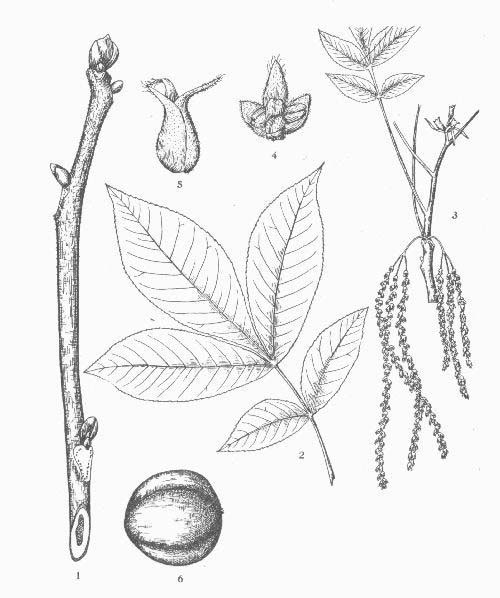
HABIT.—A tree usually 50-70 feet high, with a trunk diameter of 1-3 feet; forming an oblong or sometimes rounded crown of slender, spreading branches.
LEAVES.—Alternate, compound, 8-12 inches long. Leaflets usually 5-7, the upper 3-6 inches long, 2-2-1/2 inches broad; sessile, except the terminal; oblong to ovate-lanceolate, long-pointed; sharply serrate; thick and firm; glabrous, dark yellow-green above, lighter beneath. Petioles long, glabrous. Foliage fragrant when crushed.
FLOWERS.—May, after the leaves; monoecious; the staminate in pendulous, ternate catkins 3-7 inches long, slender, greenish, glabrous; stamens 4, with orange anthers; the pistillate in 2-5-flowered spikes, 1/4 inch long; calyx 4-toothed, hairy; corolla 0; stigmas 2, yellow.
FRUIT.—September; subglobose or globose-oblong, less than 1 inch long, with thin husk splitting nearly to the base; nut obscurely 4-ridged, with thin shell and small, sweet kernel.
WINTER-BUDS.—1/4-1/2 inch long, dome-shaped, red-brown, smooth.
BARK.—Twigs greenish, long-hairy, becoming reddish and finally gray; thick, hard and grayish on the trunk, divided by shallow fissures into narrow plates, and more or less shaggy.
WOOD.—Heavy, hard, strong, tough, close-grained, elastic, dark brown, with thick, whitish sapwood.
DISTRIBUTION.—Confined to the most southern portions of the Lower Peninsula.
HABITAT.—Prefers well-drained slopes and hillsides.
NOTES.—Resembles C. glabra, but the nut is much smaller.
Pignut Hickory
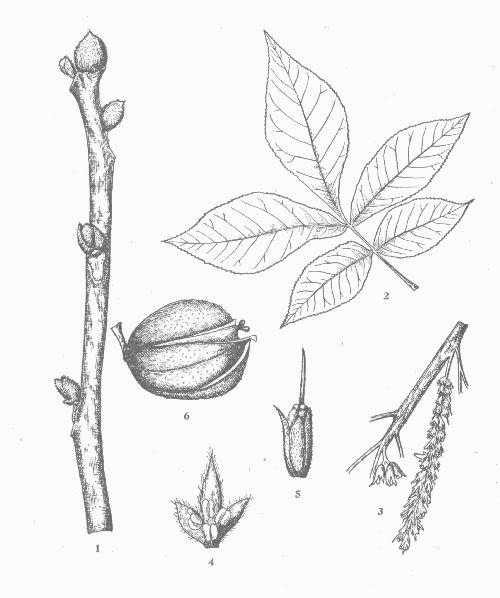
HABIT.—A tree usually 50-65 feet high, with a trunk diameter of 1-3 feet; forming a low, rather narrow, open crown of slender, often contorted branches.
LEAVES.—Alternate, compound, 8-12 inches long. Leaflets usually 5-7, the upper 3-6 inches long, 2-2-1/2 inches broad; subsessile, except the terminal; oblong to obovate-lanceolate, taper-pointed; sharply serrate; thick and firm; glabrous, dark yellow-green above, paler beneath. Petioles long, slender, glabrous or pubescent. Foliage fragrant when crushed.
FLOWERS.—May, after the leaves; monoecious; the staminate in pendulous, ternate catkins 3-7 inches long, slender, yellow-green, tomentose; scales 3-lobed, nearly glabrous; stamens 4, with orange anthers; the pistillate in crowded, 2-5-flowered spikes, 1/4 inch long; calyx 4-toothed, hairy; corolla 0; stigmas 2, yellow.
FRUIT.—October; variable in size and shape, 1-1/2-2 inches long, with thin husk splitting half-way and sometimes nearly to the base; nut obscurely 4-ridged, with thin or thick, hard shell and small, sweet or slightly bitter kernel which is hard to remove.
WINTER-BUDS.—Terminal bud 1/4-1/2 inch long, dome-shaped, greenish or grayish, smooth or finely downy.
BARK.—Twigs greenish, nearly glabrous, becoming reddish, and finally grayish; thick, hard and grayish on the trunk, with a firm, close surface divided by small fissures and sometimes broken into plates.
WOOD.—Heavy, hard, very strong, tough, close-grained, elastic, dark brown, with thick, whitish sapwood.
DISTRIBUTION.—Occurs only in the extreme southern portion of the Lower Peninsula. Common within its range.
HABITAT.—Prefers deep, rich loam, but grows in any well-drained soil; dry ridges and hillsides.
NOTES.—Hardy and desirable for ornamental purposes. Difficult to transplant. Not adapted to street use.
Bitternut Hickory
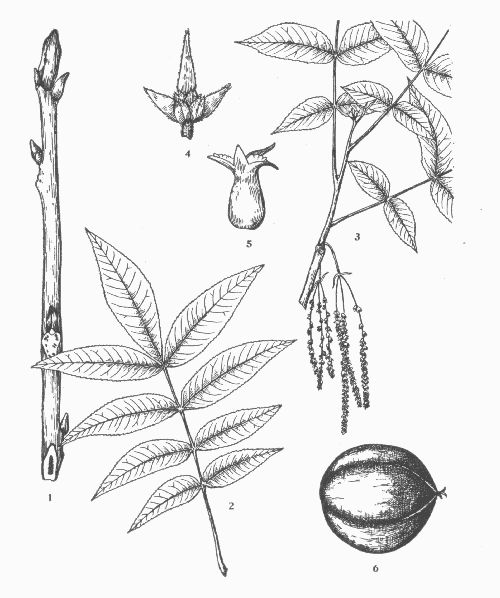
HABIT.—A tall, slender tree 50-75 feet high, with a trunk diameter of 1-2-1/2 feet; forming a broad crown of slender, stiff, upright branches, widest near the top.
LEAVES.—Alternate, compound, 6-10 inches long. Leaflets 5-11, the upper 4-6 inches long and one-fourth as broad; sessile, except the terminal; lanceolate to oblong-lanceolate, long-pointed; coarsely serrate; thin and firm; glabrous, bright green above, paler and more or less downy beneath. Petioles slender, hairy. Foliage fragrant when crushed.
FLOWERS.—May, after the leaves; monoecious; the staminate slightly pubescent, in pendulous, ternate catkins 3-4 inches long, on a common peduncle about 1 inch long; scales 3-lobed, hairy; stamens 4, with bearded, yellow anthers; the pistillate in 2-5-flowered spikes 1/2 inch long, scurfy-tomentose; calyx 4-lobed, pubescent; corolla 0; stigmas 2, greenish.
FRUIT.—October; obovate to globular, about 1 inch long, coated with yellow, scurfy pubescence, with very thin husk splitting half-way to the base, with sutures winged at the top; nut quite smooth, with thin shell and small, bitter kernel.
WINTER-BUDS.—Terminal bud about 3/4 inch long, long-pointed, flattish, granular-yellow; lateral buds more or less 4-angled.
BARK.—Twigs greenish and more or less downy, becoming brownish, and finally grayish; gray, close, smooth on the trunk, often reticulately ridged, but rarely broken into plates.
WOOD.—Heavy, very hard, strong, tough, close-grained, dark brown, with thick, lighter colored sapwood.
DISTRIBUTION.—Of common occurrence in the southern half of the Lower Peninsula.
HABITAT.—Prefers a rich, loamy or gravelly soil; low, wet woods; along the borders of streams; but also found on high, dry uplands.
NOTES.—Grows most rapidly of all the hickories, but is apt to show dead branches. Should be propagated from the seed, as it is not easily transplanted.
Hornbeam. Ironwood
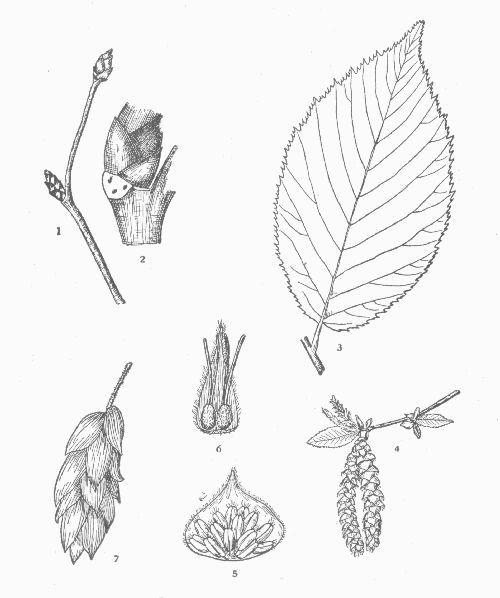
HABIT.—A small tree usually 20-30 feet high, with a trunk diameter of 8-12 inches; forming a broad, rounded crown of many long, slender branches and a slender, stiff spray.
LEAVES.—Alternate, simple, 3-5 inches long, about one-half as broad; oblong-ovate; sharply doubly serrate; thin and very tough; dull, dark green above, paler and more or less pubescent beneath; petioles short, slender, pubescent.
FLOWERS.—April-May, with the leaves; monoecious; the staminate in drooping, cylindrical catkins from wood of the previous season, usually in threes; stamens 3-14, crowded on a hairy torus; the pistillate in erect, lax catkins on the season’s shoots, usually in pairs, each flower inclosed in a hairy, sac-like involucre.
FRUIT.—September; strobiles, resembling clusters of hops, 1-2 inches long, borne on slender, hairy stems; nuts small and flat, inclosed by sac-like involucres.
WINTER-BUDS.—Terminal bud absent; lateral buds 1/8-1/4 inch long, ovoid, acute, red-brown.
BARK.—Twigs at first light green, becoming lustrous, red-brown, and finally dull dark brown; thin, gray-brown on the trunk, very narrowly and longitudinally ridged.
WOOD.—Heavy, very strong and hard, tough, close-grained, durable, light red-brown, with thick, whitish sapwood.
DISTRIBUTION.—Common throughout the entire state.
HABITAT.—Prefers dry, gravelly slopes and ridges.
NOTES.—Often grows in shade of other trees. Not easily transplanted. Rather slow of growth. Too small for street use.
Blue Beech. Water Beech
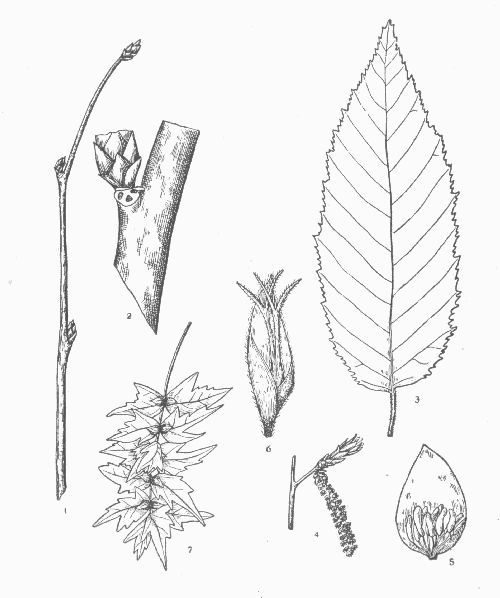
HABIT.—Usually a low, bushy tree or large shrub, 10-30 feet high, with a trunk diameter of 6-12 inches; trunk short, usually fluted; slender zigzag branches and a fine spray form a close, flat-topped crown.
LEAVES.—Alternate, simple, 2-4 inches long and one-half as broad; ovate to oval, long-pointed; sharply doubly serrate; thin and firm; dull green above, lighter beneath, turning scarlet and orange in autumn; petioles short, slender, hairy.
FLOWERS.—May, after the leaves; monoecious; apetalous; the staminate catkins 1-1-1/2 inches long, their scales greenish, boat-shaped, each bearing 3-20 stamens; the pistillate catkins 1/2-3/4 inch long, their scales hairy, greenish, each bearing 2 pistils with long, scarlet styles.
FRUIT.—Ripens in midsummer, but often remains on the tree long after the leaves have fallen; in loose, terminal strobiles; involucre halberd-shaped, inclosing a small, ovate, brownish nut.
WINTER-BUDS.—Terminal bud absent; lateral buds 1/8 inch long, narrow-ovoid, acute, puberulous, brownish.
BARK.—Twigs pale green, hairy, becoming lustrous, dark red the first winter; trunk and large limbs thin, smooth, close, dark bluish gray, often mottled with lighter or darker patches.
WOOD.—Heavy, hard, tough, very strong, close-grained, light brown, with thick, whitish sapwood.
DISTRIBUTION.—Common throughout the state.
HABITAT.—Prefers a deep, rich, moist soil along the borders of streams and swamps. Often found in drier situations in the shade of other trees.
NOTES.—Propagated from seed. Not easily transplanted. Slow of growth. Seldom found in masses.
| a. | Bark of trunk white, separating freely into thin, papery layers; twigs without wintergreen taste; leaves usually solitary, not aromatic. | B. alba papyrifera, p. 91. | |
| aa. | Bark of trunk not white, usually dark colored, not separating freely into papery layers; twigs with more or less wintergreen taste; leaves solitary or in pairs, aromatic. | ||
| b. | Bark dirty-yellow, breaking into strips more or less curled at the edges; leaves solitary or in pairs, slightly aromatic; twigs with slight wintergreen taste | B. lutea, p. 89. | |
| bb. | Bark dark red-brown, cleaving off in thick, irregular plates (resembles bark of Black Cherry); leaves in pairs, strongly aromatic; twigs with strong wintergreen taste. | B. lenta, p. 87. | |
| a. | Bark of trunk white, separating freely into thin, papery layers; twigs without wintergreen taste. | B. alba papyrifera, p. 91. | |
| aa. | Bark of trunk not white, usually dark colored, not separating into papery layers; twigs with more or less wintergreen taste. | ||
| b. | Bark dirty-yellow, breaking into strips more or less curled at the edges; twigs with slight wintergreen taste. | B. lutea, p. 89. | |
| bb. | Bark dark red-brown, cleaving off in thick, irregular plates (resembles bark of Black Cherry); twigs with strong wintergreen taste. | B. lenta, p. 87. | |
Sweet Birch. Black Birch. Cherry Birch
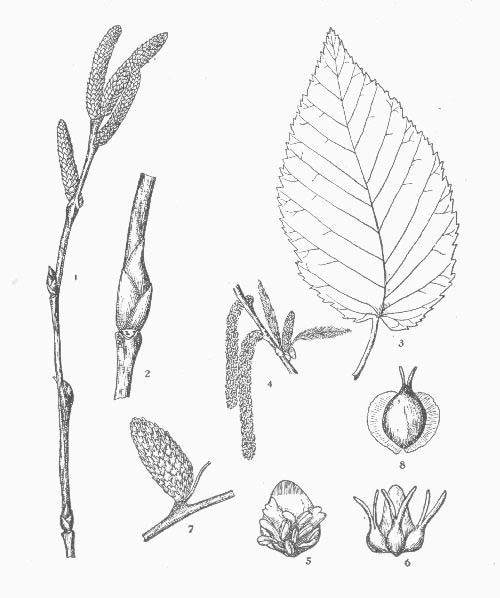
HABIT.—A medium-sized tree 70-80 feet high, with a trunk diameter of 1-3 feet; slender, wide-spreading, pendulous branches, forming a narrow, rounded, open crown.
LEAVES.—Alternate in pairs, simple, 3-4 inches long and one-half as broad; outline variable, ovate to oblong-ovate; sharply doubly serrate, with slender, incurved teeth; dull, dark green above, light yellow-green beneath; petioles short, stout, hairy, deeply grooved above; aromatic.
FLOWERS.—April, before the leaves; monoecious; the staminate catkins 3-4 inches long, slender, pendent, yellowish; the pistillate catkins 1/2-3/4 inch long, erect or suberect, greenish.
FRUIT.—Ripens in autumn; sessile, glabrous, erect strobiles, 1-1-1/2 inches long and half as thick; scales glabrous; nuts slightly broader than their wings.
WINTER-BUDS.—Terminal bud absent; lateral buds about 1/4 inch long, conical, sharp-pointed, red-brown, divergent.
BARK.—Twigs light green, becoming lustrous, red-brown in their first winter; very dark on old trunks, cleaving off in thick, irregular plates. Resembles bark of Black Cherry. Inner bark aromatic, spicy.
WOOD.—Heavy, very hard and strong, close-grained, dark red-brown, with thin, lighter colored sapwood.
DISTRIBUTION.—Scattered throughout the state; rare in the south, more abundant and of larger size in the north.
HABITAT.—Grows in any situation, but prefers moist, rocky slopes and rich uplands.
NOTES.—Hardy throughout its range. Easily transplanted.
Yellow Birch. Gray Birch
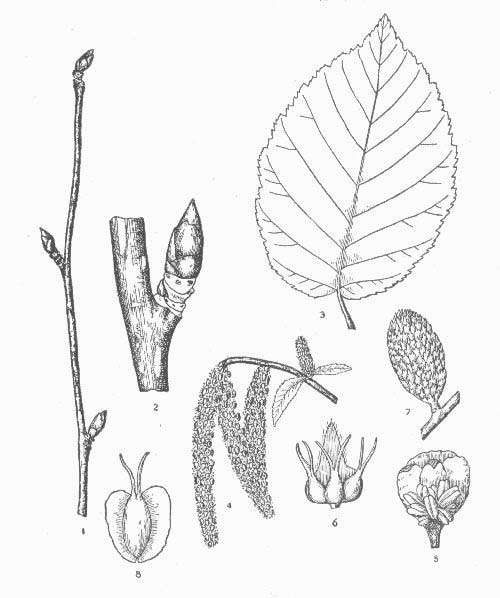
HABIT.—A tree 60-80 feet high and 2-4 feet in trunk diameter; numerous slender, pendulous branches form a broad, open, rounded crown.
LEAVES.—Alternate, solitary or in pairs, simple, 3-5 inches long and one-half as broad; ovate to oblong-ovate; sharply doubly serrate; dull dark green above, yellow-green beneath; petioles short, slender, grooved, hairy; slightly aromatic.
FLOWERS.—April, before the leaves; monoecious; the staminate catkins 3-4 inches long, slender, pendent, purplish yellow; the pistillate catkins sessile or nearly so, erect, almost 1 inch long, greenish.
FRUIT.—Ripens in autumn; sessile or short-stalked, erect, glabrous strobiles, about 1 inch long and half as thick; scales downy on the back and edges; nut about as broad as the wing.
WINTER-BUDS.—Terminal bud absent; lateral buds about 1/4 inch long, conical, acute, chestnut-brown, more or less appressed; bud-scales more or less pubescent.
BARK.—Twigs, branches and young stems smooth, very lustrous, silvery gray or light orange; becoming silvery yellow-gray as the trunk expands and breaking into strips more or less curled at the edges; old trunks becoming gray or blackish, dull, deeply and irregularly fissured into large, thin plates; somewhat aromatic, slightly bitter.
WOOD.—Heavy, very strong and hard, close-grained, light brown tinged with red, with thin, whitish sapwood.
DISTRIBUTION.—Throughout the state, but more abundant and of larger size northward.
HABITAT.—Prefers rich, moist uplands, but grows in wet or dry situations.
NOTES.—One of the largest deciduous-leaved trees of Michigan. Easily transplanted, but not desirable as a street tree.
Paper Birch. Canoe Birch. White Birch
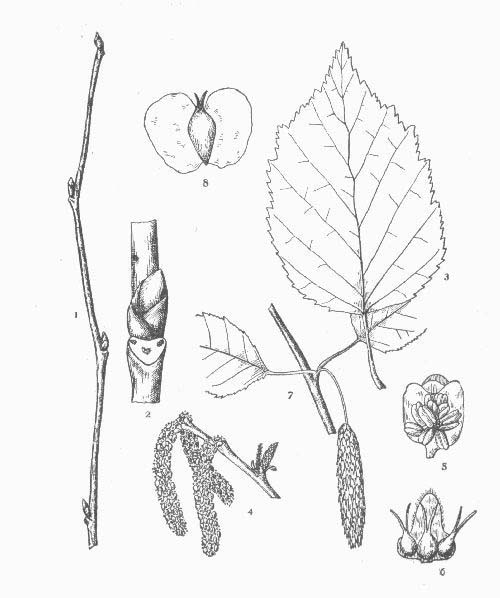
HABIT.—A tree 50-75 feet high, with a trunk diameter of 1-3 feet, forming in youth a compact, pyramidal crown of many slender branches, becoming in old age a long, branchless trunk with a broad, open crown, composed of a few large limbs ascending at an acute angle, with almost horizontal branches and a slender, flexible spray.
LEAVES.—Alternate, simple, 2-3 inches long, 1-1/2-2 inches broad; ovate; coarsely, more or less doubly serrate; thick and firm; glabrous, dark green above, lighter beneath, covered with minute black glands; petioles stout, yellow, glandular, glabrous or pubescent.
FLOWERS.—April, before the leaves; monoecious; the staminate catkins clustered or in pairs, 3-4 inches long, slender, pendent, brownish; the pistillate catkins about 1-1/2 inches long, slender, erect or spreading, greenish; styles bright red.
FRUIT.—Ripens in autumn; long-stalked, cylindrical, glabrous, drooping strobiles, about 1-1/2 inches long; scales hairy on the margin; nut narrower than its wing.
WINTER-BUDS.—Terminal bud absent; lateral buds 1/4 inch long, narrow-ovoid, acute, flattish, slightly resinous, usually divergent.
BARK.—Twigs dull red, becoming lustrous orange-brown; bark of trunk and large limbs cream-white and lustrous on the outer surface, bright orange on the inner, separating freely into thin, papery layers, becoming furrowed and almost black near the ground.
WOOD.—Light, hard, strong, tough, very close-grained, light brown tinged with red, with thick, whitish sapwood.
DISTRIBUTION.—Lansing and northward. Common in central Michigan as a small tree. Of larger size in the Upper Peninsula.
HABITAT.—Prefers rich, moist hillsides; borders of streams, lakes and swamps; but is also found in drier situations.
NOTES.—A rapid grower in youth. The bark is used by the Indians and woodsmen for canoes, wigwams, baskets, torches, etc.
Beech. White Beech
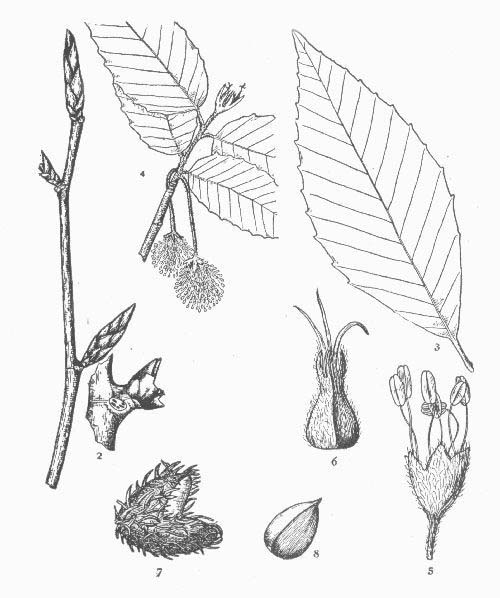
HABIT.—A beautiful tree, rising commonly to a height of 50-75 feet, with a trunk diameter of 2-4 feet; in the forest, tall and slender, with short branches forming a narrow crown, in the open with a short, thick trunk and numerous slender, spreading branches, forming a broad, compact, rounded crown.
LEAVES.—Alternate, simple, 3-5 inches long, one-half as broad; oblong-ovate, acuminate; coarsely serrate, a vein terminating in each tooth; thin; dark blue-green above, light yellow-green and very lustrous beneath; petioles short, hairy.
FLOWERS.—April-May, with the leaves; monoecious; the staminate in globose heads 1 inch in diameter, on long, slender, hairy peduncles, yellow-green; calyx campanulate, 4-7-lobed, hairy; corolla 0; stamens 8-10; the pistillate on short, hairy peduncles in 2-flowered clusters surrounded by numerous awl-shaped, hairy bracts; calyx urn-shaped, 4-5-lobed; corolla 0; ovary 3-celled; styles 3.
FRUIT.—Ripens in autumn; a prickly bur borne on stout, hairy peduncles, persistent on the branch after the nuts have fallen; nuts usually 3, 3/4 inch long, sharply tetrahedral, brownish; sweet and edible.
WINTER-BUDS.—Nearly 1 inch long, very slender, cylindrical, gradually taper-pointed, brownish, puberulous.
BARK.—Twigs lustrous, olive-green, finally changing through brown to ashy gray; close, smooth, steel-gray on the trunk, often mottled by darker blotches and bands.
WOOD.—Hard, tough, strong, very close-grained, not durable, difficult to season, light or dark red, with thin, whitish sapwood.
DISTRIBUTION.—Common in the Lower Peninsula, especially in the northern portions; rare in the Upper Peninsula.
HABITAT.—Prefers deep, rich, well-drained loam, but is found and does well on a great variety of soils.
NOTES.—Hardy throughout its range. Desirable for landscape work because of its clean trunk and limbs, deep shade, and freedom from insect pests. Often suckers from the roots.
Chestnut
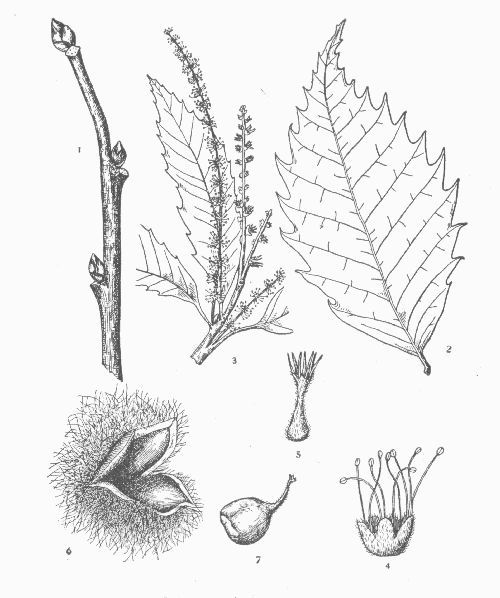
HABIT.—A tree 60-80 feet high, forming a short, straight trunk 2-4 feet in diameter, divided not far above the ground into several stout, horizontal limbs and forming a broad, open, rounded crown.
LEAVES.—Alternate, simple, 6-8 inches long, 2-3 inches broad; oblong-lanceolate, long-pointed at the apex; coarsely serrate with stout, incurved, glandular teeth; thin; dull yellow-green above, lighter beneath, glabrous; petioles short, stout, puberulous.
FLOWERS.—June-July, after the leaves; monoecious; the staminate catkins 6-8 inches long, slender, puberulous, bearing 3-7-flowered cymes of yellow-green flowers; calyx 6-cleft, pubescent; stamens 10-20; the androgynous catkins 2-1/2-5 inches long, puberulous, bearing 2-3 prickly involucres of pistillate flowers near their base; calyx campanulate, 6-lobed; styles 6.
FRUIT.—Ripens in autumn; round, thick, prickly burs, about 2 inches in diameter, containing 1-3 nuts; nuts compressed, brownish, coated with whitish down at the apex; sweet and edible.
WINTER-BUDS.—Terminal bud absent; lateral buds 1/4 inch long, ovoid, acute, brownish.
BARK.—Twigs lustrous, yellow-green, becoming olive-green and finally dark brown; old trunks gray-brown, with shallow fissures and broad, flat ridges.
WOOD.—Light, soft, coarse-grained, weak, easily split, very durable in contact with the soil, red-brown, with very thin, lighter colored sapwood.
DISTRIBUTION.—South-eastern Michigan, as far north as St. Clair County. Abundant in eastern Monroe County and Wayne County.
HABITAT.—Pastures; hillsides; glacial drift; well-drained, gravelly or rocky soil.
NOTES.—A rapid grower and living to a great age. Difficult to transplant. Subject to a disease which threatens extermination in this country.
| a. | Leaves deeply cut or lobed. | |||||
| b. | Leaf-lobes acute, bristle-tipped; fruit maturing in the second season. | |||||
| c. | Lower surface of leaves more or less pubescent, | |||||
| d. | Leaf-lobes usually 7; buds hoary-tomentose; bark of trunk deeply furrowed and scaly; inner bark yellow; cup-scales of acorn hoary-pubescent; nut ovoid; large tree, common in Michigan | Q. velutina, p. 117. | ||||
| dd. | Leaf-lobes usually 3 (at apex of the leaf only); buds rusty-hairy; bark of trunk divided into nearly square plates; inner bark not yellow; cup-scales of acorn rusty-tomentose; nut subglobose; shrubby tree, rare in Michigan | Q. marilandica, p. 119. | ||||
| cc. | Lower surface of leaves glabrous or nearly so. | |||||
| d. | Cup of acorn top-shaped or cup-shaped, inclosing one-third to one-half of the nut. | |||||
| e. | Kernel of nut yellow; buds glabrous, lustrous, slightly angular; inner bark of trunk yellow; trunk provided with pins or stubs of dead branches near the ground | Q. ellipsoidalis, p. 115. | ||||
| ee. | Kernel of nut whitish; buds pubescent above the middle, not angular; inner bark of trunk red; trunk not provided with pins or stubs of branches near the ground | Q. coccinea, p. 113. | ||||
| dd. | Cup of acorn saucer-shaped, inclosing only the base of the nut. | |||||
| e. | Upper surface of leaves usually lustrous, especially on the lower branches; lowermost branches of trees growing in the open drooping nearly to the ground; nut about 1/2 inch long. | Q. palustris, p. 111. | ||||
| ee.[Pg 97] | Upper surface of leaves usually dull; lowermost branches of trees growing in the open not drooping; nut about 1 inch long | Q. rubra, p. 109. | ||||
| bb. | Leaf-lobes rounded, not bristle-tipped; fruit maturing in the first season. | |||||
| c. | Leaves cut nearly to the midrib by a pair of deep sinuses near the middle of the leaf; branches corky-ridged; nut 1/2-1-1/2 inches long, deeply seated in a large, conspicuously fringed | Q. macrocarpa, p. 103. | ||||
| cc. | Leaves not cut by a pair of deep sinuses; branches not corky-ridged; nut about 3/4 inch long, about one-fourth covered by a thin, tomentose, warty cup | Q. alba, p. 101. | ||||
| aa. | Leaves not deeply cut nor lobed. | |||||
| b. | Margin of leaf entire to sinuate-crenate, but not toothed; acorns on stalks 1/2-4 inches long. | |||||
| c. | Margin of leaf entire, or only slightly undulate; acorns on peduncles 1/2 inch long, the nut about 1/2 inch long; bark on branches not breaking into large, papery scales | Q. imbricaria, p. 121. | ||||
| cc. | Margin of leaf sinuate-crenate, rarely lobed; acorns on stems 1-4 inches long, the nut about 1 inch long; bark on branches breaking into large, papery scales which curl back | Q. bicolor, p. 105. | ||||
| bb. | Margin of leaf coarsely toothed; acorns sessile or on stalks less than 1/2 inch long | Q. muhlenbergii, p. 107. | ||||
| a. | Terminal buds usually about 1/8 inch long. | |||||
| b. | Twigs thick-tomentose; entire bud pale-pubescent; branches corky-ridged; cup of acorn conspicuously fringed at the rim. | [1]G Q. macrocarpa, p. 103. | ||||
| bb. | Twigs glabrous; buds glabrous, or only slightly or partially pubescent; branches without corky ridges; cup of acorn not conspicuously fringed at the rim. | |||||
| c. | Bark on branches breaking into large, papery scales which curl back; buds pilose above the middle; acorns on pubescent stems 1-4 inches long. | [1] Q. bicolor, p. 105. | ||||
| cc. | Bark on branches not breaking into large, papery scales; buds glabrous; acorns sessile or very short-stalked. | |||||
| d. | Bark of trunk ash-gray or nearly white, flaky; acorns maturing in autumn of first season; kernel of nut sweet. | |||||
| e. | Buds conical, acute; bud-scales scarious on the margins; nut white-downy at the apex. | [1] Q. muhlenbergii, p. 107. | ||||
| ee. | Buds broadly ovoid, obtuse; bud-scales not scarious on the margins; nut not white-downy at the apex. | [1] Q. alba, p. 101. | ||||
| dd. | Bark of trunk light to dark brown, smoothish or only slightly fissured; acorns maturing in autumn of second season; kernel of nut bitter. | |||||
| e.[Pg 99] | Lateral buds widely divergent; bud-scales scarious on the margins; lowermost branches of trees growing in the open not drooping nearly to the ground. | [2] Q. imbricaria, p. 121. | ||||
| ee. | Lateral buds more or less appressed; bud-scales not scarious on the margins; lowermost branches of trees growing in the open drooping nearly to the ground. | [2] Q. palustris, p. 111. | ||||
| aa. | Terminal buds usually about 1/4 inch long (slightly smaller in Q. ellipsoidalis). | |||||
| b. | Buds conspicuously hairy or tomentose. | |||||
| c. | Buds rusty-hairy, acute at the apex; cup-scales of acorn rusty-tomentose; inner bark of trunk not yellow; shrubby tree, rare in Michigan. | [2] Q. marilandica, p. 119. | ||||
| cc. | Buds hoary-tomentose, obtuse at the apex; cup-scales of acorn hoary-pubescent; inner bark of trunk yellow; large tree, common in Michigan. | [2] Q. velutina, p. 117. | ||||
| bb. | Buds glabrous, or pubescent only above the middle. | |||||
| c. | Buds strictly glabrous throughout, lustrous; inner bark of trunk yellow or whitish. | |||||
| d. | Buds obtuse at the apex; trunk provided with pins or stubs of dead branches near the ground; inner bark of trunk yellow; nut 1/2-3/4 inch long, inclosed for one-third to one-half of its length in a top-shaped cup; kernel of nut yellow. | [2] Q. ellipsoidalis, p. 115. | ||||
| dd. | Buds acute at the apex; trunk not provided with pins or stubs of branches near the ground; inner bark of trunk whitish; nut about 1 inch long, inclosed only at the base by a shallow, saucer-shaped cup; kernel of nut white. | [2] Q. rubra, p. 109. | ||||
| cc. | Buds pale-pubescent above the middle, but usually glabrous below, not lustrous; inner bark of trunk red. | [2] Q. coccinea, p. 113. | ||||
White Oak
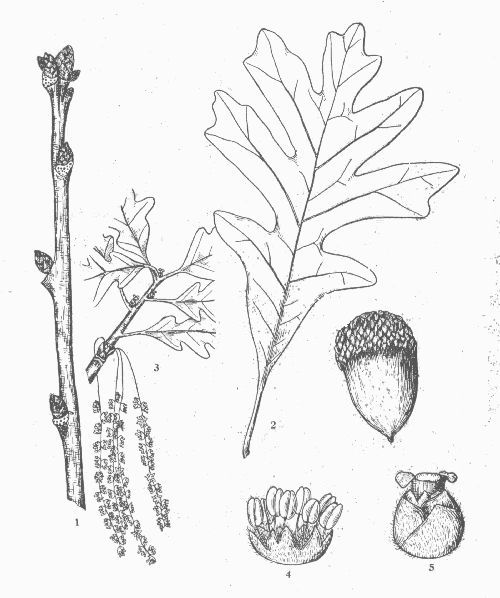
HABIT.—A large tree 60-80 feet high, with a trunk diameter of 2-4 feet; forming a short, thick trunk with stout, horizontal, far-reaching limbs, more or less gnarled and twisted in old age, and a broad, open crown.
LEAVES.—Alternate, simple, 5-9 inches long, about one-half as broad; obovate to oblong; 5-9-lobed, some with broad lobes and shallow sinuses, others with narrow lobes and deep, narrow sinuses, the lobes usually entire; thin and firm; glabrous, bright green above, pale or glaucous beneath; often persistent on the tree through the winter.
FLOWERS.—May, with the leaves; monoecious; the staminate in hairy catkins 2-3 inches long; the pistillate sessile or short-peduncled, reddish, tomentose; calyx campanulate, 6-8-lobed, yellow, hairy; corolla 0; stamens 6-8, with yellow anthers; stigmas red.
FRUIT.—Autumn of first season; sessile or short-stalked acorns; cup with small, brown-tomentose scales, inclosing one-fourth of the nut; nut oblong-ovoid, rounded at the apex, about 3/4 inch long, light brown; kernel sweet and edible.
WINTER-BUDS.—Terminal bud 1/8 inch long, broadly ovoid, obtuse; scales smooth, dark red-brown.
BARK.—Twigs at first bright green, tomentose, later reddish, and finally ashy gray; thick, light gray or whitish on old trunks, shallowly fissured into broad, flat ridges.
WOOD.—Very heavy, strong, hard, tough, close-grained, durable, light brown, with thin, light brown sapwood.
DISTRIBUTION.—Rare in the Upper Peninsula, common in the Lower Peninsula, especially in the lower half.
HABITAT.—Grows well in all but very wet soils, in all open exposures.
NOTES.—Slow and even of growth. Difficult to transplant.
Bur Oak
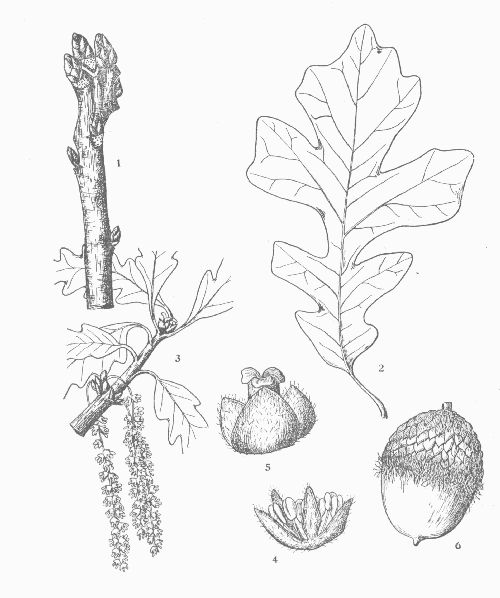
HABIT.—A large tree 60-80 feet high, with a trunk 2-4 feet in diameter; great, spreading branches form a broad, rugged crown.
LEAVES.—Alternate, simple, 6-10 inches long and one-half as broad; obovate to oblong, wedge-shaped at the base; crenately lobed, usually cut nearly to the midrib by two opposite sinuses near the middle; thick and firm; dark green and shining above, pale-pubescent beneath; petioles short, stout.
FLOWERS.—May, with the leaves; monoecious; the staminate in slender, hairy catkins 4-6 inches long; the pistillate sessile or short-stalked, reddish, tomentose; calyx 4-6-lobed, yellow-green, downy; corolla 0; stamens 4-6, with yellow anthers; stigmas bright red.
FRUIT.—Autumn of first season; sessile or short-stalked acorns; very variable in size and shape; cup typically deep, cup-shaped, tomentose, fringed at the rim, inclosing one-third or all of the nut; nut broad-ovoid, 1/2-1-1/2 inches long, brownish, pubescent; kernel white, sweet and edible.
WINTER-BUDS.—Terminal bud 1/8 inch long, broadly ovoid or conical, red-brown, pale-pubescent.
BARK.—Twigs yellow-brown, thick-tomentose, becoming ash-gray or brownish; branches with corky ridges; thick and gray-brown on the trunk, deeply furrowed.
WOOD.—Heavy, hard, strong, tough, close-grained, very durable, brownish, with thin, pale sapwood.
DISTRIBUTION.—Common throughout both peninsulas.
HABITAT.—Prefers rich, moist soil; bottom-lands; but is tolerant of many soils.
NOTES.—Rather slow of growth. Difficult to transplant.
Swamp White Oak. Swamp Oak
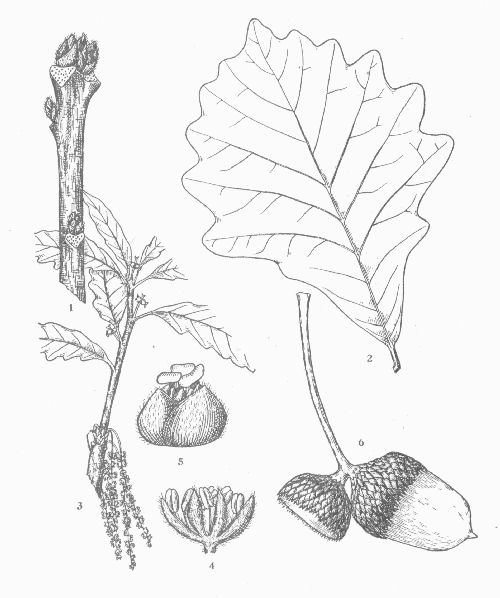
HABIT.—A large tree 50-70 feet high, with a trunk diameter of 2-3 feet; forming a rather open, rugged crown of tortuous, pendulous branches and short, stiff, bushy spray.
LEAVES.—Alternate, simple, 5-7 inches long, 3-5 inches broad; obovate to oblong-obovate; coarsely sinuate-crenate or shallow-lobed; thick and firm; dark green and shining above, whitish and more or less tomentose beneath; petioles stout, about 1/2 inch long.
FLOWERS.—May, with the leaves; monoecious; the staminate in hairy catkins 3-4 inches long; the pistillate tomentose, on long, tomentose peduncles, in few-flowered spikes; calyx deeply 5-9-lobed, yellow-green, hairy; corolla 0; stamens 5-8, with yellow anthers; stigmas bright red.
FRUIT.—Autumn of first season; acorns on pubescent stems 1-4 inches long, usually in pairs; cup cup-shaped, with scales somewhat loose (rim often fringed), inclosing one-third of the nut; nut ovoid, light brown, pubescent at the apex, about 1 inch long; kernel white, sweet, edible.
WINTER-BUDS.—Terminal bud 1/8 inch long, broadly ovoid to globose, obtuse; scales light brown, pilose above the middle.
BARK.—Twigs at first lustrous, green, becoming red-brown, finally dark brown and separating into large, papery scales which curl back; thick, gray-brown on the trunk, deeply fissured into broad, flat, scaly ridges.
WOOD.—Heavy, hard, strong, tough, coarse-grained, light brown, with thin, indistinguishable sapwood.
DISTRIBUTION.—Southern half of Lower Peninsula.
HABITAT.—Prefers moist, rich soil bordering swamps and along streams.
NOTES.—Fairly rapid in growth and reasonably easy to transplant.
Chinquapin Oak. Chestnut Oak. Yellow Oak
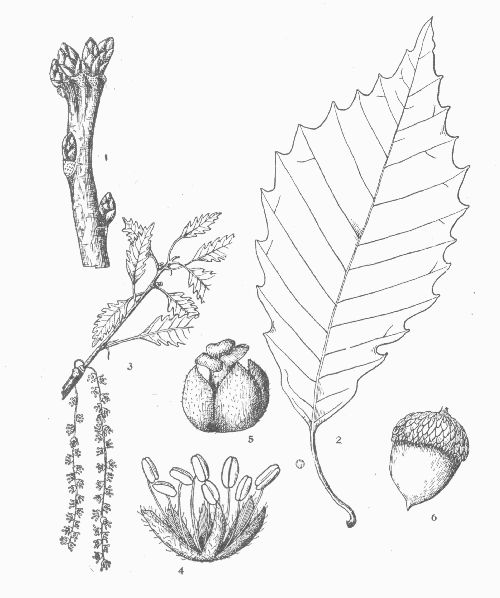
HABIT.—A medium-sized tree 40-50 feet high, with a trunk diameter of 1-3 feet; erect, somewhat short branches form a narrow, rounded crown.
LEAVES.—Alternate, simple, 4-7 inches long, 1-4 inches broad; oblong-lanceolate to obovate; coarsely toothed; thick and firm; lustrous, yellow-green above, pale-pubescent beneath; petioles slender, about 1 inch long.
FLOWERS.—May, with the leaves; monoecious; the staminate in hairy catkins 3-4 inches long; the pistillate sessile or in short spikes, hoary-tomentose; calyx campanulate, 5-8-lobed, yellow, hairy; corolla 0; stamens 5-8, with yellow anthers; stigmas red.
FRUIT.—Autumn of first season; sessile or short-stalked acorns; cup with small scales, hoary-tomentose, inclosing one-half of the nut; nut ovoid, about 3/4 inch long, light brown; kernel sweet, sometimes edible.
WINTER-BUDS.—Terminal bud 1/8 inch long, conical, acute; scales chestnut-brown, scarious on the margin.
BARK.—Twigs greenish at first, becoming gray-brown, finally gray or brown; thin, silvery gray or ash colored and flaky on the trunk.
WOOD.—Heavy, very hard, strong, close-grained, durable, dark brown, with thin, pale brown sapwood.
DISTRIBUTION.—Confined to the southern half of the Lower Peninsula.
HABITAT.—Prefers a limestone soil; dry hillsides; rich bottom-lands; rocky river-banks.
NOTES.—Grows uniformly until maturity. Leaves resemble those of the Chestnut. A form which differs from the type in having broader, obovate leaves broadest above the middle and a flaky bark has been described and named Quercus Alexanderi Britton.
Red Oak
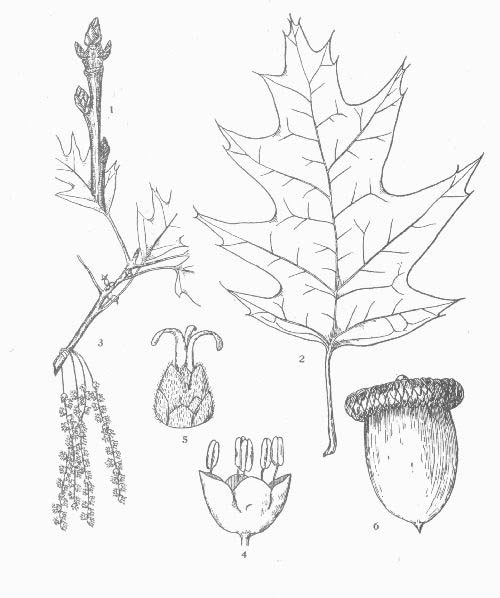
HABIT.—A large tree 70-80 feet high, with a trunk diameter of 2-4 feet; forming a broad, rounded crown of a few large, wide-spreading branches and slender branchlets.
LEAVES.—Alternate, simple, 5-9 inches long, 4-6 inches broad; oval to obovate; 5-11-lobed with coarse-toothed, bristle-tipped lobes tapering from broad bases and wide, oblique, rounded sinuses; thin and firm; dull dark green above, paler beneath; petioles stout, 1-2 inches long.
FLOWERS.—April-May, when the leaves are half grown; monoecious; the staminate in hairy catkins 4-5 inches long; the pistillate on short, glabrous peduncles; calyx 4-5-lobed, greenish; corolla 0; stamens 4-5, with yellow anthers; stigmas long, spreading, bright green.
FRUIT.—Autumn of second season; sessile or short-stalked acorns; cup shallow, saucer-shaped, inclosing only the base of the nut; scales closely appressed, more or less glossy, puberulous, bright red-brown; nut oblong-ovoid with a broad base, about 1 inch long, red-brown; kernel white, very bitter.
WINTER-BUDS.—Terminal bud 1/4 inch long, ovoid, acute, light brown, smooth.
BARK.—Twigs lustrous, green, becoming reddish, finally dark brown; young trunks smooth, gray-brown; old trunks darker, shallowly fissured into thin, firm, broad ridges; inner bark light red, not bitter.
WOOD.—Heavy, hard, strong, coarse-grained, light red-brown, with thin, darker colored sapwood.
DISTRIBUTION.—Southern portion of Lower Peninsula as far north as Roscommon County.
HABITAT.—Prefers rich, moist loam; glacial drift; stream-banks. Grows well in all well-drained soils.
NOTES.—Grows rapidly. A good street tree.
Pin Oak
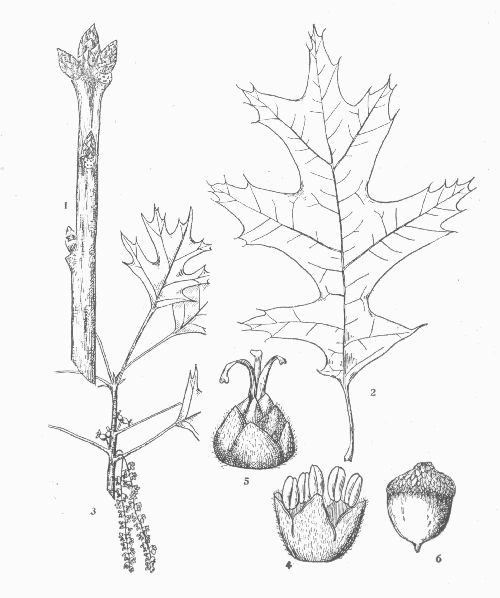
HABIT.—A medium-sized tree 40-50 feet high, with a trunk diameter of 1-2 feet; forming an oblong or pyramidal crown of many upright, spreading branches, the lowermost drooping nearly to the ground.
LEAVES.—Alternate, simple, 4-6 inches long, 2-4 inches broad; obovate to ovate; 5-7-lobed by deep, wide, rounded sinuses, the lobes few-toothed, bristle-tipped; thin and firm; very lustrous, dark green above, paler beneath; petioles slender.
FLOWERS.—May, with the leaves; monoecious; the staminate in hairy catkins 2-4 inches long; the pistillate tomentose, borne on short, tomentose peduncles; calyx 4-5-lobed, hairy; corolla 0; stamens 4-5, with yellow anthers; stigmas recurved, bright red.
FRUIT.—Autumn of second season; sessile or short-stalked acorns; cup saucer-shaped with scales closely appressed, dark red-brown, inclosing only the base of the nut; nut nearly hemi-spherical, about 1/2 inch in diameter, light brown; kernel bitter.
WINTER-BUDS.—Terminal bud 1/8 inch long, ovoid or conical, acute, light brown, smooth.
BARK.—Twigs dark red and tomentose at first, becoming lustrous, green, finally gray-brown; thick, gray-brown and smoothish on the trunk.
WOOD.—Heavy, hard, strong, coarse-grained, light brown, with thin, darker colored sapwood.
DISTRIBUTION.—Confined to the most southern portions of the Lower Peninsula.
HABITAT.—Prefers moist, rich soil; river-bottoms; borders of swamps.
NOTES.—Grows rapidly and uniformly. Easily transplanted. The tiny branchlets at a distance give the impression of the tree being full of pins.
Scarlet Oak
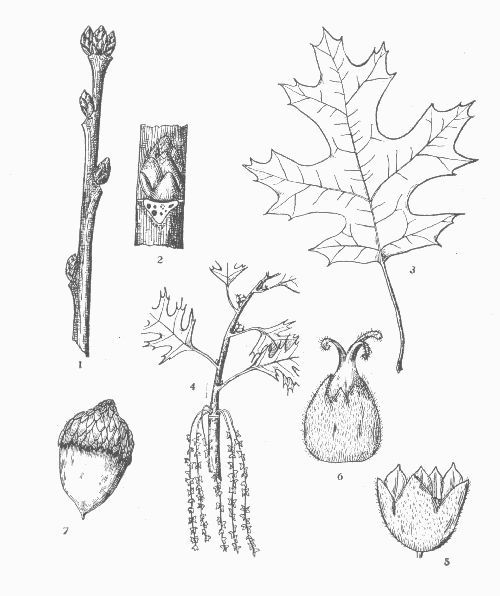
HABIT.—A tree 40-50 feet high and 12-15 inches in trunk diameter; long, slender branches form a rather open, rounded crown.
LEAVES.—Alternate, simple, 3-6 inches long and nearly as broad; broadly obovate to oval; 5-9-lobed by deep, wide, rounded sinuses, the lobes toothed and bristle-tipped; thin and firm; shining, bright green above, paler beneath, both sides glabrous; turning brilliant scarlet in autumn; petioles slender, 1-2 inches long.
FLOWERS.—May, with the leaves; monoecious; the staminate in glabrous catkins 3-4 inches long; the pistillate on pubescent peduncles 1/2 inch long, bright red, pubescent; calyx 4-5-lobed, reddish, pubescent; corolla 0; stamens usually 4, with yellow anthers; stigmas long, spreading, bright red.
FRUIT.—Autumn of second season; sessile or short-stalked acorns; cup top-shaped to cup-shaped, with closely imbricated, slightly puberulous, red-brown scales, inclosing about one-half of the nut; nut usually short-ovoid, 1/2-3/4 inch long, light red-brown; kernel whitish, bitter.
WINTER-BUDS.—Terminal bud about 1/4 inch long, broadly ovoid, acute, dark red-brown, pale-pubescent above the middle.
BARK.—Twigs at first scurfy-pubescent, later lustrous, green, finally smooth, light brown; thick, dark gray or brown on old trunks, shallowly fissured, scaly; inner bark red, not bitter.
WOOD.—Heavy, hard, strong, coarse-grained, light red-brown, with thick, darker brown sapwood.
DISTRIBUTION.—Lower Peninsula, southern half.
HABITAT.—Prefers a light, dry, sandy soil.
NOTES.—Rapid of growth. Desirable for ornamental planting.
Hill’s Oak. Northern Pin Oak. Black Oak
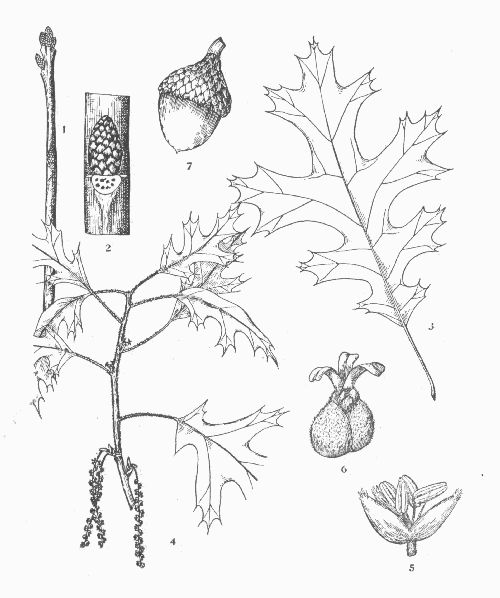
HABIT.—A tree 50-60 feet high, with a short trunk 2-3 feet in diameter; forming a rather narrow, oblong crown of upright and horizontal branches. Many small, drooping branches are sent out near the ground, which eventually die; and it is to the stubs or pins which persist about the trunk that the appelation Pin Oak is due.
LEAVES.—Alternate, simple, 3-7 inches long and about as broad; oval to nearly orbicular; narrowly 5-7-lobed by deep, wide, rounded sinuses, the lobes few-toothed, bristle-tipped; thin and firm; lustrous, bright green above, paler beneath, both sides glabrous except for the tufts of hairs in the axils of the veins beneath; petioles slender, glabrous.
FLOWERS.—May, with the leaves; monoecious; the staminate in puberulous catkins 2-3 inches long; the pistillate red, tomentose, borne on stout, tomentose, 1-3-flowered peduncles; calyx 2-5-lobed or-parted, glabrous except at the apex, which is fringed with long, twisted hairs; corolla 0; stamens 2-5, with short filaments; stigmas 3, recurved, dark red.
FRUIT.—Autumn of second season; short-stalked or nearly sessile acorns; cup top-shaped, with scales thin, puberulous, inclosing one-third to one-half of the nut; nut ellipsoid, 1/2-3/4 inch long, light brown, puberulous; kernel yellow, bitter.
WINTER-BUDS.—Terminal bud 1/8-1/4 inch long, ovoid, rather obtuse, slightly angular, lustrous, red-brown.
BARK.—Twigs bright red-brown, covered with matted, pale hairs, becoming glabrous, dark gray or brown; thin, dull gray to dark brown, rather smooth or closely ribbed on the trunk; inner bark yellow.
WOOD.—Heavy, hard, strong, coarse-grained, red-brown, with thin, paler sapwood.
DISTRIBUTION.—South-western part of the Lower Peninsula, but limits not definitely known.
HABITAT.—Well-drained uplands, especially on clays; occasionally on the borders of ponds and in low woods.
NOTES.—A new and comparatively little known species.
Yellow Oak. Black Oak
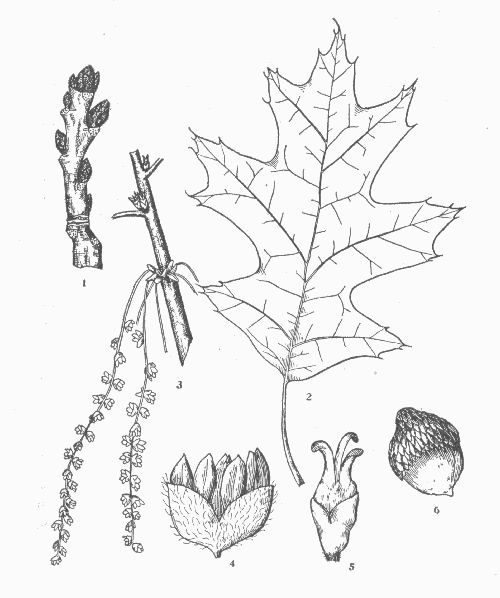
HABIT.—A medium-sized tree 50-60 feet high and 1-3 feet in trunk diameter; slender branches and stout branchlets form a wide-spreading, rounded crown.
LEAVES.—Alternate, simple, 5-10 inches long, 3-8 inches broad; ovate to oblong; usually 7-lobed, some with shallow sinuses and broad, rounded, mucronate lobes, others with wide, rounded sinuses extending half-way to the midrib or farther and narrow-oblong or triangular, bristle-tipped lobes, the lobes more or less coarse-toothed, each tooth bristle-tipped; thick and leathery; dark green and shining above, pale and more or less pubescent beneath; petioles stout, yellow, 3-6 inches long.
FLOWERS.—May, when the leaves are half grown; monoecious; the staminate in pubescent catkins 4-6 inches long; the pistillate reddish, on short, tomentose peduncles; calyx acutely 3-4-lobed, reddish, hairy; corolla 0; stamens usually 4-5, with acute, yellow anthers; stigmas 3, divergent, red.
FRUIT.—Autumn of second season; sessile or short-stalked acorns; cup cup-shaped or turbinate, inclosing about one-half of the nut; scales thin, light brown, hoary; nut ovoid, 1/2-3/4 inch long, red-brown, often pubescent; kernel yellow, bitter.
WINTER-BUDS.—Terminal bud 1/4 inch long, ovoid to conical, obtuse, strongly angled, hoary-tomentose.
BARK.—Twigs at first scurfy-pubescent, later glabrous, red-brown, finally mottled gray; thick and nearly black on old trunks, deeply furrowed and scaly; inner bark thick, yellow, very bitter.
WOOD.—Heavy, hard, strong, coarse-grained, bright red-brown, with thin, paler sapwood.
DISTRIBUTION.—Southern half of the Lower Peninsula.
HABITAT.—Prefers glacial drift; dry or gravelly uplands; poor soils.
NOTES.—Rapid of growth. Undesirable for street use.
Black Jack
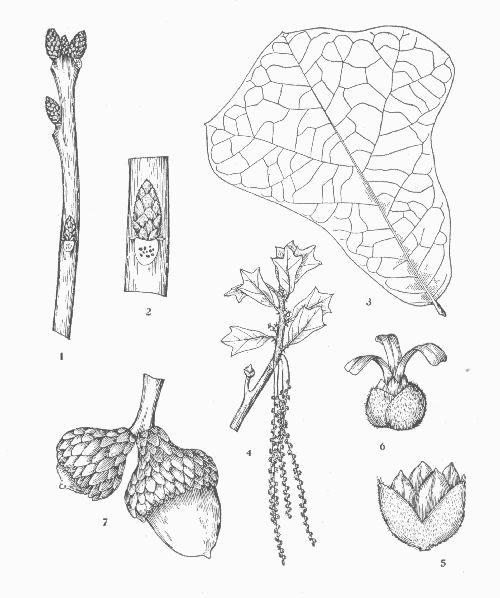
HABIT.—A small, shrubby tree 20-30 feet high, with a trunk diameter of 6-14 inches; spreading, often contorted branches form a rounded or obovoid crown.
LEAVES.—Alternate, simple, 5-7 inches long and broad; broad-obovate; more or less 3-lobed at the apex, the lobes entire or toothed, bristle-tipped, very variable in size and shape; thick and leathery; very lustrous and dark green above, yellowish and scurfy-pubescent beneath; petioles short, stout.
FLOWERS.—May, with the leaves; monoecious; the staminate in slender, hoary catkins 2-4 inches long; the pistillate rusty-tomentose, on short, rusty-tomentose peduncles; calyx 4-5-lobed, thin, scarious, tinged with red, pale-pubescent; corolla 0; stamens 4, with apiculate, red anthers; stigmas recurved, dark red.
FRUIT.—Autumn of second season; short-stalked acorns; cup turbinate, with large, red-brown, rusty-tomentose scales, inclosing about one-half of the nut; nut subglobose, about 3/4 inch long, yellow-brown, puberulous; kernel yellowish.
WINTER-BUDS.—Terminal bud 1/4 inch long, ovoid, acute, prominently angled; scales light red-brown, rusty-hairy.
BARK.—Twigs at first light red and scurfy, later glabrous, red-brown, and finally brown or ashy gray; thick and almost black on the trunk, divided into nearly square plates.
WOOD.—Heavy, hard, strong, dark brown, with thick, lighter colored sapwood.
DISTRIBUTION.—Southern Michigan (Ann Arbor and Lansing).
HABITAT.—Dry, sandy or clay barrens.
NOTES.—Rare in Michigan.
Shingle Oak
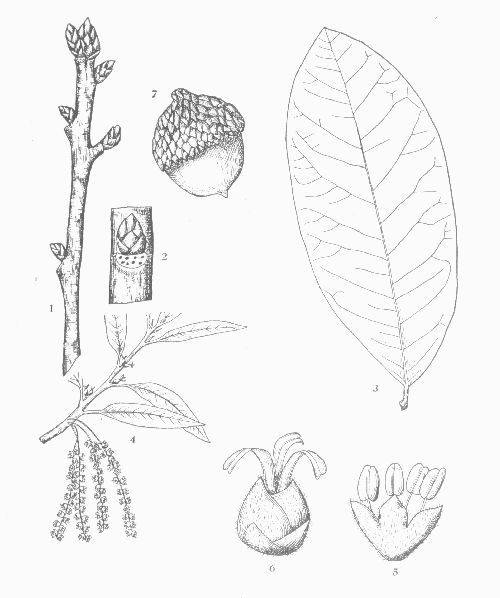
HABIT.—A tree 40-50 feet high, with a trunk diameter of 1-2 feet; forming a rather open, rounded crown of slender, horizontal branches.
LEAVES.—Alternate, simple, 4-6 inches long, 1-2 inches broad; oblong-lanceolate to oblong-obovate; entire or somewhat undulate; thin, very lustrous, dark green above, paler and pubescent beneath; petioles stout, pubescent, 1/2 inch long.
FLOWERS.—May, with the leaves; monoecious; the staminate in slender, hoary-tomentose catkins 2-3 inches long; the pistillate on slender, tomentose peduncles; calyx 4-lobed, yellow, downy; corolla 0; stamens 4-5, with yellow anthers; stigmas short, recurved, greenish yellow.
FRUIT.—Autumn of second season; acorns on stout peduncles 1/2 inch long; cup cup-shaped, with red-brown, downy scales, inclosing one-third to one-half of the nut; nut subglobose, about 1/2 inch long, dark brown, often striate; kernel very bitter.
WINTER-BUDS.—Terminal bud 1/8 inch long, ovoid, acute, lustrous, brown.
BARK.—Twigs lustrous, dark green, becoming brown; thick on old trunks, light brown and slightly fissured.
WOOD.—Heavy, hard, coarse-grained, light red-brown, with thin, lighter colored sapwood.
DISTRIBUTION.—Of rare occurrence in Michigan. Reported in Kalamazoo, St. Joseph and Washtenaw Counties, Lower Peninsula.
HABITAT.—Rich uplands; fertile river-bottoms.
NOTES.—Desirable for ornamental uses. Hardy. Rapid of growth.
| a. | Leaves essentially smooth on both sides; branches often with corky, wing-like ridges; lowermost branches usually short and strongly drooping; main trunk usually continuous into the crown without dividing, giving to the tree a narrow-oblong outline. | U. racemosa, p. 129. | |
| aa. | Leaves usually rough on one or on both sides; branches without corky ridges; lowermost branches not short, not strongly drooping; main trunk usually dividing into several large limbs, giving to the tree a more or less vase-shaped outline. | ||
| b. | Leaves usually rough above, but smooth beneath, with petioles glabrous; bark of trunk gray, deeply fissured into broad, scaly ridges; inner bark not mucilaginous. | U. americana, p. 127. | |
| bb. | Leaves usually rough both sides, with petioles hairy; bark of trunk dark red-brown, shallowly fissured into large, loose plates; inner bark mucilaginous. | U. fulva, p. 125. | |
| a. | Buds conspicuously rusty-tomentose; twigs more or less pubescent; inner bark very mucilaginous when chewed. | U. fulva, p. 125. | |
| aa. | Buds not conspicuously rusty-tomentose; twigs glabrous; inner bark not mucilaginous. | ||
| b. | Bundle-scars usually 3; buds 1/8 inch long, glabrous; twigs without corky ridges; outline of tree vase-shaped. | U. americana, p. 127. | |
| bb. | Bundle-scars usually 4-6 in a curved line; buds 1/4 inch long, somewhat pilose; twigs often with corky ridges; outline of tree narrow-oblong. | U. racemosa, p. 129. | |
Slippery Elm. Red Elm
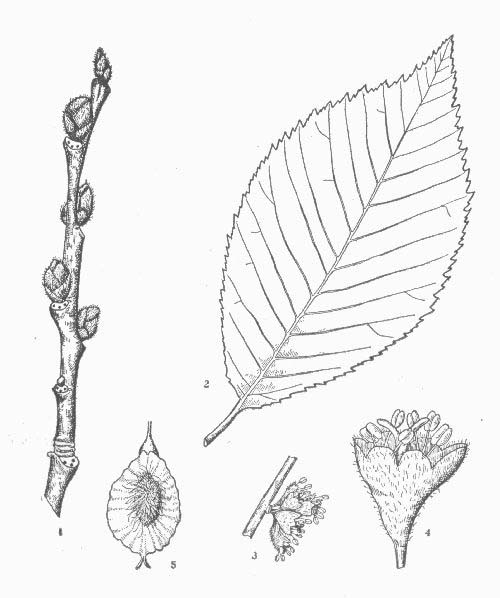
HABIT.—A medium-sized tree 40-60 feet high, with a short trunk 1-2 feet in diameter; spreading branches form a broad, open, flat-topped crown.
LEAVES.—Alternate, simple, 4-7 inches long, about one-half as broad; ovate-oblong; coarsely doubly serrate; thick and firm; dark green and rough above, paler and somewhat rough beneath; petioles short, stout, hairy.
FLOWERS.—March-April, before the leaves; mostly perfect; borne on short pedicels in crowded fascicles; calyx campanulate, 5-9-lobed, green, hairy; corolla 0; stamens 5-9, with dark red anthers; stigmas 2, reddish purple.
FRUIT.—May; semi-orbicular, 1-seeded samaras, short-stalked in dense clusters; seed cavity brown-tomentose; wings smooth, nearly 3/4 inch long.
WINTER-BUDS.—Terminal bud absent; lateral buds ovoid, obtuse, dark brown, rusty-tomentose, 1/4 inch long.
BARK.—Twigs at first bright green and pubescent, becoming light to dark brown or grayish; thick on old trunks, dark red-brown, shallowly fissured into large, loose plates; inner bark mucilaginous.
WOOD.—Heavy, hard, strong, very close-grained, durable, easy to split while green, dark red-brown, with thin, lighter colored sapwood.
DISTRIBUTION.—Of frequent occurrence throughout the state.
HABITAT.—Prefers stream-banks and bottom-lands; rich, moist hillsides; rocky ridges and slopes.
NOTES.—Grows more rapidly than U. americana.
White Elm. American Elm. Water Elm
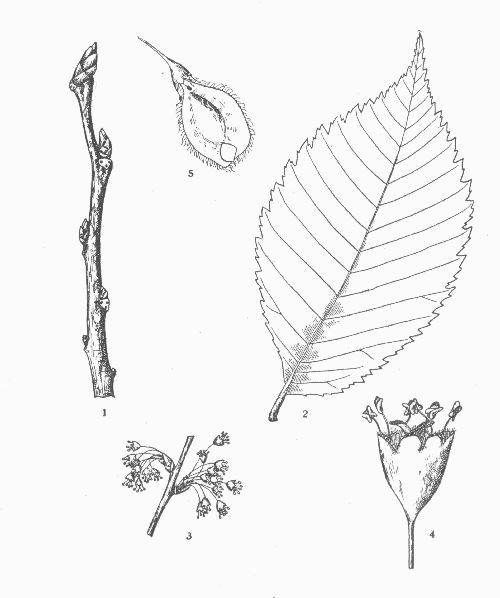
HABIT.—A tree 75-100 feet high, with a trunk diameter of 2-6 feet; commonly dividing 20-30 feet above the ground into a few large branches which rise upward and outward to form a vase-shaped outline.
LEAVES.—Alternate, simple, 4-6 inches long, one-half as broad; obovate-oblong to oval; coarsely doubly serrate; thick and firm; dark green and rough above, pale and pubescent or glabrous beneath; petioles short and stout.
FLOWERS.—March-April, before the leaves; mostly perfect; small, brown to red; borne on slender pedicels in loose fascicles; calyx campanulate, 5-9-lobed; corolla 0; stamens 4-9, with bright red anthers; ovary 2-celled; styles 2, green.
FRUIT.—May; ovate, 1-seeded samaras, smooth both sides, hairy on the margin, 1/2 inch long, long-stemmed in crowded clusters.
WINTER-BUDS.—Terminal bud absent; lateral buds ovoid, acute, flattened, glabrous, brown, 1/8 inch long.
BARK.—Twigs at first light green and downy, becoming glabrous, red-brown, finally ash-gray; on old trunks thick, ash-gray, deeply fissured into broad, scaly ridges.
WOOD.—Heavy, hard, strong, tough, difficult to split, coarse-grained, light brown, with thick, lighter colored sapwood.
DISTRIBUTION.—Common throughout the state.
HABITAT.—Prefers deep, rich, moist loam; bottom-lands; stream-banks.
NOTES.—Grows rapidly. Long-lived. The roots run along near the surface of the ground for a great distance. An ideal street tree.
Cork Elm. Rock Elm
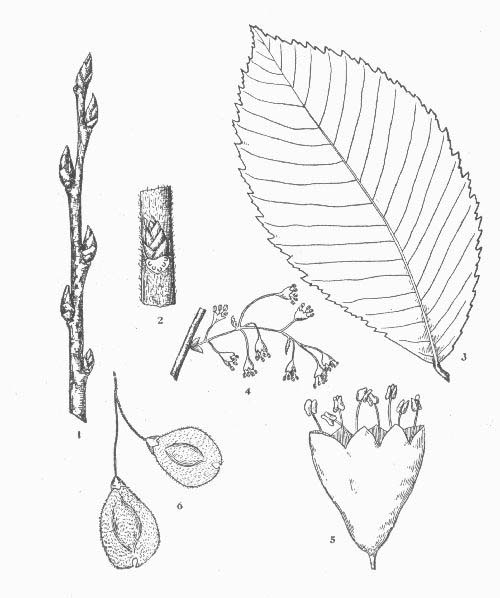
HABIT.—A large tree sometimes reaching a height of 100 feet and a trunk diameter of 5 feet, but usually somewhat smaller; strongly drooping lateral and lower branches form a narrow, oblong crown.
LEAVES.—Alternate, simple, 3-6 inches long, one-half as broad; obovate to oblong-oval, more or less dished; coarsely doubly serrate; thick and firm; lustrous, dark green above, pale-pubescent beneath; petioles pubescent, 1/4 inch long.
FLOWERS.—March-April, before the leaves; mostly perfect; greenish; borne on slender, drooping pedicels in loose racemes; calyx campanulate, 7-8-lobed; corolla 0; stamens 7-8, with purple anthers; ovary hairy, 2-styled.
FRUIT.—May; ovate, 1-seeded samaras, pubescent all over, 1/2 inch long.
WINTER-BUDS.—Terminal bud absent; lateral buds ovoid, acute, brown, pilose, 1/4 inch long.
BARK.—Twigs at first light brown and pubescent, becoming lustrous, red-brown, finally gray-brown with corky, wing-like ridges; thick and grayish on the trunk, with wide fissures separating broad, flat, scaly ridges.
WOOD.—Heavy, very strong and tough, close-grained, light red-brown, with thick, lighter colored sapwood.
DISTRIBUTION.—Frequent in the southern third of the Lower Peninsula.
HABITAT.—Dry, gravelly uplands; rocky ridges and slopes; heavy clay soils; river-banks.
NOTES.—A good street tree, but less graceful in habit than U. americana.
Hackberry. Nettle-tree
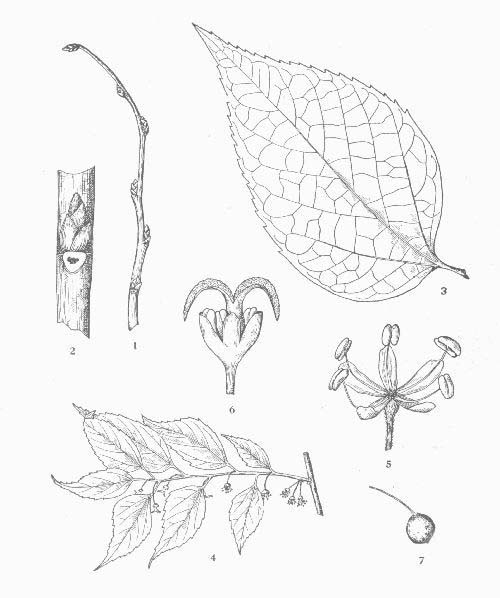
HABIT.—A medium-sized tree, 40-60 feet high, with a short, straight trunk 1-2 feet in diameter which branches a few feet from the ground into a few large limbs and many slender, horizontal, zigzag branches, forming a broad, rounded crown.
LEAVES.—Alternate, simple, 2-4 inches long and one-half as broad; ovate to ovate-lanceolate, oblique at the base, usually long-pointed; coarsely serrate above the entire base; thin; glabrous, light green above, paler beneath, turning light yellow late in autumn; petioles short, slender, hairy.
FLOWERS.—May, with or soon after the leaves; polygamo-monoecious; greenish; inconspicuous; on slender pedicels; the staminate in clusters at the base of the shoot, the pistillate usually solitary in the axils of the upper leaves; calyx greenish, deeply 5-lobed; corolla 0; stamens 5; ovary 1-celled.
FRUIT.—September-October, remaining on the tree through the winter; slender-stalked, fleshy, globular drupes, 1/4 inch long, dark purple; edible.
WINTER-BUDS.—Terminal bud absent; lateral buds light brown, 1/4 inch long, ovoid, acute, flattened, the tip appressed.
BARK.—Twigs greenish, puberulous, becoming lustrous, red-brown in their first winter; on old trunks thick, light brown or silvery gray, broken into deep, short ridges or warty excrescences.
WOOD.—Heavy, soft, coarse-grained, weak, light yellow, with thick, whitish sapwood.
DISTRIBUTION.—Common throughout the Lower Peninsula.
HABITAT.—Prefers rich, moist, well-drained soil, but will grow on gravelly or rocky hillsides. Common along river-banks.
NOTES.—Hardy throughout its range. Grows slowly and irregularly in youth. Easily transplanted. Not desirable as a street tree, but appears well in ornamental grounds. Very tolerant of shade.
Osage Orange
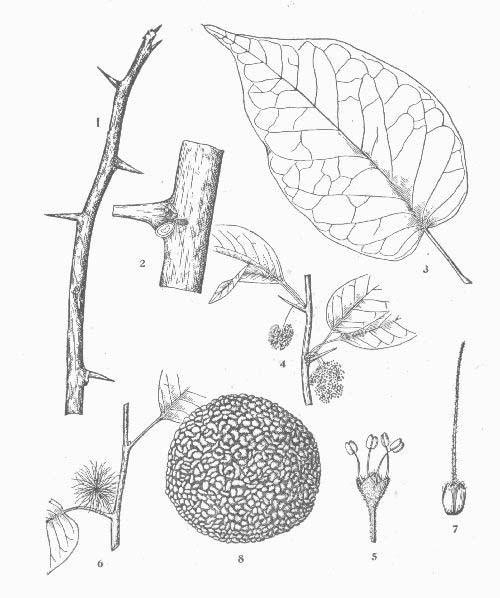
HABIT.—A tree 20-30 feet high, with a short trunk 1-2 feet in diameter; divides into a few large limbs with curving branches, forming a symmetrical, rounded crown.
LEAVES.—Alternate, simple, 3-5 inches long, 2-3 inches broad; ovate to oblong-lanceolate; entire; thick and firm; dark green and shining above, paler beneath; petioles slender, pubescent, 1-1/2-2 inches long.
FLOWERS.—June, after the leaves; dioecious; the staminate slender-pedicelled, borne in a dense raceme at the end of long, slender, drooping peduncles; the pistillate in dense, globose heads at the end of short, stout peduncles; calyx 4-lobed, hairy; corolla 0; stamens 4; style covered with white, stigmatic hairs.
FRUIT.—Autumn; pale green, orange-like, 4-5 inches in diameter, composed of numerous small drupes, crowded and grown together.
WINTER-BUDS.—Terminal bud absent; lateral buds depressed-globular, partly hidden in the bark, pale brown.
BARK.—Twigs at first bright green, pubescent, becoming orange-brown and armed with stout, straight, axillary spines; dark orange-brown on the trunk and deeply furrowed.
WOOD.—Heavy, very hard and strong, flexible, coarse-grained, very durable, bright orange, with thin, lemon colored sapwood.
NOTES.—A native of the South, but hardy throughout Michigan. A desirable ornamental tree. Extensively planted for hedges.
Red Mulberry
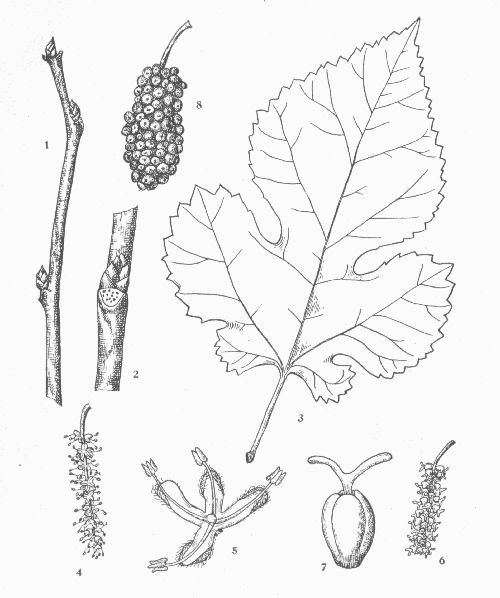
HABIT.—A small tree 20-30 feet high, with a short trunk 10-15 inches in diameter; forming a dense, round-topped crown of stout, spreading branches and more or less zigzag, slender branchlets.
LEAVES.—Alternate, simple, 3-5 inches long, nearly as broad; outline variable, ovate to semi-orbicular, often 3-5-lobed; coarsely serrate; thin; dark blue-green and smooth or rough above, pale and more or less downy beneath; petioles 1-2 inches long, smooth, exuding a milky juice when cut.
FLOWERS.—May, with the leaves; monoecious or dioecious; the staminate in dense spikes 1-2 inches long, on short, hairy peduncles; the pistillate in dense spikes about 1 inch long, on short, hairy peduncles; calyx 4-lobed, hairy; corolla 0; stamens 4, with green anthers; stigmas 2, spreading.
FRUIT.—July; 1 inch long; consisting of drupes about 1/32 inch long, each inclosed in a thickened, fleshy calyx; berry-like; bright red at first, finally blackish; sweet, juicy, edible.
WINTER-BUDS.—Terminal bud absent; lateral buds ovoid, abruptly pointed, 1/4 inch long, lustrous, light brown.
BARK.—Twigs greenish and more or less downy, becoming smooth and brownish; trunk dark brown tinged with red and more or less furrowed.
WOOD.—Light, soft, weak, rather tough, coarse-grained, very durable, pale orange, with thick, lighter colored sapwood.
DISTRIBUTION.—Southern portion of the Lower Peninsula, as far north as the Muskegon river.
HABITAT.—Prefers rich soil in river-bottoms.
NOTES.—Easily transplanted. Grows rapidly in good, moist soil.
Tulip Poplar. Tulip-tree. White-wood
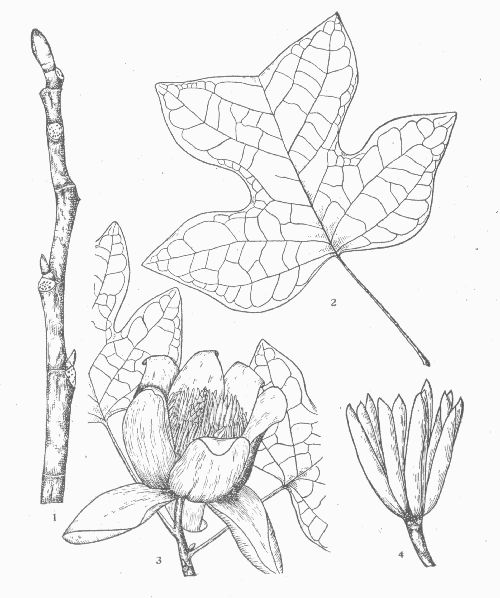
HABIT.—A large tree 70-100 feet high, with a columnar trunk 2-5 feet in diameter; forming a rather open, conical crown of slender branches.
LEAVES.—Alternate, simple, 5-6 inches long and broad; 4-lobed; entire; lustrous, dark green above, pale or glaucous beneath, turning clear yellow in autumn; petioles slender, angled, 5-6 inches long.
FLOWERS.—May-June, after the leaves; perfect; terminal; solitary on stout peduncles; tulip-shaped, greenish yellow, 1-1/2-2 inches long; sepals 3, greenish, early deciduous; petals 6, in 2 rows, greenish yellow with an orange spot at the base, early deciduous; stamens numerous, somewhat shorter than the petals; pistils numerous, clinging together about a central axis; ovary 1-celled.
FRUIT.—September-October; a narrow, light brown cone 2-1/2-3 inches long, composed of numerous carpels; carpels long, flat, with a 1-2-seeded nutlet at the base, separating from the slender spindle at maturity.
WINTER-BUDS.—Terminal bud 1/2-1 inch long, obtuse, flattish, dark red, covered with a glaucous bloom.
BARK.—Twigs smooth, lustrous, reddish, becoming brownish, and at length gray; ashy gray, thin and scaly on young trunks, becoming thick, brownish, and deeply furrowed with age.
WOOD.—Light, soft, brittle, weak, easily worked, light yellow or brown, with thin, cream-white sapwood.
DISTRIBUTION.—Lower Peninsula south of the Grand River. Formerly common, but becoming rare.
HABITAT.—Prefers deep, rich, rather moist soil, but adapts itself readily to any good, light soil.
NOTES.—Difficult to transplant, but rapid of growth when once established. Not disfigured by insect enemies. Good for ornamental planting.
Sassafras
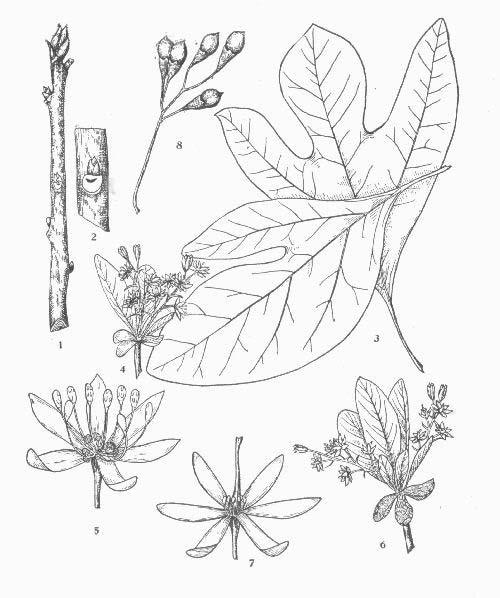
HABIT.—Usually a large shrub, but often a small tree 20-40 feet high, with a trunk diameter of 10-20 inches; stout, often contorted branches and a bushy spray form a flat, rather open crown.
LEAVES.—Alternate, simple, 3-6 inches long, 2-4 inches broad; oval to oblong or obovate; entire or 1-3-lobed with deep, broad sinuses and finger-like lobes; thin; dull dark green above, paler beneath; petioles slender, about 1 inch long.
FLOWERS.—May, with the leaves; dioecious; greenish yellow; on slender pedicels, in loose, drooping, few-flowered racemes 2 inches long; calyx deeply 6-lobed, yellow-green; corolla 0; stamens of staminate flower 9, in 3 rows, of pistillate flower 6, in 1 row; ovary 1-celled.
FRUIT.—September-October; an oblong-globose, lustrous, dark blue berry, 3/8 inch long, surrounded at the base by the scarlet calyx, borne on club-shaped, bright red pedicels.
WINTER-BUDS.—Terminal buds 1/3 inch long, ovoid, acute, greenish, soft-pubescent, flower-bearing; lateral buds much smaller, sterile or leaf-bearing. Aromatic.
BARK.—Twigs glabrous, lustrous, yellow-green, spicy-aromatic, becoming red-brown and shallowly fissured when 2-3 years old; thick, dark red-brown and deeply and irregularly fissured into firm, flat ridges on old trunks.
WOOD.—Soft, weak, brittle, coarse-grained, very durable in the soil, aromatic, dull orange-brown, with thin, light yellow sapwood.
DISTRIBUTION.—Southern portion of Lower Peninsula as far north as Grayling.
HABITAT.—Prefers well-drained, stony or sandy soil; woods; abandoned fields; peaty swamps.
NOTES.—Rapid of growth. Suckers freely. Difficult to transplant. Propagated easily from seed.
Sycamore. Button-wood. Buttonball-tree
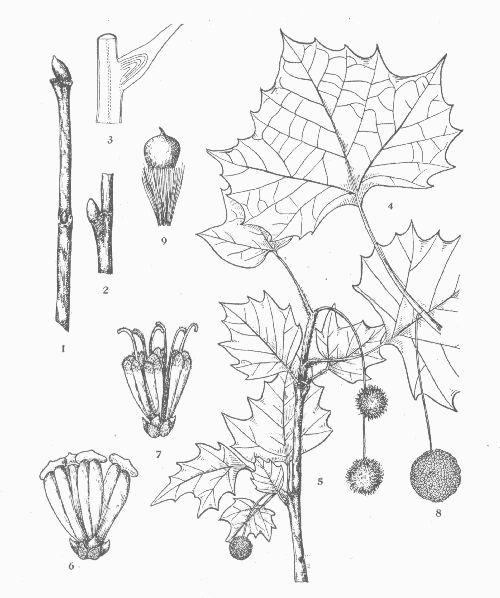
HABIT.—A large tree 70-100 feet high, with a trunk diameter of 3-8 feet; commonly dividing near the ground into several large secondary trunks, forming a broad, open, irregular crown of massive, spreading branches.
LEAVES.—Alternate, simple, 5-10 inches long and broad; broadly ovate in outline; more or less 3-5-lobed by broad, shallow sinuses, the lobes sinuate-toothed; thin and firm; bright green above, paler beneath, glabrous both sides; petioles stout, puberulous, 1-2 inches long.
FLOWERS.—May, with the leaves; monoecious; borne in dense heads; the staminate dark red, on short, axillary peduncles; the pistillate greenish, on long, slender, terminal peduncles; sepals 3-6, minute; petals 3-6, minute; stamens 3-6, usually 4; styles long, incurved, red.
FRUIT.—October, persistent on the limbs through the winter; brown heads about 1 inch in diameter, on slender, glabrous stems 3-6 inches long.
WINTER-BUDS.—Terminal bud absent; lateral buds 1/4-3/8 inch long, conical, blunt, lustrous, pale brown; forming in summer within the petiole of the leaf.
BARK.—Twigs pale green and tomentose, becoming smooth, dark green, finally grayish; thick, red-brown on the trunk and broken into oblong, plate-like scales, separating higher up into thin plates which peel off, exposing the greenish or yellowish inner bark.
WOOD.—Heavy, tough, hard, rather weak, coarse-grained, difficult to split, light red-brown, with thick, darker colored sapwood.
DISTRIBUTION.—Lower Peninsula as far north as Roscommon County.
HABITAT.—Prefers rich bottom-lands along the borders of rivers and lakes.
NOTES.—Rapid of growth. Bears transplanting well. Often planted as a shade tree. Fungous diseases disfigure it seriously.
| a. | Leaves simple; fruit a light green pome an inch or more in diameter; branches contorted, bearing many short, spur-like branchlets. | P. coronaria, p. 145. |
| aa. | Leaves compound; fruit berry-like, 1/4 inch in diameter, bright red; branches not contorted, not bearing many short, spur-like branchlets. | P. americana, p. 147. |
| a. | Bundle-scars 3 or in 3 compound, but distinct groups; buds 1/8-1/4 inch long; branches contorted, bearing many short, spur-like branchlets; fruit a pome an inch or more in diameter, light green. | P. coronaria, p. 145. |
| aa. | Bundle-scars 4-many in a single U-shaped line, not forming 3 distinct groups; buds about 1/2 inch long; branches not contorted, not bearing many short, spur-like branchlets; fruit berry-like, 1/4 inch in diameter, bright red. | P. americana, p. 147. |
Sweet Crab. American Crab
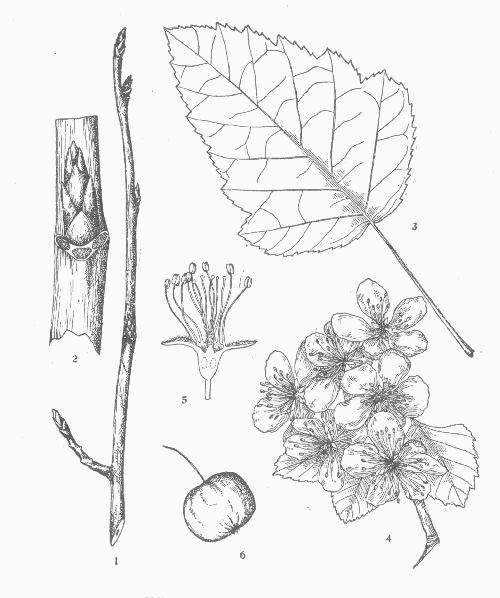
HABIT.—Often a bushy shrub, but frequently a small tree 15-25 feet high, with a trunk 8-12 inches in diameter; forming a broad, rounded crown of rigid, contorted branches bearing many short, spur-like branchlets.
LEAVES.—Alternate, simple, 3-4 inches long, almost as broad; ovate to nearly triangular; sharply and deeply serrate, sometimes lobed; membranaceous; bright green above, paler beneath, glabrous both sides; petioles long, slender, often with two dark glands near the middle.
FLOWERS.—May, after the leaves; perfect; 1-1/2-2 inches across; very fragrant; borne on slender pedicels in 5-6-flowered umbels; calyx urn-shaped, 5-lobed, tomentose; petals 5, rose colored to white; stamens 10-20; ovary hairy; styles 5.
FRUIT.—October; a depressed-globose pome, 1-1-1/2 inches in diameter, pale green, very fragrant, with a waxy surface.
WINTER-BUDS.—Terminal bud 1/8-1/4 inch long, obtuse, bright red; lateral buds smaller.
BARK.—Twigs at first hoary-tomentose, becoming glabrous, red-brown; thin, red-brown, breaking into longitudinal fissures on the trunk.
WOOD.—Heavy, rather soft, close-grained, weak, red-brown, with thick, yellow sapwood.
DISTRIBUTION.—Southern portion of the Lower Peninsula as far north as Roscommon County.
HABITAT.—Rich, moist, but well-drained soil in thickets and along streams.
NOTES.—An excellent ornamental tree or shrub for small gardens and shrubberies. The fruit is sometimes gathered for making preserves.
Mountain Ash
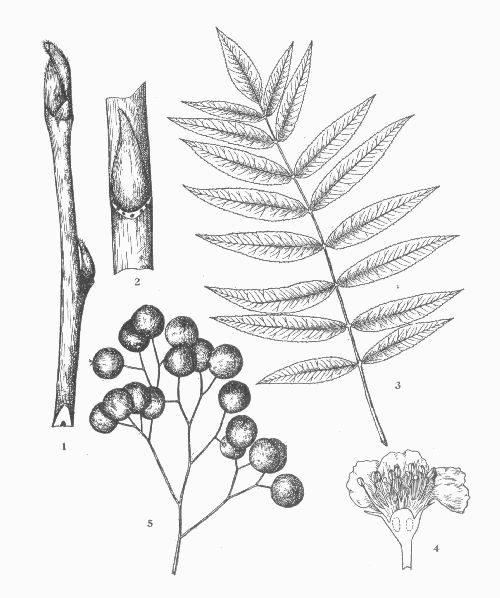
HABIT.—A small tree 15-20 feet high, with a trunk diameter of not over a foot; branches slender, spreading, forming a narrow, rounded crown.
LEAVES.—Alternate, compound, 6-9 inches long. Leaflets 9-17, 2-3 inches long and 1/2-3/4 inch broad; sessile or nearly so, except the terminal; lanceolate to oblong-lanceolate, taper-pointed; finely and sharply serrate above the entire base; membranaceous; glabrous, dark yellow-green above, paler beneath, turning clear yellow in autumn. Petioles slender, grooved, enlarged at the base.
FLOWERS.—May-June, after the leaves; perfect; 1/8 inch across; borne on short, stout pedicels in many-flowered, flat cymes 3-5 inches across; calyx urn-shaped, 5-lobed, puberulous; petals 5, white; stamens numerous; styles 2-3.
FRUIT.—October, but persistent on the tree throughout the winter; a berry-like pome, subglobose, 1/4 inch in diameter, bright red, with thin, acid flesh; eaten by birds in the absence of other food.
WINTER-BUDS.—Terminal bud about 1/2 inch long, ovoid, acute, with curved apex; lateral buds smaller, appressed; scales rounded on the back, purplish red, more or less pilose above, gummy.
BARK.—Twigs at first red-brown and hairy, becoming glabrous, dark brown; thin, light gray-brown on the trunk, smooth, or slightly roughened on old trees; inner bark fragrant.
WOOD.—Light, soft, close-grained, weak, pale brown, with thick, lighter colored sapwood.
DISTRIBUTION.—Ludington and northward, principally along the shore of L. Michigan, but common throughout the Upper Peninsula.
HABITAT.—Prefers rich, moist soil on river-banks and on the borders of cold swamps; rocky hillsides and mountains.
NOTES.—More often a shrub. Easily transplanted, but slow of growth. One of the most beautiful trees of our northern forests.
Serviceberry
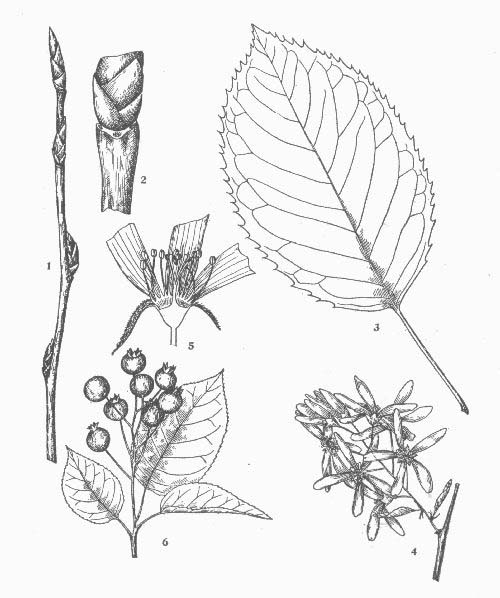
HABIT.—A small tree 25-40 feet in height, with a tall trunk 6-12 inches in diameter; forming a narrow, rounded crown of many small limbs and slender branchlets.
LEAVES.—Alternate, simple, 3-4 inches long and about one-half as broad; ovate to obovate; finely and sharply serrate; glabrous, dark green above, paler beneath; petioles slender, about 1 inch long.
FLOWERS.—April, when the leaves are about one-third grown; perfect; large, white, borne in drooping racemes 3-5 inches long; calyx 5-cleft, campanulate, villous on the inner surface; petals 5, strap-shaped, white, about 1 inch in length; stamens numerous; styles 5, united below.
FRUIT.—June-August; globular, berry-like pome, 1/3-1/2 inch long; turning from bright red to dark purple with slight bloom; sweet and edible when ripe.
WINTER-BUDS.—Yellow-brown, narrow-ovoid to conical, sharp-pointed, 1/4-1/2 inch long; bud-scales apiculate, slightly pubescent.
BARK.—Twigs smooth, light green, becoming red-brown; thin, pale red-brown on the trunk, smoothish or divided by shallow fissures into narrow, longitudinal, scaly ridges.
WOOD.—Heavy, very hard, strong, close-grained, dark red-brown, with thick, lighter colored sapwood.
DISTRIBUTION.—Common throughout the state.
HABITAT.—Prefers rich soil of dry, upland woods and hillsides.
NOTES.—Hardy throughout the state. Grows in all soils and situations except in wet lands.
Dotted Haw
Crataegus punctata Jacq.
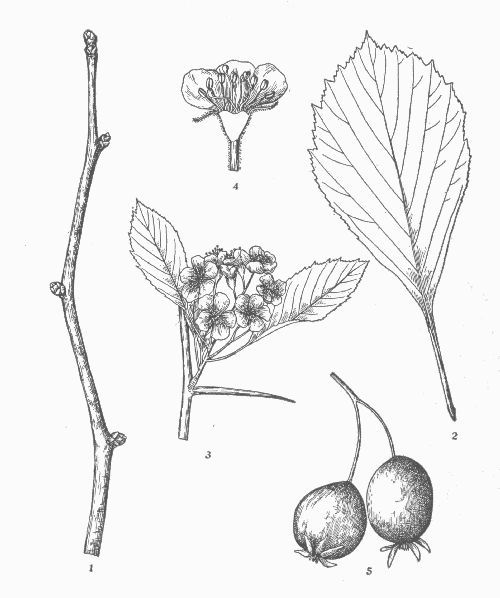
Owing to the complexity of the various forms in this group, the present state of uncertainty as to the value of certain characters, and the questionable validity of many of the assigned names, it is thought to be beyond the scope of this bulletin to give more than a general description of the group as a whole, recommending the more ambitious student to the various manuals and botanical journals and papers for more detailed information.
The Crataegi are generally low, wide-spreading trees or shrubs, with strong, tortuous branches and more or less zigzag branchlets usually armed with stiff, sharp thorns. The bark varies from dark red to gray and is shallowly fissured or scaly. The leaves are alternate, simple, generally serrate, often lobed, with short or long petioles. The flowers appear in May or June, with or after the leaves, in simple or compound corymbs, whitish or pinkish, perfect. The fruit is a red to yellow, sometimes blue or black pome, subglobose to pear-shaped, with usually dry and mealy flesh and 1-5 seeds. The winter-buds are small, nearly globose, lustrous brown. Crataegus produces wood which is heavy, hard, tough, close-grained, red-brown, with thick, pale sapwood. The Haws are trees of the pasture-lands, the roadside, the open woods and the stream-banks, and are more common in the southern than in the northern portions of the state. Some of the species are desirable as ornaments in parks and gardens on account of their beautiful and abundant flowers and showy fruits.
| a. | Leaves oblong-ovate to obovate, abruptly acuminate at the apex; marginal teeth not incurved. | ||
| b. | Margin of leaves sharp-serrate with spreading teeth; leaves not rugose, the veins not prominent; fruit 1/4-1/2 inch long, bright red, racemose, July-August; bark of trunk brown, smooth or only slightly fissured; usually a large shrub. | P. virginiana, p. 157. | |
| bb. | Margin of leaves crenate-serrate; leaves more or less rugose, the veins prominent; fruit about 1 inch long orange-red, clustered, August-September; bark of trunk gray-brown, early splitting off in large, thick plates; a small tree. | P. nigra, p. 161. | |
| aa. | Leaves oval to oblong-lanceolate, taper-pointed at the apex; marginal teeth incurved. | ||
| b. | Fruit light red, clustered, July-August; twigs usually less than 1/16 inch thick; pith of twigs brown; tree northern. | P. pennsylvanica, p. 139. | |
| bb. | Fruit black, racemose, August-September; twigs usually more than 1/16 inch thick; pith of twigs white; tree southern. | P. serotina, p. 155. | |
| a. | Terminal bud present; bark of young trunks rather smooth. | |||
| b. | Buds clustered at the tips of all shoots; twigs usually less than 1/16 inch thick; pith of twigs brown. | P. pennsylvanica, p. 159. | ||
| bb. | Buds not clustered, or clustered only on short, spur-like branchlets; twigs usually more than 1/16 inch thick; pith of twigs white. | |||
| c. | Buds usually 1/4 inch or less in length; bud-scales uniform in color, apiculate at the apex; bark on old trunks blackish, rough-scaly; small to large tree. | P. serotina, p. 155. | ||
| cc. | Buds usually 1/4-1/2 inch long; bud-scales grayish on the margins, rounded at the apex; bark on old trunks brown, smooth or only slightly fissured; usually a large shrub. | P. virginiana, p. 157. | ||
| aa. | Terminal bud absent; bark of young trunks early splitting off in large, thick plates. | P. nigra, p. 161. | ||
Black Cherry
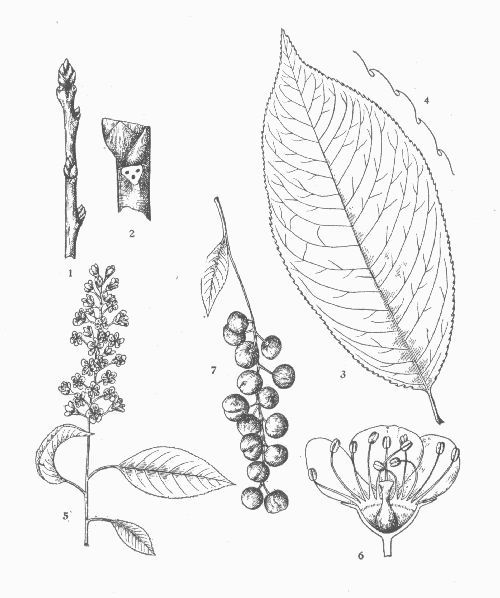
HABIT.—A medium-sized tree 40-50 feet high and 8-36 inches in trunk diameter; branches few, large, tortuous, forming a rather spreading, oblong or rounded crown.
LEAVES.—Alternate, simple, 2-5 inches long, about one-half as broad; oval or oblong to oblong-lanceolate; finely serrate, with teeth incurved; subcoriaceous; dark green and very lustrous above, paler beneath, glabrous both sides; petioles short, slender, usually bearing 2 red glands near the blade.
FLOWERS.—May-June, when the leaves are half grown; perfect; 1/4 inch across; borne on slender pedicels in many-flowered, loose racemes 4-5 inches long; calyx cup-shaped, 5-lobed; petals 5, white; stamens 15-20; stigma thick, club-shaped.
FRUIT.—August-September; a globular drupe, 1/3-1/2 inch in diameter, nearly black, with dark purple, juicy flesh; slightly bitter, edible.
WINTER-BUDS.—Terminal bud about 1/4 inch long, ovoid, blunt to acute; scales keeled on the back, apiculate, light brown.
BARK.—Twigs and branches red to red-brown; young trunks dark red-brown, smooth; blackish on old trunks and rough, broken into thick, irregular plates; bitter, aromatic.
WOOD.—Light, rather hard, strong, close- and straight-grained, light brown or red, with thin, yellow sapwood.
DISTRIBUTION.—Frequent in the southern half of the Lower Peninsula, rare in the northern half and the Upper Peninsula.
HABITAT.—Prefers a rich, moist soil, but grows well on dry, gravelly or sandy soils.
NOTES.—Grows very rapidly in youth.
Choke Cherry
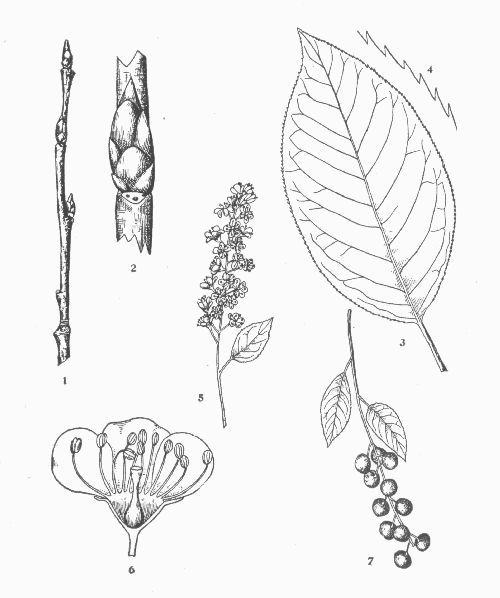
HABIT.—Usually a large shrub, but sometimes a small tree 15-25 feet high, with a crooked, often leaning trunk 5-6 inches in diameter; forming a spreading, somewhat rounded crown.
LEAVES.—Alternate, simple, 2-4 inches long, one-half as broad; obovate to oblong-obovate or oval, abruptly acuminate at the apex; finely and sharply serrate; dull dark green above, paler beneath, glabrous both sides; petioles short, slender, glandular at the apex.
FLOWERS.—May, when the leaves are half grown; perfect; about 1/2 inch across; borne on short, slender pedicels in many-flowered racemes 3-6 inches long; calyx cup-shaped, 5-lobed; petals 5, white; stamens 15-20; stigma broad, on a short style.
FRUIT.—July-August; a globular drupe, 1/4-1/2 inch in diameter, usually bright red, often yellow to almost black, with dark red flesh; astringent, but edible.
WINTER-BUDS.—Terminal bud 1/4-1/2 inch long, conical, acute; scales rounded at the apex, light brown, smooth.
BARK.—Twigs at first light brown or greenish, becoming red-brown, finally dark brown; thin, dark brown on the trunk, slightly fissured.
WOOD.—Heavy, hard, close-grained, weak, light brown, with thick, lighter colored sapwood.
DISTRIBUTION.—Common throughout the entire state.
HABITAT.—Prefers a deep, rich, moist loam, but is common on less favorable sites.
NOTES.—The most widely distributed tree of North America, extending from the arctic circle to Mexico, from the Rocky Mountains to the Atlantic Ocean.
Wild Red Cherry. Pin Cherry
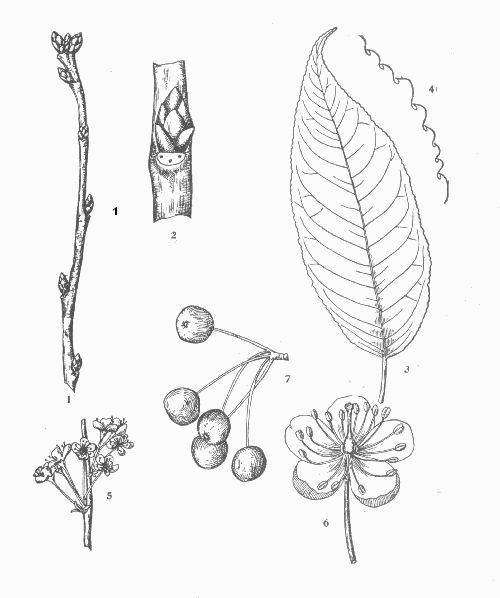
HABIT.—A slender tree, seldom over 30 feet high, with a trunk diameter of 8-10 inches; crown rather open, narrow, rounded, with slender, regular branches.
LEAVES.—Alternate, simple, 3-5 inches long, 3/4-1-1/4 inches broad; oblong-lanceolate; finely and sharply serrate; bright green and shining above, paler beneath; petioles slender, 1/2-1 inch long, glandular near the blade.
FLOWERS.—May-June, with the leaves; perfect; about 1/2 inch across, borne on slender pedicels in 4-5-flowered umbels, generally clustered, 2-3 together; calyx 5-cleft, campanulate; petals 5, white, 1/4 inch long; stamens 15-20.
FRUIT.—July-August; a globular drupe, 1/4 inch in diameter, light red, with thick skin and sour flesh.
WINTER-BUDS.—Terminal bud 1/8 inch long, broadly ovoid, rather blunt, brownish, smooth.
BARK.—Twigs at first lustrous, red, marked by orange colored lenticels, becoming brownish; red-brown and thin on the trunk, peeling off horizontally into broad, papery plates; bitter, aromatic.
WOOD.—Light, soft, close-grained, light brown, with thin, yellow sapwood.
DISTRIBUTION.—Throughout the northern portion of the state, extending southward to Ionia County.
HABITAT.—Abundant on sand-lands; roadsides; burned-over lands; clearings; hillsides.
NOTES.—Rapid of growth. Short-lived.
Canada Plum. Red Plum
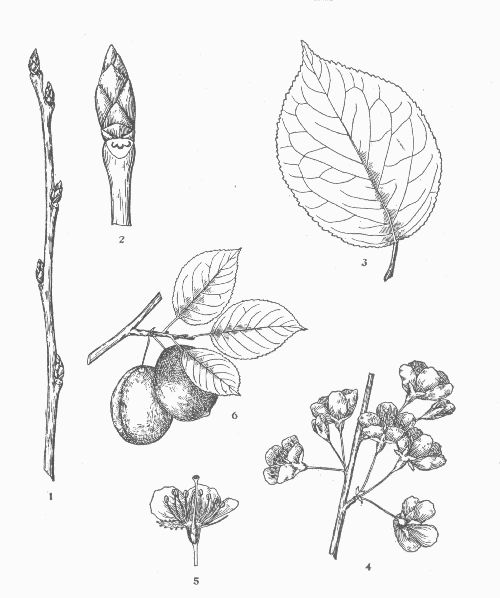
HABIT.—A small tree 20-25 feet high and 5-8 inches in trunk diameter; usually divides 5-6 feet from the ground into a number of stout, upright branches, forming a narrow, rigid crown.
LEAVES.—Alternate, simple, 3-5 inches long and one-half as broad; oblong-ovate to obovate, abruptly acuminate at the apex; doubly crenate-serrate; thick and firm; glabrous, light green above, paler beneath; petioles short, stout, bearing 2 large red glands near the blade.
FLOWERS.—May, before the leaves; perfect; slightly fragrant; about 1 inch across; borne on slender, glabrous, red pedicels in 2-3-flowered umbels; calyx 5-lobed, dark red; petals 5, white; stamens 15-20, with purple anthers; ovary 1-celled; style 1; stigma 1.
FRUIT.—August-September; a fleshy drupe, about 1 inch long, oblong-ovoid, with a tough, thick, orange-red skin nearly free from bloom, and yellow flesh adherent to the flat stone. Eaten raw or cooked.
WINTER-BUDS.—Terminal bud absent; lateral buds 1/8-1/4 inch long, ovate, acute, chestnut-brown.
BARK.—Twigs green, marked by numerous pale excrescences, later dark brown; thin, gray-brown and smooth on young trunks, but soon splitting off in large, thick plates, exposing the darker inner bark.
WOOD.—Heavy, hard, strong, close-grained, light red-brown, with thin, lighter colored sapwood.
DISTRIBUTION.—Upper Peninsula and the Lower Peninsula north of Lansing.
HABITAT.—Prefers rich, alluvial soil along streams.
NOTES.—Suckers freely, forming low, broad thickets.
Coffeetree. Kentucky Coffeetree
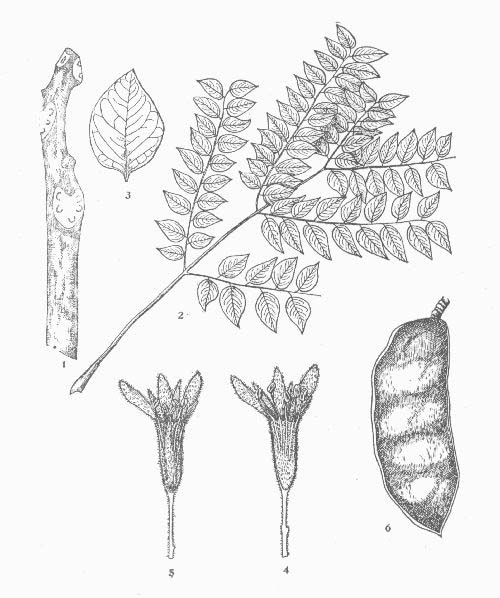
HABIT.—A slender tree 50-75 feet high, with a trunk diameter of 2-3 feet; divides near the ground into several stems which spread slightly to form a narrow, pyramidal crown; branchlets stout, clumsy, blunt, with conspicuous leaf-scars.
LEAVES.—Alternate, bipinnately compound, 1-3 feet long. Leaflets 40 or more, 2-2-1/2 inches long and one-half as broad; short-stalked; ovate, acute; entire; thin and firm; dark green above, pale yellow-green and glabrous beneath. Petioles stout, terete, glabrous. Appear late in spring.
FLOWERS.—June, after the leaves; dioecious; greenish white; the staminate short-stalked, in racemose corymbs 3-4 inches long; the pistillate long-stalked, in racemes 10-12 inches long; calyx tubular, hairy; petals 5, keeled, nearly white; stamens 10; ovary hairy.
FRUIT.—Ripens in autumn, but remains closed until late in winter; short-stalked, red-brown legumes 6-10 inches long, 1-1/2-2 inches wide, containing 6-9 large, flat seeds.
WINTER-BUDS.—Terminal bud absent; lateral buds minute, depressed, 2 in the axil of each leaf, bronze-brown, silky-pubescent.
BARK.—Twigs coated with short, dense, reddish pubescence, becoming light brown; thick, deeply fissured and scaly on the trunk, dark gray.
WOOD.—Heavy, somewhat soft, strong, coarse-grained, very durable in contact with the soil, light red-brown, with thin, lighter colored sapwood.
DISTRIBUTION.—Southern Michigan as far north as the Grand River. Infrequent.
HABITAT.—Prefers bottom-lands and rich soil.
NOTES.—The seeds in early days were used as a substitute for coffee.
Honey Locust. Three-thorned Acacia
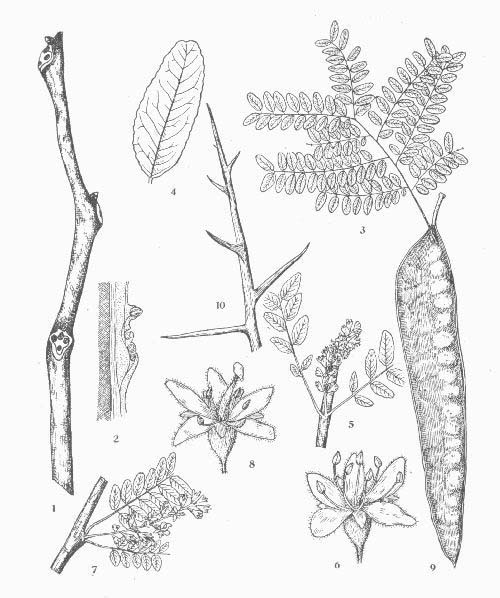
HABIT.—A tree usually 50-75 feet high, with a trunk diameter of 2-3 feet; dividing near the ground into several large, upright branches which divide again into long, slender, horizontal branchlets; both trunk and large branches armed with stout, rigid, simple or branched spines.
LEAVES.—Alternate, pinnately or bipinnately compound, 7-12 inches long. Leaflets 18 or more, 3/4-1-1/2 inches long, one-third as broad; lanceolate-oblong; remotely crenulate-serrate; thin; lustrous, dark green above, dull yellow-green beneath. Petioles and rachises pubescent.
FLOWERS.—May-June, when the leaves are nearly full grown; polygamo-dioecious; the staminate in short, many-flowered, pubescent racemes; the pistillate in slender, few-flowered racemes; on shoots of the preceding season; calyx campanulate, hairy 3-5-lobed; petals 3-5, greenish; stamens 3-10; ovary 1-celled, woolly.
FRUIT.—Autumn, falling in early winter; flat, pendent, twisted, brown legumes, 12-18 inches long, short-stalked in short racemes; seeds 12-14, oval, flattened.
WINTER-BUDS.—Terminal bud absent; lateral buds minute, 3 or more superposed, glabrous, brownish.
BARK.—Twigs lustrous, red-brown, becoming gray-brown; thick on the trunk, iron-gray to blackish and deeply fissured into long, narrow ridges roughened by small scales.
WOOD.—Hard, strong, coarse-grained, durable in contact with the ground, red-brown, with thin, pale sapwood.
DISTRIBUTION.—Indigenous to the extreme southern portion of the state, but is planted as far north as Bay City.
HABITAT.—Prefers deep, rich loam, but grows on a variety of soils.
NOTES.—Grows rapidly and is long-lived and free from disease. Easily transplanted. The leaves appear late in spring and fall early in autumn. The stiff spines and long pods which litter the ground make the tree unsuitable for street or ornamental use.
Redbud. Judas-tree
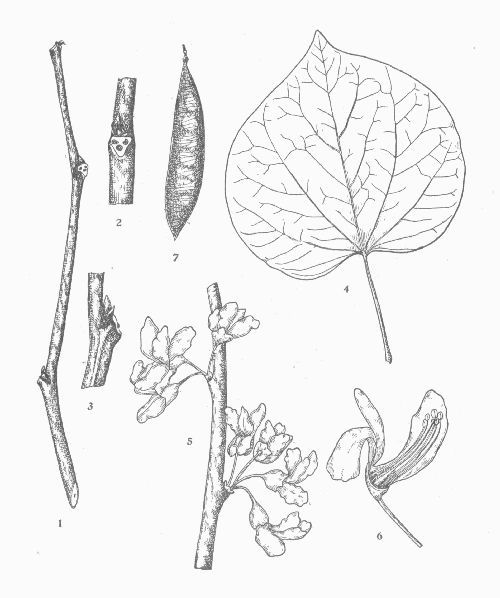
HABIT.—A small tree 20-30 feet high, with a trunk diameter of 10-15 inches; divided near the ground into stout, straggling branches to form a broad, flat crown.
LEAVES.—Alternate, simple, 3-5 inches long and broad; heart-shaped or rounded; entire; thick; glabrous, dark green above, paler beneath, turning bright yellow in autumn; petioles slender, terete, enlarged at the base.
FLOWERS.—April-May, before or with the leaves; perfect; 1/2 inch long; borne on short, jointed pedicels in fascicles of 4-8; calyx campanulate, 5-toothed, dark red; petals 5, rose color; stamens 10, in 2 rows.
FRUIT.—June-July, remaining on the tree until early winter; a short-stalked legume 2-1/2-3 inches long, pointed at both ends, rose color; seeds 10-12, brownish, 1/4 inch long.
WINTER-BUDS.—Terminal bud absent; lateral buds 1/8 inch long, obtuse, somewhat flattened and appressed, brownish.
BARK.—Twigs lustrous, brown, becoming dark or grayish brown; red-brown, deeply fissured, with a scaly surface on old trunks.
WOOD.—Heavy, hard, coarse-grained, weak, dark red-brown, with thin, lighter colored sapwood.
DISTRIBUTION.—Valleys of the Grand and Raisin Rivers and southward.
HABITAT.—Prefers the borders of streams and rich bottom-lands, often in the shade of other trees.
NOTES.—A rapid grower. Hardy within its range. Can be transplanted with success only when very young. Plants begin to produce flowers freely when 4-5 years old. Much used in landscape gardening.
Locust. Black Locust
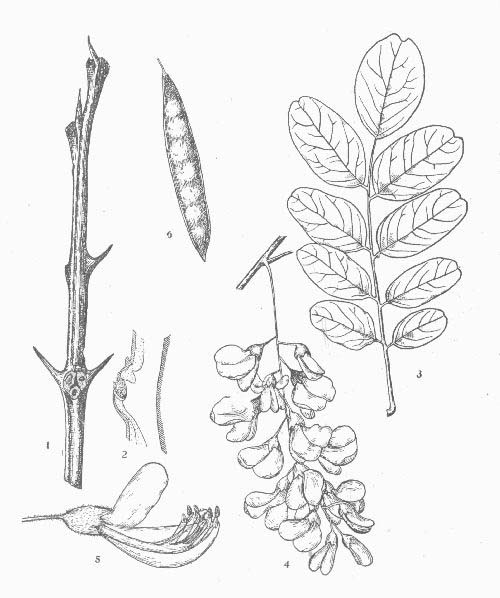
HABIT.—A tree 50-75 feet high, with a trunk diameter of 2-3 feet; forming a narrow, oblong crown of irregular, more or less contorted branches.
LEAVES.—Alternate, compound, 8-14 inches long. Leaflets 7-21, short-petiolate, 1-2 inches long, about one-half as broad; ovate to oblong-oval; entire; very thin; dull dark green above, paler beneath, glabrous both sides. Petioles slender, pubescent.
FLOWERS.—May-June, after the leaves; perfect; showy and abundant; very fragrant; borne on slender pedicels in loose, drooping racemes 4-5 inches long; about 1 inch long; calyx short, bell-shaped, 5-lobed, hairy; corolla papilionaceous, white, 5-petaled; stamens 10.
FRUIT.—Late autumn, but persistent on the tree through the winter; a smooth, dark brown, flat pod 3-4 inches long, containing 4-8 small, flattish, brown seeds.
WINTER-BUDS.—Terminal bud absent; lateral buds minute, 3-4 superposed, partially sunken within the leaf-scar, rusty-hairy.
BARK.—Twigs smooth, green, more or less rough-dotted at first, becoming red-brown and armed with prickles; dark red-brown and thick on old trunks, deeply furrowed into firm, sinuous ridges.
WOOD.—Heavy, very strong and hard, close-grained, very durable in contact with the soil, brown, with very thin, pale yellow sapwood.
NOTES.—Native to the Appalachian Mountains, but much planted in Michigan for ornamental and economic uses. Very rapid of growth in youth. Short-lived. Seriously attacked by borers. Spreads by underground shoots.
Ailanthus. Tree of Heaven
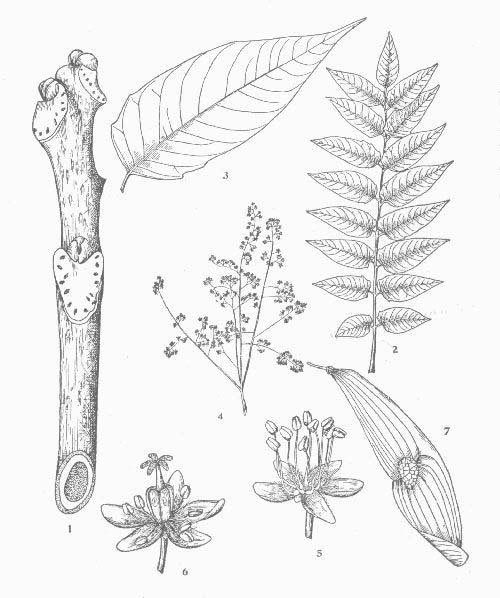
HABIT.—A handsome, rapid-growing, short-lived tree, attaining a height of 50-70 feet and a trunk diameter of 2-4 feet, with a spreading, rather loose and open crown and a coarse, blunt spray.
LEAVES.—Alternate, pinnately compound, 1-3 feet long. Leaflets 11-41 in number, 2-6 inches long and about one-third as broad; ovate-lanceolate; entire with the exception of two or more coarse, glandular teeth at the base; glabrous, dark green above, paler beneath, turning a clear yellow in autumn or falling without change; ill-scented. Petioles smooth, terete, swollen at the base.
FLOWERS.—June, when the leaves are full grown; polygamo-dioecious; small, yellow-green, borne in upright panicles 6-12 inches or more in length; calyx 5-lobed; petals 5, greenish, hairy; stamens 10. Staminate flowers ill-scented, pistillate almost free from odor.
FRUIT.—October; 1-celled, 1-seeded samaras, spirally twisted, reddish or yellow-green, borne in crowded clusters.
WINTER-BUDS.—Terminal bud absent; lateral buds about 1/8 inch long, subglobose, brownish, downy.
BARK.—Twigs yellowish to red-brown, velvety-downy; thin, grayish and shallowly fissured on old trunks.
WOOD.—Soft, weak, of coarse and open grain, pale yellow, satiny, with thick, lighter colored sapwood.
NOTES.—A native of China, but naturalized in the United States and planted frequently in southern Michigan as a foliage tree. Only the pistillate trees should be planted, as these are almost free from the objectionable odor of the staminate trees. The smoke and dust of our large cities have little effect on the foliage, and the trees are perfectly hardy in the southern part of the state.
| a. | Leaves simple; twigs usually without whitish bloom. | |||||
| b. | Leaf-sinuses acute at the base. | |||||
| c. | Leaf-lobes long and narrow, the sides of the terminal lobe diverging; leaves silvery white beneath; twigs rank-smelling when broken. | A. saccharinum, p. 185. | ||||
| cc. | Leaf-lobes short and broad, the sides of the terminal lobe converging; leaves not conspicuously white beneath; twigs not rank-smelling when broken. | |||||
| d. | Leaves 2-4 inches broad, thin, not pentagonally 5-lobed; wings of fruit 3/4-1 inch long. | |||||
| e. | Leaves distinctly white-downy beneath; twigs appressed-hairy, at least near the tip; fruit hanging in pendulous racemes, persistent on the tree until autumn; seed portion with pit-like depression on one side; usually a shrub or bushy tree. | A. spicatum, p. 179. | ||||
| ee. | Leaves not distinctly white-downy beneath; twigs glabrous; fruit hanging in clusters, falling in early summer; seed portion without pit-like depression on one side; medium-sized tree. | A. rubrum, p. 187. | ||||
| dd. | Leaves 4-7 inches broad, thick, pentagonally 5-lobed; wings of fruit 1-1/2 inches long. | A. pseudo-platanus, p. 191. | ||||
| bb.[Pg 173] | Leaf-sinuses rounded at the base. | |||||
| c. | Lower sides of leaves and petioles distinctly downy, the lobes undulate or entire; leaves very thick, drooping at the sides. | A. saccharum nigrum, p. 183. | ||||
| cc. | Lower sides of leaves and petioles essentially glabrous, the lobes serrate; leaves not thick, not drooping at the sides. | |||||
| d. | Leaves coarsely and sparsely toothed or notched; bark not longitudinally white-striped; large trees. | |||||
| e. | Twigs coarse; petioles exuding a milky juice when cut; wings of fruit diverging by nearly 180°; bark of the trunk closely fissured, not scaly. | A. platanoides, p. 189. | ||||
| ee. | Twigs slender; petioles not exuding a milky juice when cut; wings of fruit diverging only slightly; bark of the trunk deeply furrowed, often cleaving in long, thick plates. | A. saccharum, p. 181. | ||||
| dd. | Leaves finely and abundantly toothed; bark longitudinally white-striped; a bushy tree or shrub. | |||||
| aa. | Leaves compound; twigs usually with whitish bloom. | A. negundo, p. 193. | ||||
| a. | Terminal buds usually under 1/4 inch in length. | |||||
| b. | Buds white-woolly; twigs usually with a whitish bloom; opposite leaf-scars meeting; fruit often persistent on the tree until spring. | A. negundo, p. 193. | ||||
| bb. | Buds not white-woolly; twigs without whitish bloom; opposite leaf-scars not meeting; fruit not persistent on the tree in winter. | |||||
| c. | Buds reddish or greenish; twigs bright red. | |||||
| d. | Twigs strictly glabrous; buds glabrous; spherical flower buds clustered on the sides of the shoot; pith pink; large trees. | |||||
| e. | Twigs rank-smelling when broken; tip of outer bud-scales often apiculate; tips of branches curving upwards; bark separating into long, thin flakes loose at the ends. | A. saccharinum, p. 185. | ||||
| ee. | Twigs not rank-smelling when broken; tip of outer bud-scales rounded; tips of branches not conspicuously curving upwards; bark rough-ridged, but seldom forming loose flakes. | A. rubrum, p. 187. | ||||
| dd. | Twigs appressed-hairy, at least near the tip; buds somewhat tomentose; spherical flower buds absent; pith brown; shrub or bushy tree. | A. spicatum, p. 179. | ||||
| cc.[Pg 175] | Buds brownish; twigs brownish or grayish. | |||||
| d. | Buds glabrous, or somewhat pubescent at the apex only; bark dark gray on the trunk. | A. saccharum, p. 181. | ||||
| dd. | Buds hoary-pubescent; bark sometimes almost black on the trunk. | A. saccharum nigrum, p. 183. | ||||
| aa. | Terminal buds usually 1/4-1/2 inch in length. | |||||
| b. | Buds reddish; opposite leaf-scars meeting. | |||||
| c. | Buds conspicuously stalked; bud-scales visible, 1 pair; bark longitudinally white-striped; small tree or large shrub. | A. pennsylvanicum, p. 177. | ||||
| cc. | Buds not conspicuously stalked; bud-scales visible, 2-3 pairs; bark not white-striped; large tree. | A. platanoides, p. 189. | ||||
| bb. | Buds bright green; opposite leaf-scars not meeting. | A. pseudo-platanus, p. 191. | ||||
Striped Maple. Moosewood. Whistlewood
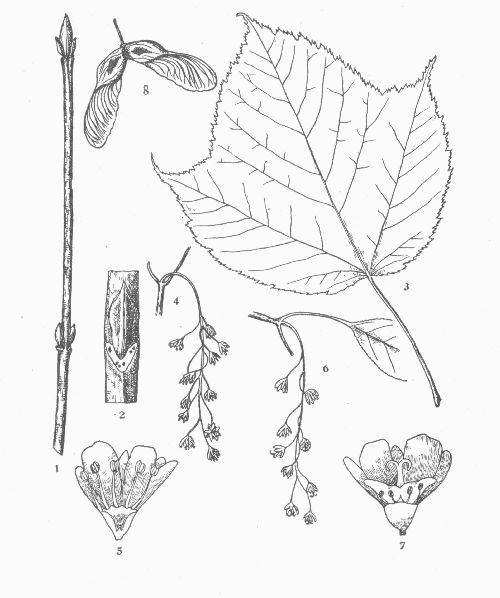
HABIT.—A small tree at best, more often a large shrub, seldom attaining a height of more than 30 feet, with a short trunk 5-8 inches through. The striped, upright branches form a rather compact crown.
LEAVES.—Opposite, simple, 5-6 inches long and nearly as broad; 3-lobed above the middle with short, tapering lobes; palmately 3-nerved; sharply doubly serrate; rounded or heart-shaped at the base; glabrous, yellow-green above, paler beneath, turning pale yellow in autumn; petioles stout, grooved.
FLOWERS.—May-June, when the leaves are nearly full grown; usually monoecious; large, bright yellow, bell-shaped, in slender, drooping racemes 4-6 inches long; calyx 5-parted; petals 5; stamens 7-8; ovary downy.
FRUIT.—Ripens in autumn; glabrous, paired samaras in long, drooping, racemose clusters, the wings 3/4 inch long, widely divergent, and marked on one side of each nutlet by a small cavity.
WINTER-BUDS.—Bright red; terminal bud nearly 1/2 inch long, short-stalked, with bud-scales keeled; lateral buds smaller, appressed.
BARK.—Twigs light green, mottled with black, smooth; trunk and branches red-brown, marked longitudinally by broad, pale stripes.
WOOD.—Light, soft, close-grained, pinkish brown, with thick, lighter colored sapwood.
DISTRIBUTION.—Abundant in the Upper Peninsula, extending southward as far as Roscommon County in the Lower Peninsula.
HABITAT.—Cool, rocky or sandy woods, usually in the shade of other trees.
NOTES.—In the Northwoods the green shoots are browsed by deer and moose. Valued mostly for its aesthetic qualities. Of little or no economic value.
Mountain Maple
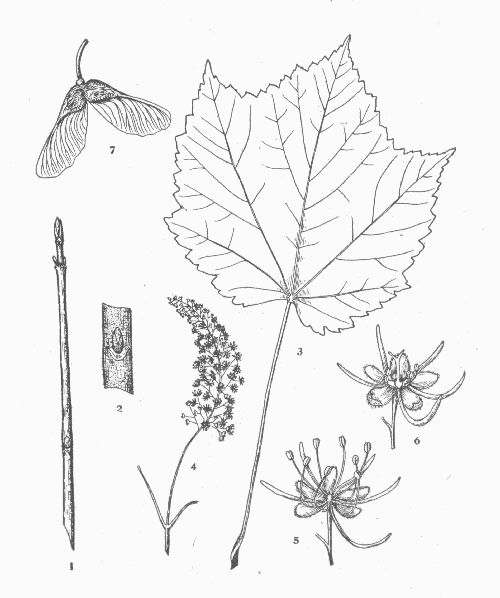
HABIT.—A bushy tree sometimes 25-30 feet high, with a short trunk 6-8 inches in diameter; small, upright branches form a small, rounded crown. More often a straggling shrub.
LEAVES.—Opposite, simple, 4-5 inches long and two-thirds as broad; 3-lobed above the middle, the lobes coarsely crenate-serrate with pointed teeth, the sinuses usually wide-angled and acute at the base; thin; glabrous, dark green above, covered with a whitish down beneath, turning scarlet and orange in autumn; veining prominent; petioles long, slender, with enlarged base.
FLOWERS.—June, after the leaves are full grown; polygamo-monoecious; small, yellow-green; in erect, slightly compound, many-flowered, long-stemmed, terminal racemes; calyx downy, 5-lobed; petals 5; stamens 7-8; ovary tomentose.
FRUIT.—July; bright red, turning brown in late autumn; small, glabrous, paired samaras, in pendulous, racemose clusters.
WINTER-BUDS.—Small, flattish, acute, bright red, more or less tomentose; the terminal 1/8 inch long, containing the flowers.
BARK.—Twigs reddish, slightly hairy; very thin, red-brown, smooth or slightly furrowed on the trunk.
WOOD.—Light, soft, close-grained, light brown, with thick, lighter colored sapwood.
DISTRIBUTION.—Common in the Upper Peninsula; extends as far south as Saginaw Bay.
HABITAT.—Damp forests; rocky woods; along streams; always in the shade of other trees.
NOTES.—Forms much of the undergrowth of our northern forests. Little used, except for fire-wood.
Sugar Maple. Hard Maple. Rock Maple
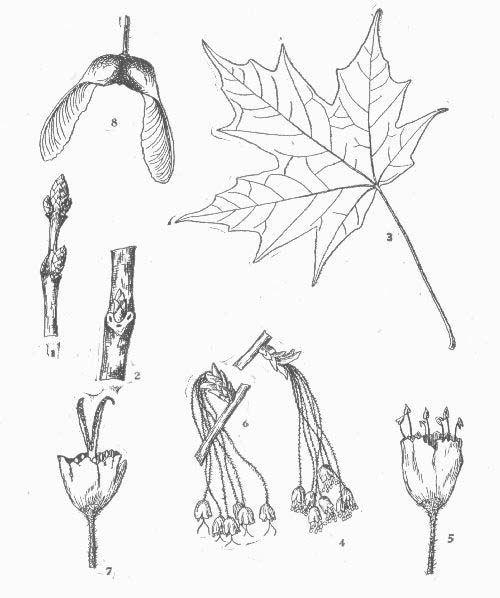
HABIT.—A stately tree 60-100 feet in height, with a trunk diameter of 3-4 feet; in the open forming stout, upright branches near the ground, in forests making remarkably clean trunks to a good height; the crown is a broad, round-topped dome.
LEAVES.—Opposite, simple, 3-5 inches long and broad; usually 5-lobed (sometimes 3-lobed), the lobes sparingly wavy-toothed, the sinuses broad and rounded at the base; thin and firm; opaque, dark green above, lighter and glabrous beneath, turning yellow and red in autumn; petioles long, slender.
FLOWERS.—May, with the leaves; polygamo-monoecious or dioecious; on thread-like, hairy pedicels in nearly sessile corymbs; greenish yellow; calyx campanulate, 5-lobed; corolla 0; stamens 7-8; ovary hairy.
FRUIT.—September-October, germinating the following spring; paired samaras, glabrous, with wings about 1 inch long, diverging slightly.
WINTER-BUDS.—Small, acute, red-brown, glabrous or somewhat pubescent toward the apex, the terminal 1/4 inch long, the lateral smaller, appressed.
BARK.—Twigs smooth, pale brown, becoming gray and smooth on the branches; old trunks dark gray, deeply furrowed, often cleaving up at one edge in long, thick plates.
WOOD.—Heavy, hard, strong, close-grained, tough, durable, light brown, with thin, lighter colored sapwood.
DISTRIBUTION.—Found throughout the entire state.
HABITAT.—Prefers moist, rich soil in valleys and uplands and moist, rocky slopes.
NOTES.—The most important hardwood in Michigan. The tree which produces the bulk of the maple sugar of the market.
Black Maple. Black Sugar Maple
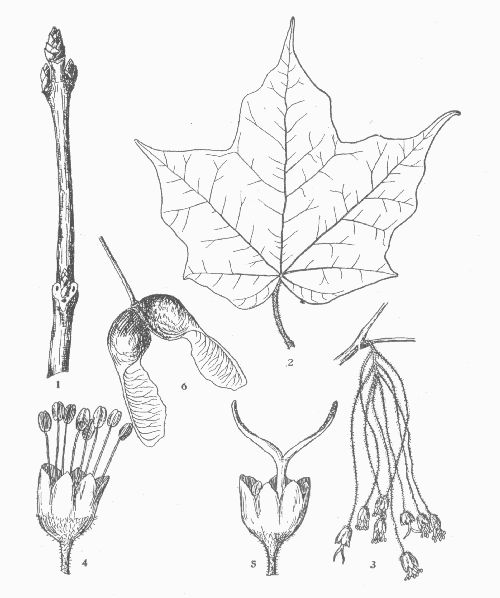
HABIT.—A stately tree, sometimes reaching a height of 80 feet, with a trunk diameter of 2-3 feet; branches stout, forming a broad, rounded, symmetrical crown.
LEAVES.—Opposite, simple, concave, 5-7 inches across, the breadth usually exceeding the length; usually 5-lobed at maturity, the two lower lobes being small, often reduced to a mere curve in the outline, the pointed lobes undulate or entire and narrowed from the broad, shallow sinuses; thick and firm; glabrous above, downy beneath; petioles stout, usually pendent, tomentose. The sides of the larger leaves often droop giving to the tree an air of depression.
FLOWERS.—May, with the leaves; monoecious; in nearly sessile, umbel-like corymbs; about 1/4 inch long, yellow, on slender, hairy pedicels 2-3 inches long; calyx campanulate, pilose, 5-lobed; corolla 0; stamens 7-8; ovary hairy.
FRUIT.—Ripens in autumn; glabrous, paired samaras, clustered on drooping pedicels; wings set wide apart, but only slightly diverging.
WINTER-BUDS.—Small, ovoid, acute, with dark red-brown, acute scales, hoary-pubescent on the outer surface.
BARK.—Twigs smooth, pale gray; becoming thick, deeply furrowed and sometimes almost black on the trunk.
WOOD.—Hard, heavy, strong, close-grained, creamy white, with thin, lighter colored sapwood.
DISTRIBUTION.—Lower Peninsula, south-eastern portion.
HABITAT.—Prefers low, moist, rich soil of river-bottoms, but does well on gravelly soils and uplands.
NOTES.—Very variable. A very good shade tree because of its dense foliage. It is claimed by some that the finest grades of maple sugar are made from the sap of this tree.
Silver Maple. Soft Maple
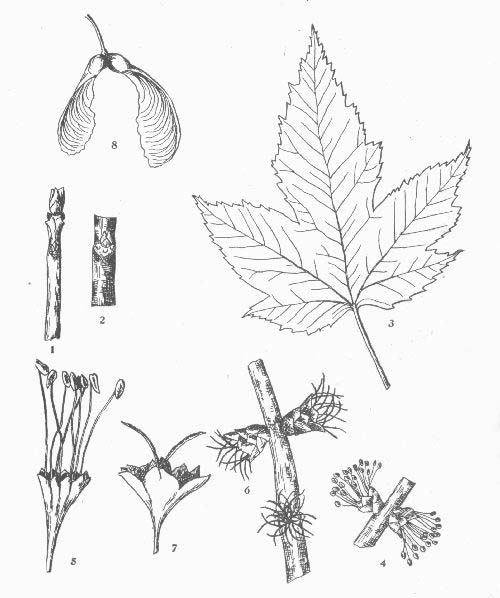
HABIT.—A beautiful tree, growing to a height of 60-80 feet, with a trunk diameter of 2-4 feet, usually separating near the ground into 3-4 upright stems which are destitute of branches for a considerable distance. Usually the long, slender branches bend downwards, but with their tips ascending in a graceful curve. Crown broad, especially in its upper portion.
LEAVES.—Opposite, simple, 3-6 inches long and nearly as broad; usually 5-lobed by narrow, acute sinuses which extend nearly to the midrib, the lobes often sublobed, sharply toothed; light green above, silvery white beneath, turning pale yellow in autumn; petioles long, slender, drooping.
FLOWERS.—March-April, before the leaves; polygamo-monoecious or dioecious; small, yellow-green, in crowded, sessile umbels; calyx 5-lobed (sometimes each lobe again divided); corolla 0; stamens 3-7; ovary hairy.
FRUIT.—May, germinating as soon as it reaches the ground; paired samaras, large, glabrous, curving inwards, one samara often aborted.
WINTER-BUDS.—Dark red, blunt; the terminal about 1/4 inch long, with bud-scales often apiculate at the apex; flower-buds clustered on side spurs.
BARK.—Twigs smooth, red-gray, lustrous; young trunks gray, smooth; old trunks dark gray, more or less furrowed, separating into thin, loose scales.
WOOD.—Hard, strong, close-grained, rather brittle, perishable, pale brown, with thick, lighter colored sapwood.
DISTRIBUTION.—Lower Peninsula south of Saginaw Bay.
HABITAT.—Prefers low, rich bottom-lands, subject to occasional inundation, but not in swamps.
NOTES.—A rapid grower, adapting itself to a variety of soils. Does not do well on dry, elevated ground. The first tree to blossom in early spring.
Red Maple. Soft Maple
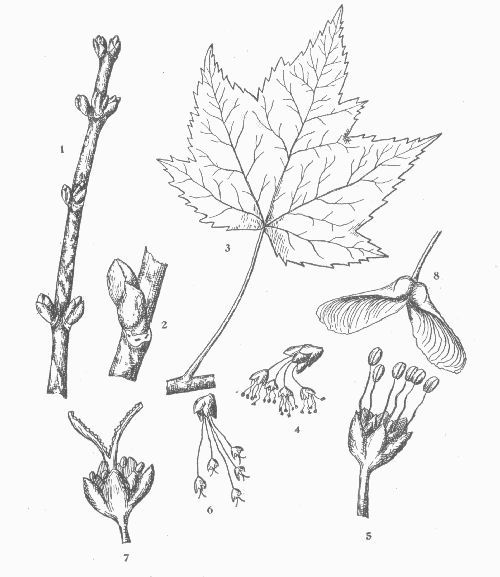
HABIT.—A medium-sized tree 40-50 feet high, occasionally in swamps 60-75 feet; trunk 1-3 feet in diameter; upright branches, which form a low, rather narrow, rounded crown.
LEAVES.—Opposite, simple, 3-4 inches long and nearly as broad; 3-5-lobed by broad, acute sinuses, the lobes irregularly doubly serrate or toothed; glabrous, green above, whitish and generally glabrous beneath, turning bright scarlet in autumn; petioles long, slender.
FLOWERS.—March-April, before the leaves; polygamo-monoecious or dioecious; in few-flowered fascicles on shoots of the previous year, the pistillate red, the staminate orange; sepals 4-5; petals 4-5; stamens 5-8; ovary smooth.
FRUIT.—May-June, germinating immediately after reaching the ground; samaras small, on drooping pedicels 2-4 inches long; wings about 1 inch long, diverging at about a right angle.
WINTER-BUDS.—Dark red, blunt; terminal bud about 1/8 inch long, with bud-scales rounded at the apex; flower-buds clustered on side spurs.
BARK.—Twigs bright red, lustrous, becoming smooth and light gray on the branches; old trunks dark gray, ridged, separating into plate-like scales.
WOOD.—Heavy, close-grained, not strong, light brown, with thick, lighter colored sapwood.
DISTRIBUTION.—Throughout the entire state.
HABITAT.—Prefers swamp-lands or banks of streams; rarely found on hillsides.
NOTES.—A valuable shade and ornamental tree. Sugar has been made in small quantities from the sap.
Norway Maple
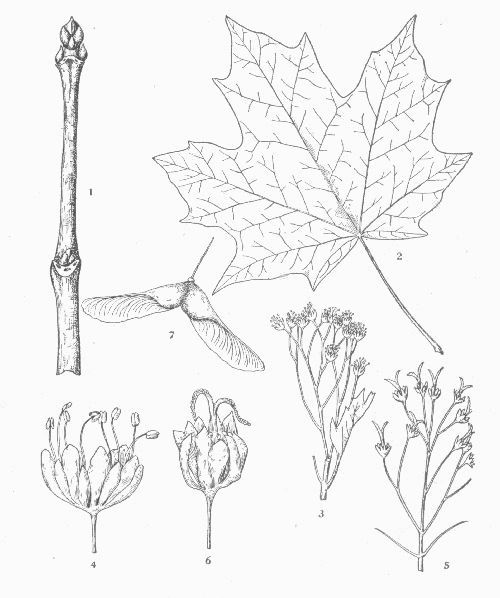
HABIT.—A tall, handsome tree, with a height of 40-60 feet, and a trunk diameter of 1-2 feet, having a round, spreading crown of stout branches, resembling A. saccharum. Twigs coarse.
LEAVES.—Opposite, simple, 5-7 inches broad, and almost as long; thin; 5-7-lobed at maturity, lobes remotely coarse-toothed with the teeth drawn out into filamentous points, separated by rounded, scallop-like sinuses; glabrous, bright green both sides, turning pale yellow in autumn; petioles long, slender, exuding a milky juice when cut.
FLOWERS.—May-June, before or with the leaves; dioecious; large, yellow-green, in erect, short, flat racemes; sepals 5; petals 5; stamens 8.
FRUIT.—Ripens in autumn and germinates the following spring; pendent on long stalks; large, glabrous, paired samaras, with wings 2 inches long, diverging by nearly 180°.
WINTER-BUDS.—Yellow-green, red or dull red-brown; terminal bud about 1/4 inch long, broad, short-stalked, with bud-scales strongly keeled; lateral buds small, appressed; buds exuding a milky juice when cut.
BARK.—Twigs lustrous, light brown to greenish; trunk dark gray, becoming closely fissured, not scaly.
WOOD.—Moderately heavy, hard, close-grained, whitish or brownish, with white sapwood.
NOTES.—Exotic from Europe. Extensively planted in cities for its abundant shade. The roots strike deep and spread laterally, enabling the tree to hold its own in a city environment. It holds its leaves two weeks longer in autumn than do our native maples. A rapid grower.
Sycamore Maple
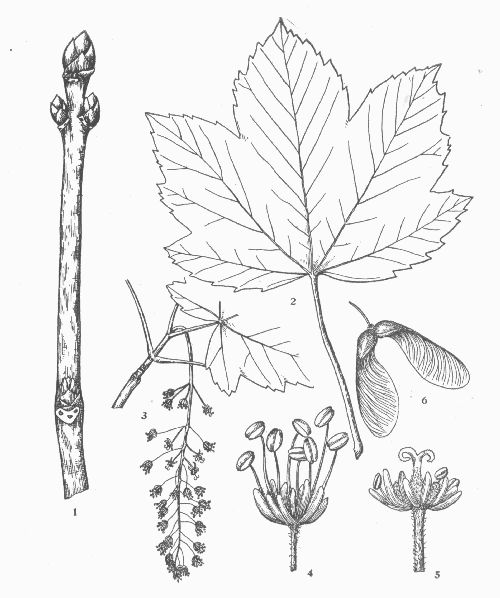
HABIT.—A thrifty tree 50-60 feet high, with a trunk diameter of 2-3 feet; the crown roundish, spreading.
LEAVES.—Opposite, simple, 4-7 inches across, and as long as broad; thick; pentagonally 5-lobed, the lobes more or less ovate, separated by very narrow, acute sinuses extending about half-way to the midrib, the lobes coarsely and irregularly blunt-serrate, crenate-serrate, or slightly lobed; upper surface dark green and shining, somewhat wrinkled, but paler dull green and glaucous beneath; petioles long, stout.
FLOWERS.—April, before the leaves; polygamo-monoecious; large, greenish yellow, in pendent racemes of umbellate cymes of about three each; sepals 5; petals 5; stamens 8, hairy; ovary hairy.
FRUIT.—Ripens in autumn and germinates the following spring; pendent on long stalks; large, glabrous, paired samaras, with wings 1-1/2 inches long, diverging at about a right angle.
WINTER-BUDS.—Bright green; terminal bud 1/4-1/2 inch long, ovoid to subglobose, blunt, with bud-scales more or less keeled; lateral buds small, divergent.
BARK.—Twigs lustrous, brown or gray, becoming slate colored on the branches; trunk gray or brownish, smooth or flaking off in short scales.
WOOD.—Moderately heavy, hard, compact, brownish, with white sapwood.
NOTES.—Exotic from Europe. Much planted in our cities, where it is thrifty, but short-lived. The crown is rather too broad for planting anywhere except on our widest streets. The leaves last two weeks longer in autumn than do those of our native maples.
Boxelder. Ash-leaved Maple
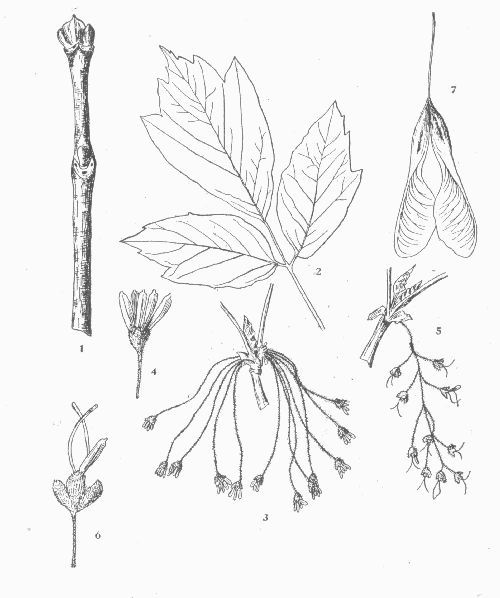
HABIT.—A sturdy little tree 30-50 feet high, with a trunk diameter of 1-2 feet. Trunk often divides near the ground into several stout, wide-spreading branches, forming a broad, unsymmetrical, open crown.
LEAVES.—Opposite, pinnately compound. Leaflets 3-5 in number, 2-4 inches long, 1-1/2-2-1/2 inches broad; ovate or oval; nearly entire, irregularly and remotely coarse-toothed above the middle, or sometimes 3-lobed (often giving the leaflet a jagged outline); apex acute, base variable; glabrous or somewhat pubescent at maturity, with prominent veins. Petioles slender, 2-3 inches long, the enlarged base leaving prominent crescent-shaped scars partly surrounding the winter-buds.
FLOWERS.—April, before or with the leaves; dioecious; small, yellow-green; the staminate in clusters on long, thread-like, hairy pedicels; the pistillate in narrow, drooping racemes; calyx hairy, 5-lobed; corolla 0; stamens 4-6; ovary pubescent.
FRUIT.—Early summer, but hanging until late autumn or early spring; narrow, flat, winged samaras, in pairs, clustered in drooping, racemose clusters.
WINTER-BUDS.—Terminal bud 1/8-1/4 inch long, acute, inclosed in two dull red scales, often hoary or minutely pubescent; lateral buds obtuse, appressed.
BARK.—Twigs greenish to purple, glaucous; trunk pale gray or light brown, deeply cleft into broad ridges.
WOOD.—Light, soft, close-grained, weak, creamy white, with thick, hardly distinguishable sapwood.
DISTRIBUTION.—Lower Peninsula as far north as Saginaw Bay.
HABITAT.—Banks of streams and borders of swamps. Prefers deep, moist soil.
NOTES.—Accommodates itself to almost any situation. Easily transplanted. Much planted for shade and ornament. Fast-growing, but short-lived.
| a. | Leaflets usually 5; foliage ill-smelling when bruised; bark broken into thick plates; prickly bur about 1 inch in diameter. | A. glabra, p. 199. |
| aa. | Leaflets usually 7; foliage not ill-smelling when bruised; bark broken into thin plates; prickly bur about 2 inches in | A. hippocastanum, p. 197. |
| a. | Terminal bud about 2/3 inch long; bud-scales covered with a glaucous bloom, not conspicuously resinous; bark broken into thick plates; prickly bur about 1 inch in diameter. | A. glabra, p. 199. |
| aa. | Terminal bud 1-1-1/2 inches long; bud-scales conspicuously sticky-resinous, glistening; bark broken into thin plates; prickly bur about 2 inches in diameter. | A. hippocastanum, p. 197. |
Horse-chestnut
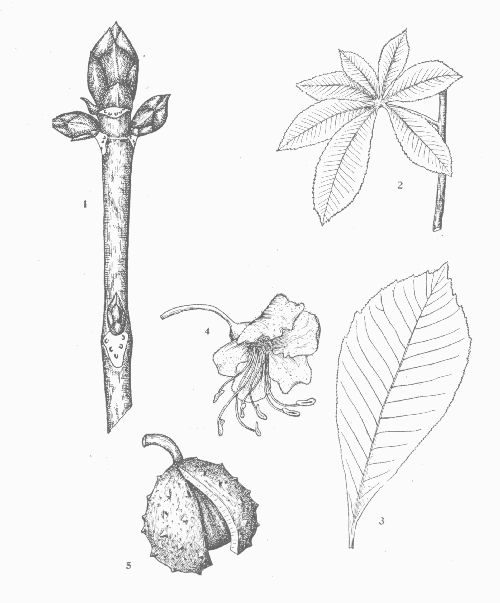
HABIT.—A handsome tree, with a height of 40-60 feet and a trunk diameter of 1-2 feet, forming a broad, conical crown. The regularly occurring branches ascend from the trunk at first, gradually bend downwards as they lengthen, and end in a thick, upturning spray.
LEAVES.—Opposite, digitately compound. Leaflets usually 7, rarely 5, 5-7 inches long, 1-1/2-2-1/2 inches broad; obovate, wedge-shaped at the base; irregularly and bluntly serrate; thick; rough, dark green above, paler beneath, turning a rusty yellow in autumn. Petioles long, grooved, swollen at the base.
FLOWERS.—May-June, after the leaves; polygamo-monoecious; large, whitish, in showy, upright, terminal thyrses 8-12 inches long; pedicels jointed, 4-6-flowered; calyx campanulate, 5-lobed; petals 5, white, spotted with yellow and red, clawed; stamens 7, thread-like, longer than the petals.
FRUIT.—October; a leathery, globular capsule about 2 inches in diameter, roughened with short spines; containing 1-3 large, smooth, lustrous, brown nuts, marked by large, pale scars.
WINTER-BUDS.—Terminal buds 1-1-1/2 inches long, acute, brownish, covered with glistening, resinous gum; inner scales yellowish, becoming 1-1/2-2 inches long in spring, remaining until the leaves are nearly half grown.
BARK.—Twigs smooth, red-brown; trunk dark brown and broken into thin plates by shallow fissures; rich in tannin, bitter.
WOOD.—Light, soft, close-grained, weak, whitish, with thin, light brown sapwood.
NOTES.—A native of Greece, extensively cultivated throughout Europe and America, where it is a favorite shade tree. A double-flowered variety, Aesculus hippocastanum, v. flòre plèno, which bears no fruit is a common garden form.
Ohio Buckeye
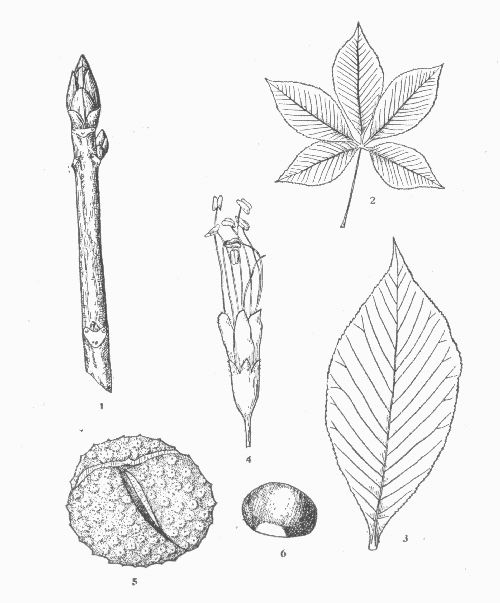
HABIT.—A medium-sized tree 30-50 feet in height, with a trunk not over 2 feet in diameter; usually much smaller; slender, spreading branches, forming a broad, rounded crown; twigs thick.
LEAVES.—Opposite, digitately compound. Leaflets usually 5, rarely 7, 3-6 inches long, 1-1/2-2-1/2 inches broad; ovate or oval, gradually narrowed to the entire base; irregularly and finely serrate; glabrous, yellow-green above, paler beneath, turning yellow in autumn. Petioles 4-6 inches long, slender, enlarged at the base. Foliage ill-smelling when bruised.
FLOWERS.—April-May, after the leaves; polygamo-monoecious; small, yellow-green, in terminal panicles 5-6 inches long and 2-3 inches broad, more or less downy; pedicels 4-6-flowered; calyx campanulate, 5-lobed; petals 4, pale yellow, hairy, clawed; stamens 7, with long, hairy filaments.
FRUIT.—October; a thick, leathery, prickly capsule, about 1 inch in diameter, containing a single large, smooth, lustrous, brown nut. A large pale scar gives the name “Buckeye.”
WINTER-BUDS.—Terminal buds 2/3 inch long, acute, resinous, brownish; inner scales yellow-green, becoming 1-1/2-2 inches long in spring and remaining until the leaves are nearly half grown.
BARK.—Twigs smooth, red-brown, becoming ashy gray; old trunks densely furrowed and broken into thick plates; ill-smelling when bruised.
WOOD.—Light, soft, close-grained, weak, whitish, with thin, light brown sapwood.
NOTES.—A native of the Mississippi River Valley. Occasionally planted in southern Michigan for ornamental purposes, but is less popular than the Horse-chestnut.
Basswood
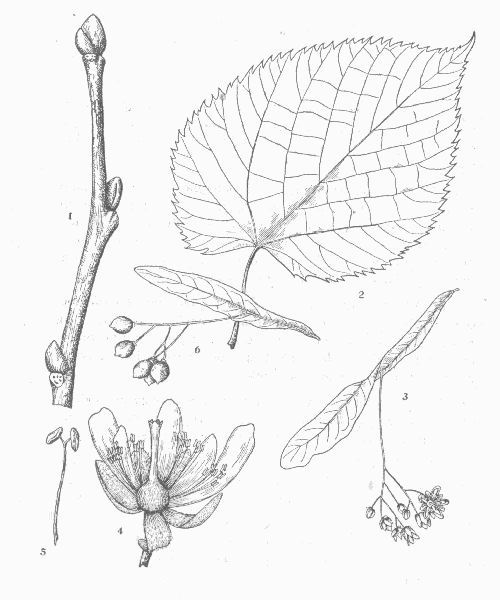
HABIT.—A tree usually 60-70 feet high, with a tall, straight trunk 2-4 feet in diameter; numerous slender branches form a dense, ovoid or rounded crown.
LEAVES.—Alternate, simple, 5-6 inches long, 3-4 inches broad; obliquely heart-shaped; coarsely serrate; thick and firm; glabrous, dull dark green above, paler beneath; petioles slender, 1-2 inches long.
FLOWERS.—June-July, after the leaves; perfect, regular; yellowish white, downy, fragrant; borne on slender pedicels in loose, drooping cymes, the peduncle attached for half its length to a narrow, oblong, yellowish bract; sepals 5, downy; petals 5, creamy white; stamens numerous, in 5 clusters; ovary 5-celled; stigma 5-lobed.
FRUIT.—October; globose, nut-like, woody, gray, tomentose, about the size of peas.
WINTER-BUDS.—Terminal bud absent; lateral buds ovoid, acute, often lopsided, smooth, dark red, 1/4 inch long.
BARK.—Twigs smooth, reddish gray, becoming dark gray or brown; dark gray and smooth on young stems, on old trunks thick, deeply furrowed into broad, scaly ridges.
WOOD.—Light, soft, close-grained, tough, light red-brown, with thick sapwood of nearly the same color.
DISTRIBUTION.—Common in most parts of the Lower Peninsula, frequent in the Upper Peninsula.
HABITAT.—Prefers rich, well-drained, loamy soils.
NOTES.—Rapid in growth. Easily transplanted. Recommended for street and ornamental planting.
| a. | Leaves mostly alternate; branches usually greenish; flowers not surrounded by large petal-like bracts; fruit globular, blue, borne many in loose clusters. | C. alternifolia, p. 207. |
| aa. | Leaves opposite; branches usually reddish or yellowish; flowers surrounded by large petal-like bracts; fruit ovoid, scarlet, borne in close clusters of 3-4. | C. florida, p. 205. |
| a. | Leaf-scars mostly alternate; buds light brown; branches usually greenish. | C. alternifolia, p. 207. |
| aa. | Leaf-scars opposite; buds greenish; branches usually reddish or yellowish. | C. florida, p. 205. |
Flowering Dogwood. Dogwood. Boxwood
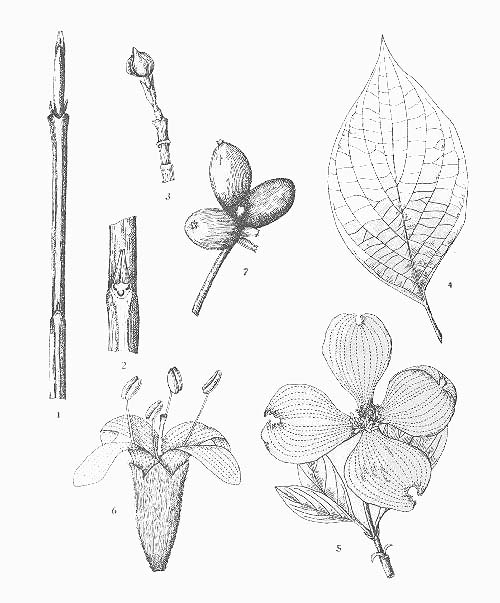
HABIT.—A bushy tree with a height of 15-30 feet and a short trunk 8-12 inches in diameter; slender, spreading branches form a flat-topped crown.
LEAVES.—Opposite, closely clustered at the ends of the branchlets, simple, 3-5 inches long, 2-3 inches broad; ovate to elliptical; obscurely wavy-toothed; thick and firm; bright green, covered with minute, appressed hairs above, pale and more or less pubescent beneath, turning bright scarlet in autumn; petioles short, grooved.
FLOWERS.—May, with the leaves; perfect; greenish; in dense clusters, surrounded by 4 large, white or pinkish, petal-like bracts (often mistaken for the corolla), borne on short, stout peduncles; calyx 4-lobed, light green; petals 4, yellow-green; stamens 4, alternate with the petals; ovary 2-celled.
FRUIT.—October; an ovoid, scarlet drupe, borne in close clusters of 3-4; flesh is bitter.
WINTER-BUDS.—Leaf-buds narrow-conical, acute, greenish; flower-buds spherical or vertically flattened, grayish.
BARK.—Twigs pale green, becoming red or yellow-green their first winter, later becoming light brown or red-gray; red-brown or blackish on the trunk, often separating into quadrangular, plate-like scales.
WOOD.—Heavy, hard, strong, tough, close-grained, brownish, with thick, lighter colored sapwood.
DISTRIBUTION.—Southern Michigan as far north as the Grand-Saginaw Valley.
HABITAT.—Prefers rich, well-drained soil, usually under the shade of other trees.
NOTES.—A valuable species for ornamental purposes. Rather slow of growth.
Blue Dogwood. Alternate-leaved Dogwood
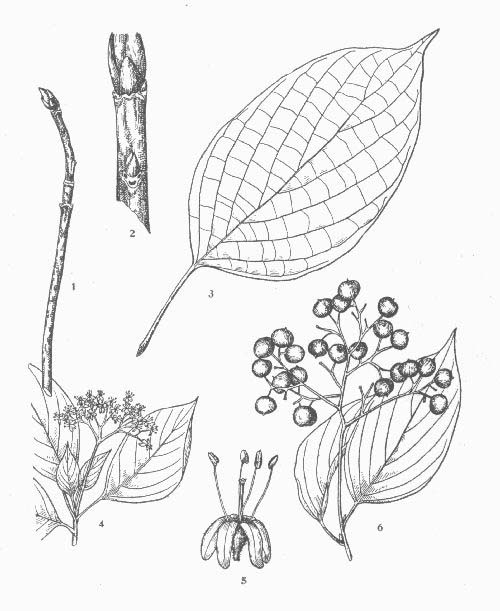
HABIT.—A small tree or large shrub reaching a height of 25-30 feet and a trunk diameter of 6-8 inches; more often smaller than this. The long, slender branches are arranged in irregular whorls, forming flat, horizontal tiers, giving the tree a storied effect.
LEAVES.—Mostly alternate and clustered at the ends of the branchlets; simple, 3-5 inches long, 2-1/2-3 inches broad; oval or ovate, long-pointed, wedge-shaped at the base; obscurely wavy-toothed; thin; dark green, nearly glabrous above, paler and covered with appressed hairs beneath, turning yellow and scarlet in autumn; petioles slender, grooved, hairy, with clasping bases.
FLOWERS.—May-June, after the leaves; perfect; borne on slender pedicels in many-flowered, irregular, open cymes from the season’s shoots; calyx cup-shaped, obscurely 4-toothed, covered with fine, silky, white hairs; petals 4, cream colored; stamens 4; ovary 2-celled.
FRUIT.—October; a globular, blue-black drupe, borne in loose, red-stemmed clusters; flesh bitter.
WINTER-BUDS.—Leaf-buds small, acute, light brown; flower-buds spherical or vertically flattened.
BARK.—Twigs greenish or reddish, becoming smooth, dark green; thin, dark red-brown and shallowly fissured on the trunk.
WOOD.—Heavy, hard, close-grained, red-brown, with thick, lighter colored sapwood.
DISTRIBUTION.—Scattered throughout both peninsulas.
HABITAT.—Prefers moist, well-drained soil on the borders of streams and swamps, often in the shade of other trees.
NOTES.—Hardy throughout the state. Easily transplanted. The only Cornus with alternate leaves and branches.
Black Gum. Pepperidge
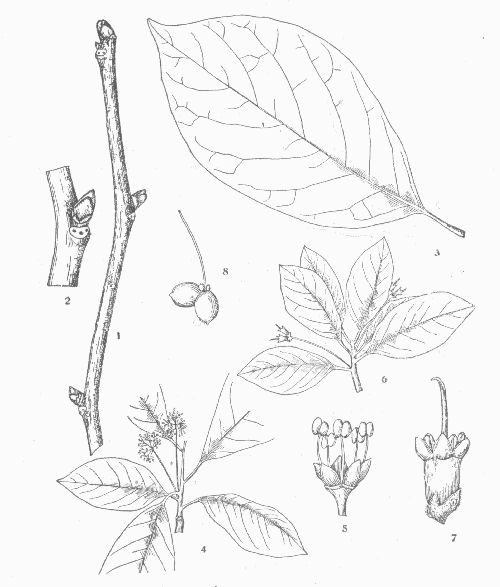
HABIT.—A medium-sized tree 40-50 feet high, with a trunk diameter of 1-2 feet, forming a rounded to cylindrical crown of slender, spreading, pendulous branches and a stiff, flat spray.
LEAVES.—Alternate, simple, 2-5 inches long, one-half as broad; oblong-obovate to oval; entire, or sometimes wavy-margined; thick and firm; very lustrous and dark green above, pale and often hairy beneath, turning bright scarlet, on the upper surface only, in autumn; petioles short.
FLOWERS.—May-June, with the leaves; polygamo-dioecious; greenish; borne on slender, downy peduncles; the staminate slender-pedicelled, in many-flowered heads; the pistillate sessile, in several-flowered clusters; calyx cup-shaped, 5-toothed; petals 5; stamens 5-10; stigma stout, terete, recurved.
FRUIT.—October; fleshy drupes, ovoid, blue-black, about 1/2 inch long, sour, in clusters of 1-3.
WINTER-BUDS.—1/8-1/4 inch long, ovoid, obtuse, dark red.
BARK.—Twigs greenish or light brown, smooth or often downy, becoming smooth, dark red-brown; thick, red-brown on old trunks, deeply furrowed.
WOOD.—Heavy, soft, strong, very tough, difficult to split, not durable in contact with the soil, pale yellow, with thick, whitish sapwood.
DISTRIBUTION.—Frequent in the southern half of the Lower Peninsula. Has been reported as far north as Manistee.
HABITAT.—Prefers the borders of swamps and low, wet lands. Rarely flourishes in exposed situations.
NOTES.—Of great ornamental value. Not easily transplanted. Pith of twigs with thin, transverse partitions.
| a. | Lateral leaflets sessile. | F. nigra, p. 221. | |||
| aa. | Lateral leaflets petioluled. | ||||
| b. | Twigs, petioles and lower sides of leaves pubescent. | F. pennsylvanica, p. 215. | |||
| bb. | Twigs, petioles and lower sides of leaves essentially glabrous. | ||||
| c. | Twigs prominently 4-angled. | F. quadrangulata, p. 219. | |||
| cc. | Twigs terete. | ||||
| d. | Lower sides of leaves essentially of the same color as the upper; leaflet-margins rather finely sharp-serrate. | F. pennsylvanica lanceolata, p. 217. | |||
| dd. | Lower sides of leaves paler than the upper; leaflet-margins entire or obscurely serrate. | F. americana, p. 213. | |||
| a. | Twigs prominently 4-angled; fruit falling in early autumn. | F. quadrangulata, p. 219. | |||
| aa. | Twigs terete; fruit often persistent on the tree until mid-winter or the following spring. | ||||
| b. | Buds rusty-tomentose; twigs more or less downy. | F. pennsylvanica, p. 215. | |||
| bb. | Buds not tomentose; twigs not downy. | ||||
| c. | Terminal bud black or nearly so, showing 3 pairs of scales in cross-section; bud-scales apiculate at the apex; samaras with broad wings, the seed portion flattish; bark flaky, rubbing off on the hand. | F. nigra, p. 221. | |||
| cc. | Terminal bud brownish, showing 4 pairs of scales in cross-section; bud-scales rounded at the apex; samaras with narrow wings, the seed portion terete; bark ridged, not flaky and rubbing off on the hand. | ||||
| d. | Upper margin of leaf-scars deeply concave. | F. americana, p. 213. | |||
| dd. | Upper margin of leaf-scars not concave, but straight across or projecting upward. | F. pennsylvanica lanceolata, p. 217. | |||
White Ash
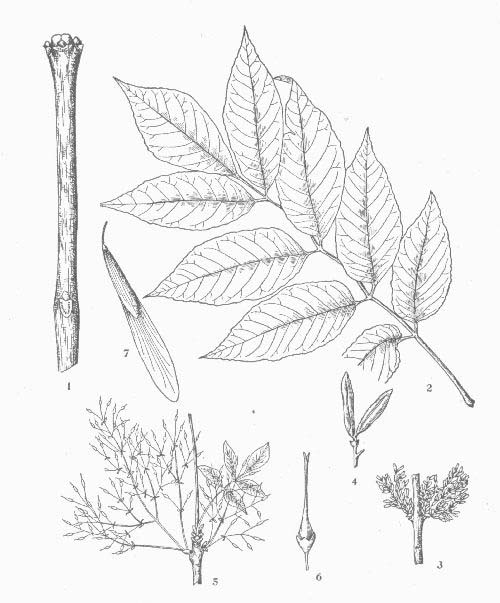
HABIT.—A large tree 50-75 feet high, with a trunk diameter of 2-3 feet; forming an open, pyramidal crown of long, slender, lateral branches and a stout, rather sparse spray.
LEAVES.—Opposite, pinnately compound, 8-12 inches long. Leaflets usually 7-9, 3-5 inches long, 1-2 inches broad; short-stalked; ovate to oblong-lanceolate; entire or obscurely serrate; thick and firm; glabrous, dark green above, paler beneath. Petioles glabrous, stout, grooved.
FLOWERS.—May, before the leaves; dioecious; borne in loose panicles on shoots of the previous season; calyx campanulate, 4-lobed; corolla 0; stamens 2, rarely 3; ovary 2-celled.
FRUIT.—August-September, persistent on the branches until mid-winter or the following spring; samaras 1-2 inches long, in crowded, drooping, paniculate clusters 6-8 inches long.
WINTER-BUDS.—Short, rather obtuse; bud-scales apiculate, keeled, 4 pairs, rusty-brown.
BARK.—Twigs at first dark green, becoming gray or light brown, often covered with a glaucous bloom; gray, deeply furrowed into firm, narrow, flattened ridges on the trunk.
WOOD.—Heavy, hard, strong, close-grained, tough, brown, with thick, lighter colored sapwood.
DISTRIBUTION.—Of common occurrence throughout the state.
HABITAT.—Prefers a rich, moist, loamy soil, but grows in any well-drained situation; common along stream-beds.
NOTES.—Grows rapidly. Easily transplanted. Fairly free from disease. Leaves appear late in spring.
Red Ash
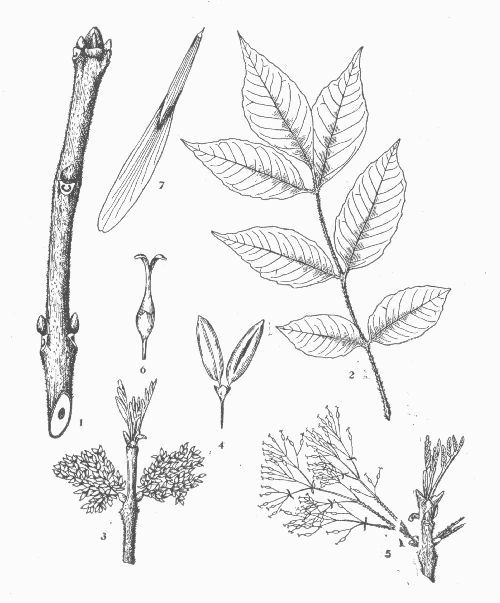
HABIT.—A medium-sized tree 30-50 feet high, with a trunk diameter of 1-2 feet; stout, upright branches and slender branchlets form a compact, broad, irregular crown.
LEAVES.—Opposite, pinnately compound, 10-12 inches long. Leaflets 7-9, 3-5 inches long, 1-1-1/2 inches broad; short-stalked; oblong-lanceolate to ovate; slightly serrate or entire; thin and firm; glabrous, yellow-green above, pale and silky-downy beneath. Petioles stout, pubescent.
FLOWERS.—May, with the leaves; dioecious; borne in compact, downy panicles on shoots of the previous season; calyx cup-shaped, 4-toothed; corolla 0; stamens 2, rarely 3; ovary 2-celled.
FRUIT.—Early autumn, persistent on the branches throughout the winter; samaras 1-2 inches long, in open, paniculate clusters.
WINTER-BUDS.—Small, rounded; bud-scales rounded on the back, 3 pairs, rusty-brown, tomentose.
BARK.—Twigs pale-pubescent at first, lasting 2-3 years or often disappearing during the first summer, finally ashy gray or brownish and often covered with a glaucous bloom; brown or dark gray on the trunk, with many longitudinal, shallow furrows; somewhat scaly.
WOOD.—Heavy, hard, strong, brittle, coarse-grained, light brown, with thick, yellow-streaked sapwood.
DISTRIBUTION.—Not a common tree. Most frequent in the southern half of the Lower Peninsula, but has been reported further north, i.e., Drummond’s Island and Keweenaw County, Upper Peninsula.
HABITAT.—Prefers wet or moist, rich loam; river-banks; swampy lowlands.
NOTES.—A rapid grower in youth. Fairly immune from insect and fungous diseases.
Green Ash
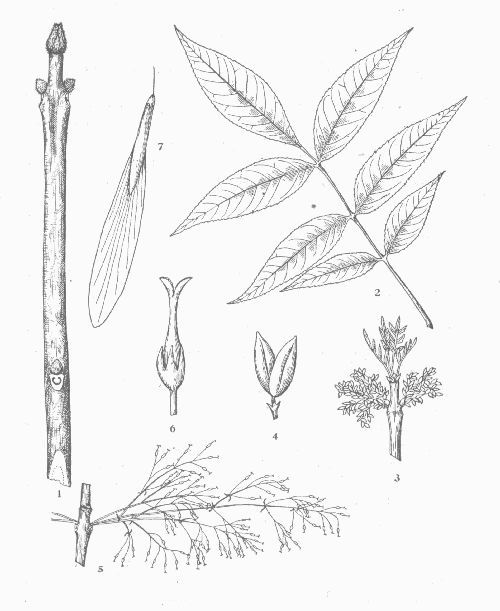
Considered by some authors to be a distinct species, and by others a variety of F. pennsylvanica Marsh., which it resembles. The main points of difference are:
The usual absence of pubescence from the branchlets, the underside of the leaflets, and the petioles.
The rather narrower, shorter, and more sharply serrate leaflets.
The color of the leaves, which is bright green on both sides.
A very hardy tree, of rapid growth and desirable habit, making it useful for ornamental and street planting. Easily transplanted.
Of rare occurrence in Michigan, but has been reported from several localities.
Blue Ash
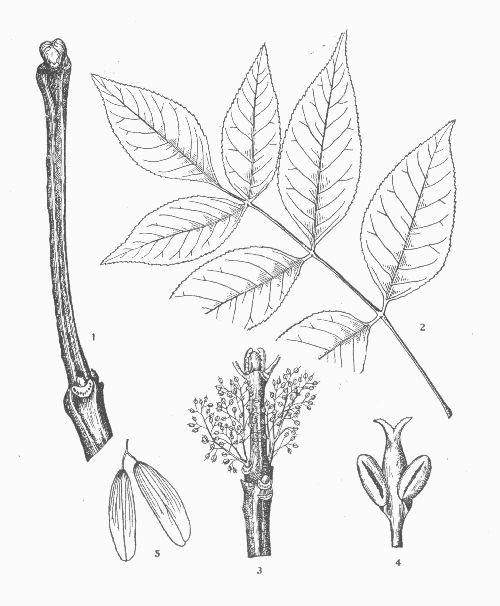
HABIT.—A large tree 50-80 feet high, with a trunk diameter of 1-3 feet; small, spreading branches and stout, 4-angled, more or less 4-winged branchlets form a narrow crown.
LEAVES.—Opposite, pinnately compound, 8-12 inches long. Leaflets 5-9, usually 7, 3-5 inches long, 1-2 inches broad; short-stalked; ovate-oblong to lanceolate, long-pointed; coarsely serrate; thick and firm; yellow-green above, paler beneath, glabrous. Petioles slender, glabrous.
FLOWERS.—April, before the leaves; perfect; borne in loose panicles on shoots of the previous season; calyx reduced to a ring; corolla 0; stamens 2; ovary 2-celled.
FRUIT.—September-October, falling soon after; samaras 1-2 inches long, in long, loose, paniculate clusters.
WINTER-BUDS.—Short, rather obtuse; bud-scales rounded on the back, 3 pairs, dark red-brown, somewhat pubescent.
BARK.—Twigs orange, rusty-pubescent, becoming brownish or grayish; on the trunk light gray tinged with red, irregularly divided into large, plate-like scales, often with the shaggy appearance of a Shagbark Hickory.
WOOD.—Heavy, hard, close-grained, brittle, light yellow streaked with brown, with thick, light yellow sapwood.
DISTRIBUTION.—Occasionally in the southern half of the Lower Peninsula. Nowhere abundant.
HABITAT.—Prefers rich, limestone hills, but grows well in fertile bottom-lands.
NOTES.—Hardy and grows rapidly. A blue dye is made by macerating the inner bark in water.
Black Ash
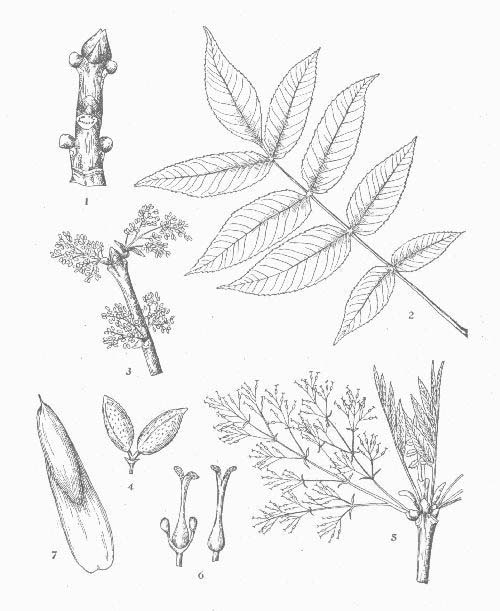
HABIT.—A tall tree 60-80 feet high, with a trunk diameter of 1-2 feet; slender, upright branches form in the forest a narrow crown, in the open a rounded, ovoid crown.
LEAVES.—Opposite, pinnately compound, 12-16 inches long. Leaflets 7-11, 3-5 inches long, 1-2 inches broad; sessile, except the terminal; oblong to oblong-lanceolate, long-pointed; remotely, but sharply serrate; thin and firm; dark green above, paler beneath, glabrous. Petioles stout, grooved, glabrous.
FLOWERS.—May, before the leaves; polygamo-dioecious; borne in loose panicles on shoots of the preceeding season; calyx 0; corolla 0; stamens 2; ovary 2-celled.
FRUIT.—August-September, falling early, or sometimes hanging on the tree until the following spring; samaras 1-1-1/2 inches long, in open, paniculate clusters 8-10 inches long.
WINTER-BUDS.—Ovoid, pointed; bud-scales rounded on the back, 3 pairs, almost black.
BARK.—Twigs at first dark green, becoming ashy gray or orange, finally dark gray and warted; thin, soft ash-gray and scaly on the trunk. Bark flakes off on rubbing with the hand.
WOOD.—Heavy, tough, coarse-grained, weak, rather soft, dark brown, with thin, lighter colored sapwood.
DISTRIBUTION.—Common throughout most portions of Michigan.
HABITAT.—Prefers deep, cold swamps and low river-banks, but grows in any good soil.
NOTES.—Hardy throughout the state. Not easily transplanted. Foliage falls early in autumn.
| a. | Leaves 5-8 inches long, thick; flowers 1-1/2 inches across, prominently yellow-spotted; seeds with pointed, fringed wings at each end; branches rather crooked and straggling; bark thin, separating into thin scales on the trunk. | C. bignonioides, p. 227. |
| aa. | Leaves 8-12 inches long, thin; flowers 2-1/2 inches across, not prominently spotted; seeds with rounded, wide-fringed wings at each end; branches not crooked and straggling; bark thick, separating into thick scales on the trunk. | C. speciosa, p. 225. |
| a. | Fruiting capsules about 1/4 inch thick; seeds with pointed, fringed wings at each end; branches rather crooked and straggling; bark thin, separating into thin scales on the trunk. | C. bignonioides, p. 227. |
| aa. | Fruiting capsules about 1/2 inch thick, seeds with rounded, wide-fringed wings at each end; branches not crooked and straggling; bark thick, separating into thick scales on the trunk. | C. speciosa, p. 225. |
Hardy Catalpa
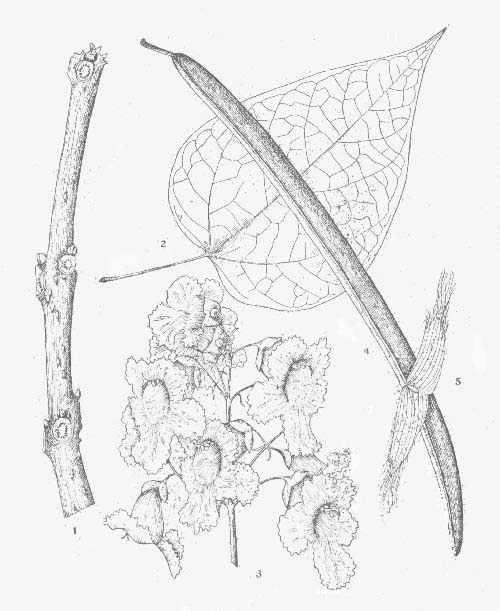
HABIT.—A tree 50-75 feet high, with a short, often crooked trunk and a broad, rounded crown of slender, spreading branches and thick branchlets.
LEAVES.—Opposite or whorled, simple, 8-12 inches long, 6-8 inches broad; heart-shaped; entire or sometimes slightly lobed; thick and firm; glabrous, dark green above, downy beneath, with clusters of dark, nectariferous glands in the axils of the primary veins, turning black and falling with the first severe frost; petioles long, stout, terete.
FLOWERS.—June-July, after the leaves are full grown; perfect; borne on slender, purplish pedicels in open, few-flowered panicles 5-6 inches long; calyx 2-lobed, purple; corolla white with inconspicuous yellow spots, campanulate, 5-lobed, 2-1/2 inches broad; stamens 2, staminodia 3; ovary 2-celled.
FRUIT.—Ripens in early autumn; slender, 2-celled, cylindrical capsule 10-20 inches long and about 1/2 inch thick; hangs on tree all winter, opening in spring before falling; seeds light brown, 1 inch long, with rounded, wide-fringed wings at each end.
WINTER-BUDS.—Terminal bud absent; lateral buds brownish, globose, inconspicuous.
BARK.—Twigs greenish, often with purple tinge, becoming orange or red-brown and covered with a slight bloom the first winter, finally darker with age; thick, red-brown, broken into thick scales on the trunk,
WOOD.—Light, soft, weak, coarse-grained, light brown, with very thin, almost white sapwood; very durable in contact with the soil.
NOTES.—A native of Illinois, Indiana, and the states adjoining on the south, but much planted in Michigan as a shade and ornamental tree. Closely resembles C. bignonioides, but is a larger and hardier tree.
Catalpa
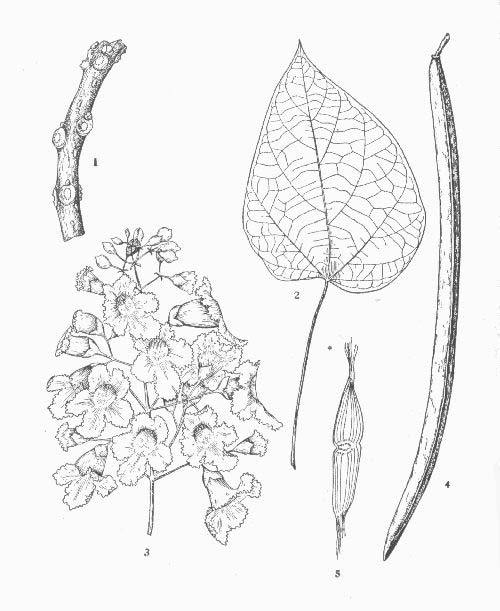
HABIT.—A tree 40-30 feet high, with a short, thick trunk and a broad, irregular crown of long, crooked branches and coarse, upright branchlets.
LEAVES.—Opposite or whorled, simple, 5-8 inches long, 4-5 inches broad; heart-shaped; entire or sometimes slightly lobed; thin and firm; glabrous, light green above, downy beneath, with dark, nectariferous glands in the axils of the primary veins, turning black and falling with the first severe frost; petioles long, stout, terete.
FLOWERS.—June-July, after the leaves are full grown; perfect; borne on slender, hairy pedicels in compact, many-flowered panicles 8-10 inches long; calyx 2-lobed, green or purple; corolla white with yellow spots, campanulate, 5-lobed, 1-1/2 inches broad; stamens 2, staminodia 3; ovary 2-celled.
FRUIT.—Ripens in early autumn; slender, 2-celled, cylindrical capsule 8-20 inches long and about 1/4 inch thick; hangs on tree all winter, opening in spring before falling; seeds silvery gray, 1 inch long, with pointed, fringed wings at each end.
WINTER-BUDS.—Terminal bud absent; lateral buds, brownish, globose, inconspicuous.
BARK.—Twigs greenish purple, becoming red-brown and marked by a network of thin, flat ridges; thin, red-brown on the trunk, separating into large, thin, irregular scales.
WOOD.—Light, soft, weak, coarse-grained, light brown, with very thin, whitish sapwood; very durable in contact with the soil.
NOTES.—A native of the Lower Mississippi River Basin, but naturalized in southern Michigan, where it is a popular shade and ornamental tree. Foliage appears very tardily in spring.
Sheepberry. Nannyberry
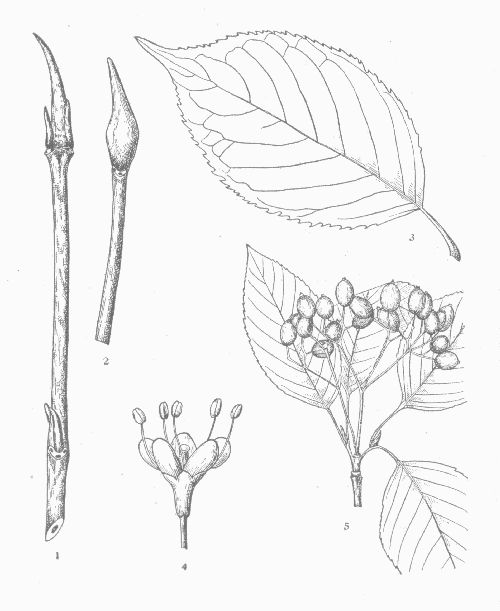
HABIT.—A low tree or shrub 15-25 feet high, with a short trunk 6-10 inches in diameter; numerous tortuous branches form a wide, compact, rounded crown.
LEAVES.—Opposite, simple, 2-4 inches long, one-half as broad; ovate to suborbicular; finely and sharply serrate; thick and firm; lustrous, bright green above, pale and marked with tiny black dots beneath; petioles broad, grooved, more or less winged, about 1 inch long.
FLOWERS.—May-June, after the leaves; perfect; small; cream-white, borne in stout-branched, scurfy, flat, terminal cymes 3-5 inches across; calyx tubular, 5-toothed; corolla 5-lobed, cream color or white, 1/4 inch across; stamens 5, with yellow anthers; ovary 1-celled, with short, thick, green style and broad stigma.
FRUIT.—September; a fleshy drupe, 1/2 inch long, ovoid, flattened, blue-black, borne in few-fruited, red-stemmed clusters; stone oval, flat, rough; flesh sweet, edible.
WINTER-BUDS.—Leaf-buds narrow, acute, red, scurfy-pubescent, 1/2 inch long; flower-buds swollen at the base, with spire-like apex, grayish with scurfy pubescence, 3/4 inch long.
BARK.—Twigs at first light green, rusty-pubescent, becoming dark red-brown; red-brown on old trunks and broken into small, thick plates.
WOOD.—Heavy, hard, close-grained, ill-smelling, dark orange-brown, with thin, whitish sapwood.
DISTRIBUTION.—Frequent throughout the state.
HABITAT.—Prefers rich, moist soil along the borders of forests; roadsides; river-banks.
NOTES.—Too small for street use. Propagated from seed or by cuttings.
C Although formerly classed under PINACEAE, recent investigations show it to be the type of a distinct family.
D It is not intended that this key shall serve as a means of identification of any species of Salix found in Michigan, but it has added simply to give a ready comparison of the four species which are described.
E It is difficult to distinguish between these species in the absence of summer characters. If leaves can be found on or beneath a tree which is sufficiently segregated from similar trees as to avoid any chance for error, the summer key on the opposite page may be used.
F A discussion has recently arisen as to whether Betula lenta actually exists in the state, some botanists preferring the name B. alleghanensis Britt. for the tree we have so long called Black Birch. Pending further investigation the authors have thought best to retain the old name.
Ref.—Britton: North American Trees, pp. 257-8.
G [1] means that the acorns mature in the autumn of the first season, hence mature acorns will not be found on the tree, but on the ground beneath the tree.
[2] means that the acorns mature in the autumn of the second season, hence immature acorns will be found on the last season’s twigs, and mature acorns on the ground beneath the tree.
Abortion. Imperfect development or non-development of an organ or part.
Acuminate. Gradually tapering to the apex. Page xii.
Acute. Terminating with a sharp angle. Page xii.
Alternate. Said of leaves, branches, buds, etc., scattered singly along the stem; not opposite.
Androgynous. Composed of both staminate and pistillate flowers.
Anterior. The front side of a flower, remote from the axis of inflorescence.
Anther. The part of a stamen which bears the pollen. Page xiii..
Apetalous. Without petals.
Apex. The top, as the tip of a bud or the end of a leaf which is opposite the petiole.
Apiculate. Ending in a short-pointed tip.
Appressed. Lying close and flat against.
Aromatic. Fragrant; with an agreeable odor.
Axil. The upper one of the two angles formed by the juncture of a leaf with a stem.
Axillary. Situated in an axil.
Bark. The outer covering of a trunk or branch.
Bearded. Bearing a long, bristle-like appendage, or furnished with long or stiff hairs.
Berry. A fruit which is fleshy throughout.
Bi-pinnate. Twice pinnate.
Blade. The expanded portion of a leaf, etc.
Bloom. A powdery or waxy substance easily rubbed off.
Bract. A more or less modified leaf subtending a flower or belonging to an inflorescence.
Branch. A secondary division of a trunk.
Branchlet. A small branch.
Bud. An undeveloped stem or branch, with or without scales.
Bud-scales. Modified leaves covering a bud.
Bundle-scars. Dots on the surface of a leaf-scar, which are scars left by the fibro-vascular bundles which run through the petiole into the blade of the leaf. Page xvi.
Bur. A spiny fruit.
[Pg 232] Calyx. The outer part of a perianth, usually green in color. Page xiii..
Campanulate. Bell-shaped.
Capsule. A dry fruit of more than one carpel which splits at maturity to release the seeds.
Carpel. A simple pistil, or one member of a compound pistil.
Catkin. A spike of unisexual flowers, each subtended by a bract, and usually deciduous in one piece.
Chambered. Said of pith which is interrupted by hollow spaces.
Ciliate. Fringed with hairs on the margin.
Cinereous. Ash-gray color.
Claw. The narrow, stalk-like base of a petal, sepal, etc.
Cleft. Cut about half-way to the middle.
Cluster. A group of two or more organs (flowers, fruit, etc.) on a plant at a node or end of a stem.
Compound. Composed of two or more similar parts united into a whole. Compound leaf, one divided into separate leaflets.
Cone. A fruit with woody, overlapping scales.
Conical. Cone-shaped, largest at the base and tapering to the apex.
Connective. The portion of a stamen which connects the two cells of the anther.
Cordate. Heart-shaped. Page xii.
Coriaceous. Leather-like in texture.
Corky. Made of, or like cork.
Corolla. The inner part of a perianth, usually bright colored. Page XIII.
Corymb. A flower-cluster in which the axis is shortened and the pedicels of the lower flowers lengthened, forming a flat-topped inflorescence, the marginal flowers blooming first. Page xiv.
Corymbose. Arranged in corymbs.
Crenate. Dentate, with the teeth much rounded. Page xiii.
Crenulate. Finely crenate.
Crown. The upper part of a tree, including the living branches with their foliage.
Cutting. A piece of the stem, root or leaf which, if cut off and placed in contact with the soil, will form new roots and buds, reproducing the parent plant.
Cyme. A broad and flattish inflorescence, the central flowers of which bloom first. Page xiv.
Cymose. Arranged in cymes.
Deciduous. Not persistent; falling away, as the leaves of a tree in autumn.
Decurrent. Said of a leaf which extends down the stem below the point of fastening.
Decussate. Alternating in pairs at right angles.
Dehiscent. Opening by valves or slits.
Deltoid. Delta-shaped.
Dentate. Toothed, with the teeth usually pointed and directed outward. Page xiii.
Depressed. Somewhat flattened from above.
Dichotomous. Branching regularly in pairs.
Digitate. Said of a compound leaf in which the leaflets are borne at the apex of the petiole; finger-shaped.
Dioecious. Unisexual, with staminate and pistillate flowers on different individuals.
Distribution. The geographical extent and limits of a species.
Divergent. Said of buds, cones, etc., which point away from the twig, or of pine needles, etc., which spread apart.
Dorsal. Pertaining to the back or outer surface of an organ.
Downy. Covered with fine hairs.
Drupe. A fleshy or pulpy fruit in which the inner portion is
hard or stony.
Ellipsoid. An elliptical solid.
Elliptical. Oval or oblong with regularly rounded ends. Page xii.
Emarginate. Notched at the apex. Page xii.
Entire. Without divisions, lobes or teeth.
Excrescences. Warty outgrowths or protuberances.
Exfoliate. To cleave off, as of the outer layers of bark.
Falcate. Scythe-shaped.
Fascicle. A compact cluster of leaves or flowers.
Fascicled. Arranged in fascicles.
Fastigiate. Said of branches which are erect and near together.
Feather-veined. Having veins extending from the midrib to the margin, feather-wise.
Fertile. Capable of bearing fruit.
Fertilization. The mingling of the contents of a male (pollen) and female (ovule) cell.
Filament. The part of a stamen which bears the anther. Page xiii.
Filamentose or Filamentous. Composed of threads or filaments.
Flaky. With loose scales easily rubbed off (bark).
Fleshy. Succulent; juicy.
Flower. An axis bearing stamens or pistils or both (calyx and corolla usually accompany these).
Fluted. With rounded ridges.
Fruit. The part of a plant which bears the seed.
Germinate. To sprout, as of a seed.
Gibbous. Swollen on one side.
Glabrous. Neither rough, pubescent, nor hairy; smooth.
Gland. Secreting surface or structure; a protuberance having the appearance of such an organ.
Glandular. Bearing glands.
Glaucous. Covered or whitened with a bloom.
Globose. Spherical or nearly so.
Globular. Nearly globose.
Gregarious. Growing in groups or colonies.
Habit. The general appearance of a plant, best seen from a distance.
Habitat. The place where a plant naturally grows, as in water, clay soil, marsh, etc.
Hairy. With long hairs.
Halberd-shaped. Like an arrow-head, but with the basal lobes pointing outward nearly at right angles. Page xii.
Heartwood. The dead central portion of the trunk or large branch of a tree.
Hirsute. Covered with rather coarse or stiff hairs.
Hoary. Gray-white with a fine, close pubescence.
Homogeneous. Uniform; composed of similar parts or elements.
Hybrid. A cross between two nearly related species, formed by
the action of the pollen of one upon the pistil of the other,
yielding an intermediate form.
[Pg 235] Imbricate. Overlapping, like the shingles on a roof.
Indehiscent. Not opening by valves or slits; remaining persistently closed.
Indigenous. Native and original to a region.
Inflorescence. The flowering part of a plant, and especially its arrangement.
Internode. The portion of a stem between two nodes.
Involucral. Pertaining to an involucre.
Involucre. A circle of bracts surrounding a flower or cluster
of flowers.
Keeled. With a central ridge like the keel of a boat.
Laciniate. Cut into narrow, pointed lobes.
Lanceolate. Lance-shaped, broadest above the base and tapering to the apex, but several times longer than wide. Page xii.
Lateral. Situated on the side of a branch.
Leaf. The green expansions borne by the branches of a tree, consisting of a blade with or without a petiole.
Leaflet. One of the small blades of a compound leaf.
Leaf-scar. The scar left on a twig by the falling of a leaf. Page xvi.
Legume. A pod-like fruit composed of a solitary carpel and usually splitting open by both sutures (Leguminosae).
Lenticels. Corky growths on young bark which admit air to the interior of a twig or branch.
Linear. Long and narrow, with parallel edges (as pine needles). Page xii.
Lobe. Any division of an organ, especially if rounded.
Lobed. Provided with a lobe or lobes. Page xiii.
Lustrous. Glossy; shining.
Membranaceous. Thin and somewhat translucent.
Midrib. The central vein of a leaf or leaflet.
Monoecious. Unisexual, with staminate and pistillate flowers on the same individual.
Mucilaginous. Slimy; resembling or secreting mucilage or gum.
Mucronate. Tipped with a small, abrupt point. Page xii.
[Pg 236]Naked. Lacking organs or parts which are normally present in related species or genera.
Naturalized. Said of introduced plants which are reproducing by self-sown seeds.
Nectariferous. Producing nectar.
Node. The place upon a stem which normally bears a leaf or whorl of leaves.
Nut. A hard and indehiscent, 1-celled, 1-seeded fruit.
Nutlet. A diminutive nut.
Oblanceolate. Lanceolate, with the broadest part toward the apex. Page xii.
Oblique. Slanting, or with unequal sides.
Oblong. Longer than broad, with sides approximately parallel. Page xii.
Obovale. Ovate, with the broadest part toward the apex. Page xii.
Obovoid. An ovate solid with the broadest part toward the apex.
Obtuse. Blunt or rounded at the apex. Page xii.
Opaque. Dull; neither shining nor translucent.
Opposite. Said of leaves, branches, buds, etc., on opposite sides of a stem at a node.
Orbicular. Circular. Page xii.
Oval. Broadly elliptical. Page xii.
Ovary. The part of a pistil that contains the ovules. Page xiii.
Ovate. Egg-shaped, with the broad end basal. Page xii.
Ovoid. Solid ovate or solid oval.
Ovule. The part of a flower which after fertilization becomes
the seed.
Palmate. Radiately lobed or divided; hand-shaped.
Panicle. A loose, irregularly compound inflorescence with pedicellate flowers. Page xiv.
Paniculate. Arranged in panicles or resembling a panicle.
Papilionaceous. Butterfly-like, as in flowers of the Leguminosae.
Pedicel. The stalk of a single flower in a compound inflorescence.
Pedicellate. Borne on a pedicel.
Peduncle. A primary flower-stalk, supporting either a cluster or a solitary flower.
Pendent. Hanging downward.
Pendulous. More or less hanging or declined.
Perfect. Said of a flower with both stamens and pistil. Page xiii.
Perianth. The calyx and corolla of a flower considered as a whole.
Persistent. Long-continuous, as leaves through the winter, calyx on the fruit, etc.
Petal. One of the divisions of a corolla. Page xiii.
Petiolate. Having a petiole.
Petiole. The stem or stalk of a leaf.
Petiolulate. Having a petiolule.
Petiolule. The stem or stalk of a leaflet.
Pilose. Hairy with long, soft hairs.
Pinnate. Compound, with the leaflets arranged along both sides of a common petiole.
Pistil. The seed-bearing organ of a flower, normally consisting of ovary, style and stigma. Page xiii.
Pistillate. Provided with a pistil, but usually without stamens.
Pith. The softer central part of a twig or stem. Page xvi.
Pollen. The fecundating grains borne in the anther.
Polygamo-dioecious. Sometimes perfect, sometimes unisexual, both forms borne on different individuals.
Polygamo-monoecious. Sometimes perfect, sometimes unisexual, both forms borne on the same individual.
Polygamous. Sometimes perfect, sometimes unisexual, both forms borne on the same or on different individuals.
Pome. A fleshy fruit, as the apple.
Posterior. The back side of a flower, next to the axis of inflorescence.
Prickle. A small spine growing from the bark.
Puberulent. Minutely pubescent.
Puberulous. Minutely pubescent.
Pubescence. A covering of short, soft hairs.
Pubescent. Covered with short, soft hairs.
Punctate. Dotted with translucent or colored dots or pits.
Raceme. A simple inflorescence of flowers on pedicels of equal length arranged on a common, elongated axis (rachis). Page xiv.
Racemose. Resembling a raceme.
Rachis. The central axis of a spike or raceme of flowers or of a compound leaf.
Recurved. Curved downward or backward.
Reticulate. Netted.
Rough. Harsh to the touch; pubescent.
Rugose. Wrinkled.
Samara. An indehiscent winged fruit.
Sapwood. The living outer portion of a trunk or large branch of a tree between the heartwood and the bark.
Scales. Small modified leaves, usually thin and scarious, seen in buds and cones; the flakes into which the outer bark often divides.
Scaly. Provided with scales.
Scarious. Thin, dry, membranaceous; not green.
Scurfy. Covered with small bran-like scales.
Seed. The ripened ovule.
Sepal. One of the divisions of a calyx. Page xiii.
Serrate. Toothed, the teeth sharp and pointing forward. Page xiii.
Sessile. Without a stalk.
Shrub. A bushy, woody growth, usually branched at or near the base, less than 15 feet in height.
Simple. Of one piece; not compound.
Sinuate. Strongly wavy. Page xiii.
Sinuous. In form like the path of a snake.
Sinus. The cleft or space between two lobes.
Smooth. Smooth to the touch; not pubescent.
Spatulate. Wide and rounded at the apex, but gradually narrowed downward. Page xii.
Spike. A simple inflorescence of sessile flowers arranged on a common, elongated axis (rachis). Page xiv.
Spine. A sharp woody outgrowth from a stem.
Spray. The aggregate of smaller branches and branchlets.
Stamen. The pollen-bearing organ of a flower, normally consisting of filament and anther. Page xiii.
Staminate. Provided with stamens, but usually without pistils.
Staminodium. A sterile stamen.
Sterile. Unproductive, as a flower without pistil, or a stamen without anther.
Stigma. The part of a pistil which receives the pollen. Page xiii.
Stipules. Leaf-like appendages on either side of a leaf at the base of the petiole.
Stipule-scar. The scar left by the fall of a stipule. Page xv.
Striate. Marked with fine longitudinal stripes or ridges.
Strobile. A cone.
Style. The part of a pistil connecting ovary with stigma. Page xiii.
Sub-. A prefix applied to many botanical terms, indicating somewhat or slightly.
Subtend. To lie under or opposite to.
Sucker. A shoot arising from a subterranean part of a plant.
Superposed. Placed above, as one bud above another at a node.
Suture. A junction or line of dehiscence.
Terete. Circular in cross-section.
Terminal. Situated at the end of a branch.
Ternate. In threes.
Tetrahedral. Having, or made up of, four faces (triangles).
Thorn. A stiff, woody, sharp-pointed projection.
Tolerant. Capable of enduring more or less heavy shade.
Tomentose. Densely pubescent with matted wool.
Toothed. With teeth or short projections.
Torus. The part of the axis of a flower which bears the floral organs.
Transverse. Said of a wood section made at right angles with the axis of the stem; across the grain.
Tree. Usually defined as a plant with a woody stem, unbranched at or near the base, reaching a height of at least 15 feet.
Trunk. The main stem of a tree.
Turbinate. Top-shaped.
Umbel. A simple inflorescence of flowers on pedicels which radiate from the same point. Page xiv.
Umbellate. Arranged in umbels.
Undulate. With a wavy margin or surface. Page xiii.
Unisexual. Of one sex, either staminate or pistillate; not perfect.
[Pg 240]Veins. Threads of fibro-vascular tissue in a leaf, petal, or other flat organ.
Villose or Villous. Covered with long, soft hairs.
Viscid. Glutinous; sticky.
Whorl. An arrangement of leaves or branches in a circle round an axis.
Wood. The hard part of a stem lying between the pith and the bark.
Woolly. Covered with long and matted or tangled hairs.
Summer Keys:
Key to the genera, xxi.
Key to the species of Acer, 172.
Key to the species of Aesculus, 194.
Key to the species of Betula, 84.
Key to the species of Carya, 66.
Key to the species of Catalpa, 222.
Key to the species of Cornus, 202.
Key to the species of Fraxinus, 210.
Key to the species of Juglans, 60.
Key to the species of Picea, 18.
Key to the species of Pinus, 4.
Key to the species of Populus, 44.
Key to the species of Prunus, 152.
Key to the species of Pyrus, 142.
Key to the species of Quercus, 96.
Key to the species of Salix, 34.
Key to the species of Ulmus, 122.
Winter Keys:
Key to the genera, xxvii.
Key to the species of Acer, 174.
Key to the species of Aesculus, 195.
Key to the species of Betula, 85.
Key to the species of Carya, 67.
Key to the species of Catalpa, 223.
Key to the species of Cornus, 203.
Key to the species of Fraxinus, 211.
Key to the species of Juglans, 61.
Key to the species of Picea, 19.
Key to the species of Pinus, 5.
Key to the species of Populus, 45.
Key to the species of Prunus, 153.
Key to the species of Pyrus, 143.
Key to the species of Quercus, 98.
Key to the species of Salix, 34.
Key to the species of Ulmus, 123.
For ease of navigation, the names of the families of trees have been added to the Table of Contents, and as headings at the start of each chapter.